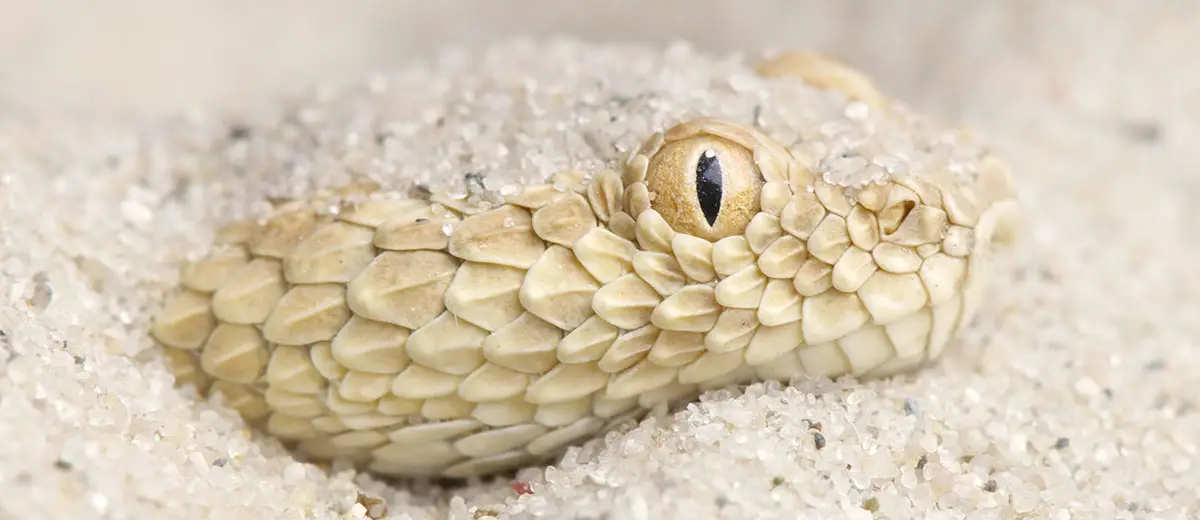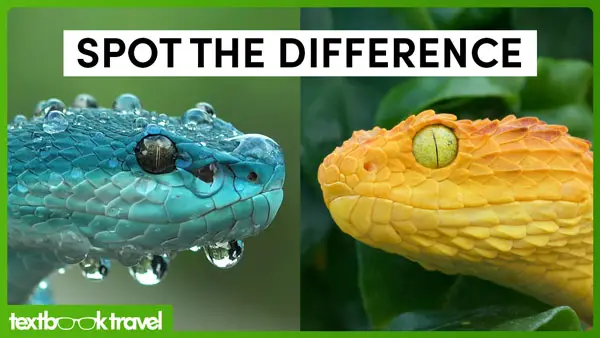100 Species of Snake Organised by Family and Subfamily
Snakes are one of the most colourful and diverse groups of animals on the planet, consisting of 18 families, over 500 genera and almost 4,000 species. In this fast-paced guide, we’ll explore 100 species of snake from constrictors such as boas and pythons to the highly venomous viper and elapid families, common snakes such as vine and rat snakes, and some of the most weird and wonderful species like the elephant trunk snake and the blind snake. Let’s dive in!
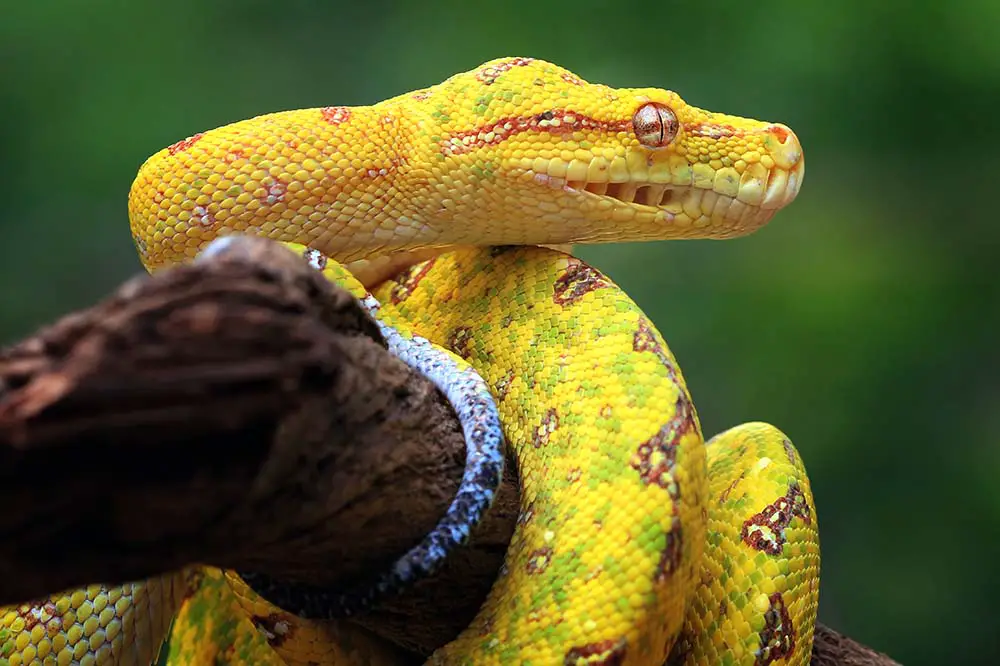

Left: Juvenile green tree python | Kurit Afshen / Shutterstock & Right: Sunda Island pit viper on Komodo Island, Indonesia | Yan Hidayat / Shutterstock
Contents
- Family: Boidae | Boas
- Green anaconda, Emerald tree boa & Javelin sand boa…
- Family: Tropidophiidae | Dwarf boas
- Panamanian dwarf boa
- Family: Pythonidae | Pythons
- Burmese python, Green tree python & Black-headed python…
- Family: Viperidae | Vipers
- Subfamily: Crotalinae | Pit vipers
- Eyelash pit viper, Beautiful pit viper & Western diamondback rattlesnake…
- Subfamily: Viperinae | True/Pitless vipers
- Rough-scaled bush viper, Many horned adder & Spider-tailed horned viper…
- Subfamily: Crotalinae | Pit vipers
- Family: Elapidae | Elapids
- Group: 7 x genera | Cobras
- King cobra, Red spitting cobra & Rinkhals…
- Group: 4 x genera | Coral snakes
- Eastern coral snake, Blue Malaysian coral snake…
- Group: 7 x genera | Sea snakes/kraits
- Banded sea krait & Yellow-bellied sea snake…
- Group: Other Elapids
- Black mamba, King brown, Desert death adder…
- Group: 7 x genera | Cobras
- Family: Colubridae | Typical snakes
- Subfamily: Natricinae
- San Francisco garter snake, Buff striped keelback & Diamondback water snake…
- Subfamily: Dipsadinae
- Western worm snake, Neo-tropical snail-eater & Giant false viper…
- Subfamily: Ahaetuliinae
- Oriental whip snake, Ornate flying snake & Beautiful bronzeback tree snake…
- Subfamily: Colubrinae
- Mangrove snake, Hondouran milk snake & Eastern indigo snake…
- Group: Rat snakes
- Japanese rat snake, Rhinoceros rat snake & Corn snake…
- Subfamily: Natricinae
- Remaining Families
- Madagascar leaf-nosed snake, Elephant trunk snake & Brahminy blind snake…
Family: Boidae | Boas
Boas are a family of large non-venomous snakes that kill by constriction. There are 5 sub-families of boa, the most famous of which are true boas found in Central and South America and the Caribbean. The holes in the side of their faces are heat-sensing organs known as pits, used to detect prey.
01 – Green anaconda | Eunectes murinus
The green anaconda is found in the Amazon and Orinoco basins and is the world’s heaviest snake, reportedly weighing up to 227 kg or 500 lb. Their name derives from a Latin word meaning “of mice” although they consume a much larger variety of prey.
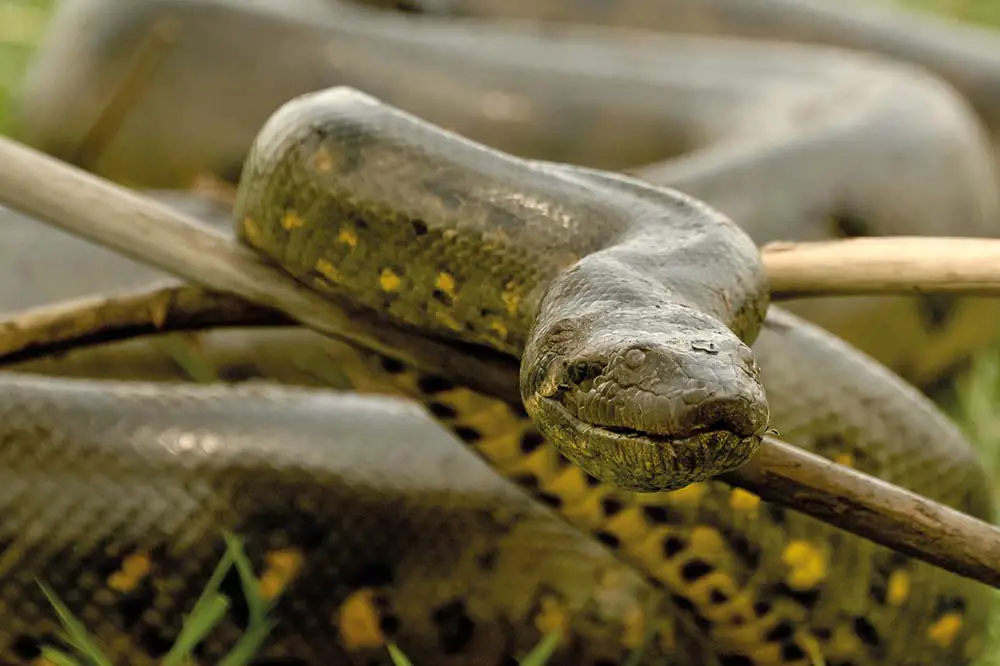
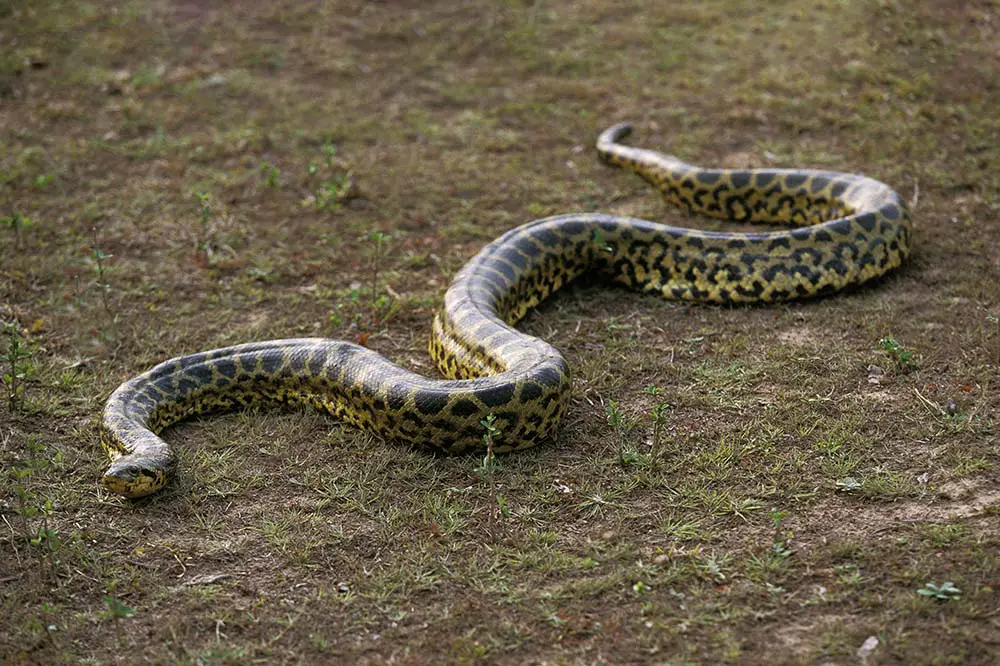
Left: Green anaconda | Wayak / Shutterstock & Right: Green anaconda, Pantanal, Brazil | Slowmotiongli / Shutterstock
02 – Common boa | Boa constrictor
The common boa or boa constrictor has a much larger range than the anaconda being found throughout much of South America. They have intricate camouflage and are also known as the red-tailed boa for the beautiful colour gradient on their tail.
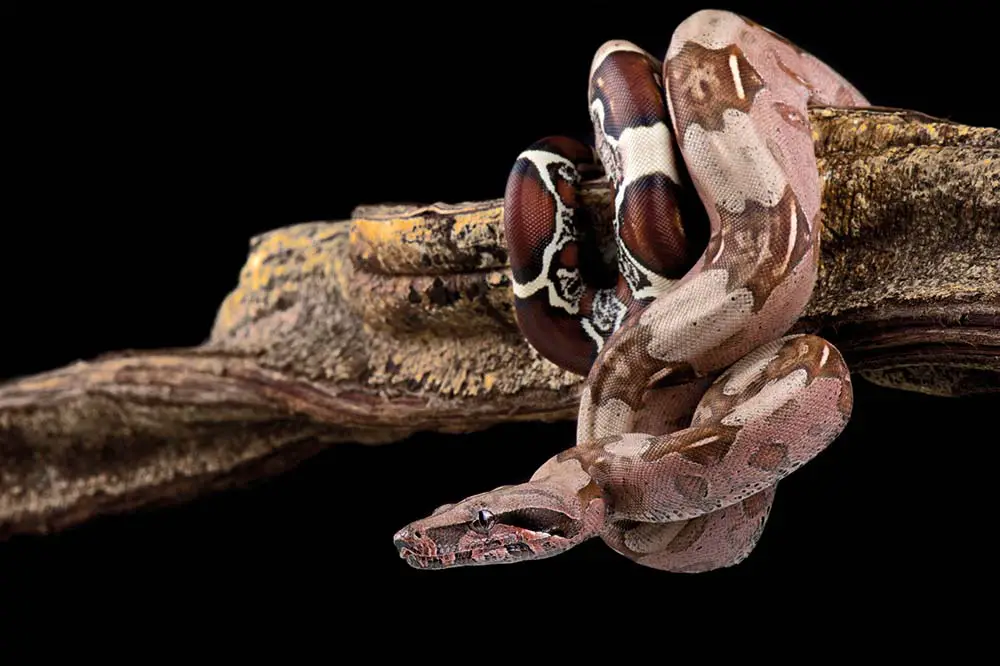
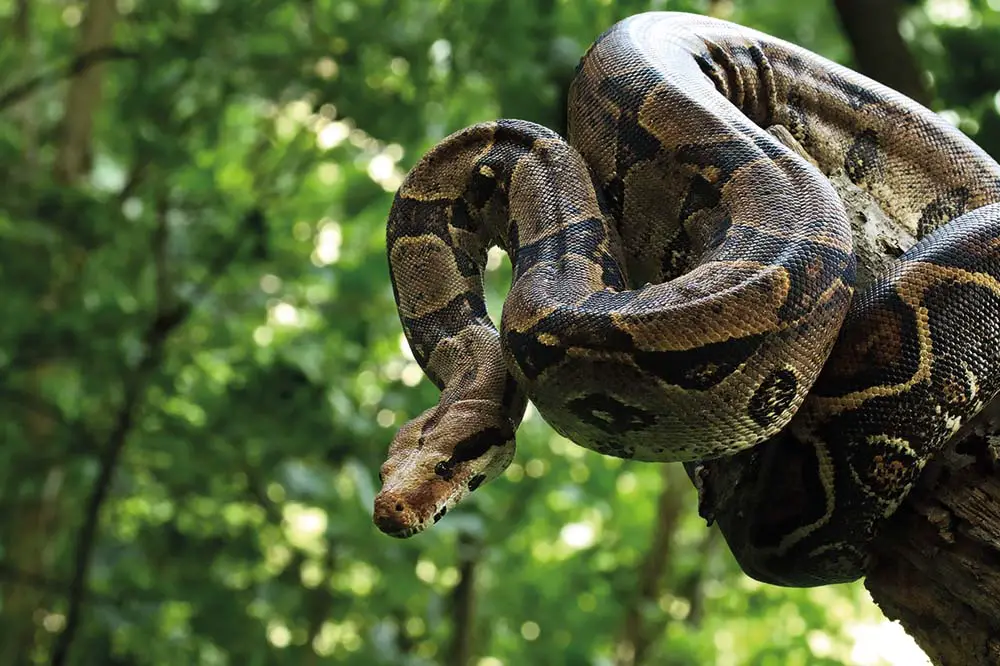
Left: Boa constrictor, Suriname locality | reptiles4all / Shutterstock & Right: The boa constrictor, also called the red-tailed boa or the common boa | Jan Hejda / Shutterstock
03 – Rainbow boa | Epicrates cenchria
Rainbow boas are typically much darker than the common boa, exhibiting a deep red hue and are named as such due to their iridescent sheen, giving their skin a rainbow-like reflection in certain light.

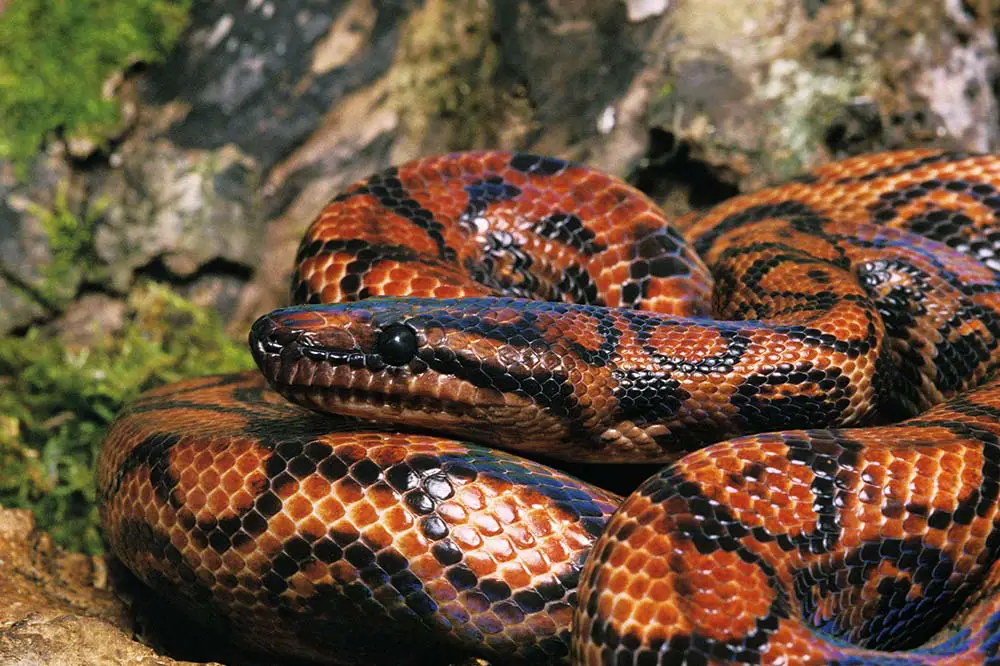
Left: Baby Brazilian rainbow boa aka the slender boa | Karel Bartik / Shutterstock & Right: Adult rainbow boa | slowmotiongli / Shutterstock
04 – Emerald tree boa | Corallus caninus
More colourful yet still is the emerald tree boa, which is part of a family of snakes called neotropical tree boas. Interestingly, juveniles start their lives in various shades of red and orange and then turn to emerald green after around 9-12 months, a process called ontogenetic colour change.

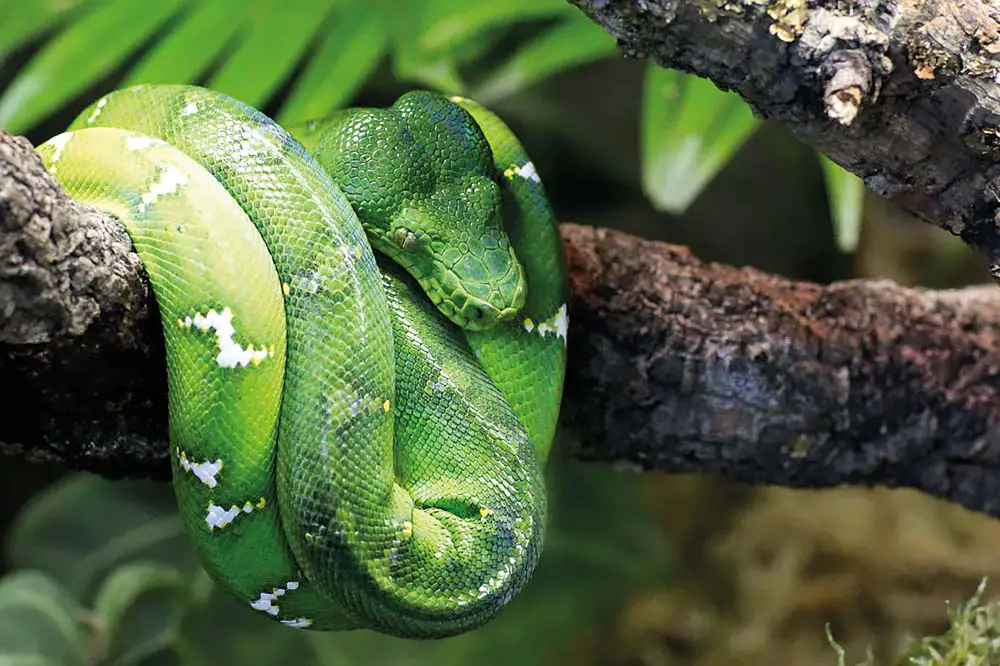
Left: Juvenile emerald tree boa | bluedog studio / Shutterstock & Right: Adult emerald tree boa | Linto Philip / Shutterstock
05 – Javelin sand boa | Eryx jaculus
A particularly odd-looking boa and the last in this family that we’ll discuss, the javelin sand boa is found in Europe, the Middle East and North Africa. They are much smaller than true boas, only growing to around 80 cm in length.
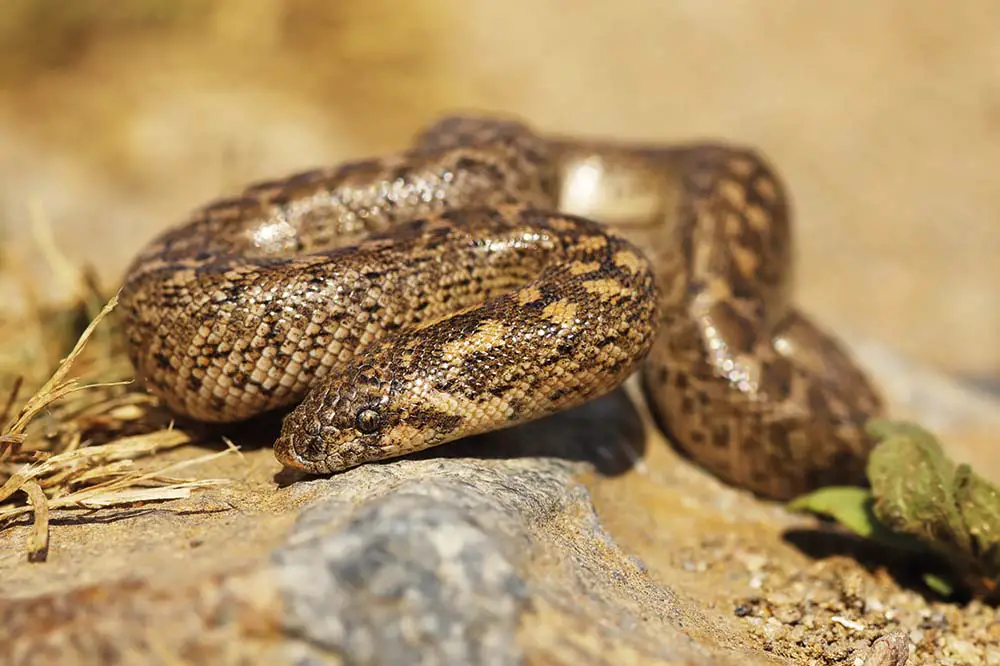

Left: Closeup of juvenile javelin sand boa | Taviphoto / Shutterstock & Right: Javelin sand boa (Eryx jaculus) | Edvard Mizsei / Shutterstock
Family: Tropidophiidae | Dwarf boas
06 – Panamanian dwarf boa | Ungaliophis panamensis
Dwarf boas are a separate family of snakes also known as thunder snakes containing two genera and 36 species. The Panamanian dwarf boa is found in Nicaragua, Costa Rica, Panama, and Colombia and grows up to around 30-60 cm in length.


Left & Right: Panamanian dwarf boa | Milan Zygmunt / Shutterstock
Family: Pythonidae | Pythons
Pythons are very similar to boas, containing some of the largest and most colourful snakes in the world. This family is made up of 10 genera including “true” pythons, reticulated pythons and tree pythons. They are found in sub-Saharan Africa, much of Asia and Australia.
07 – Burmese python | Python bivittatus
The Burmese python is the second heaviest snake in the world, weighing just north of 180 kg or 400 lbs. Although they are now an invasive species in Florida, they live mainly in Southeast Asia and are particularly stunning in their albino form, displaying yellow and white skin.
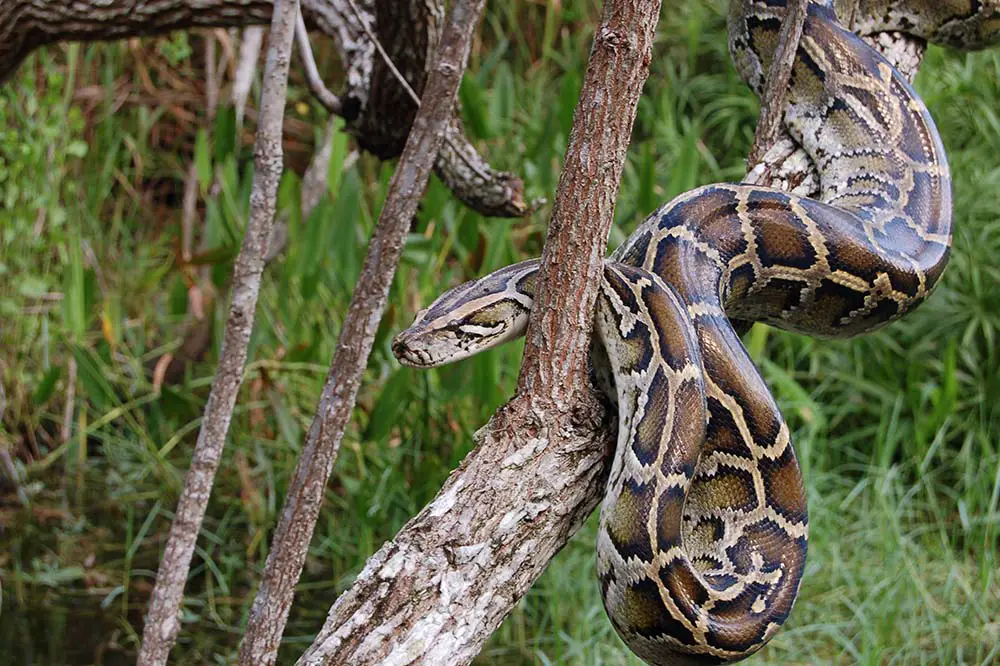
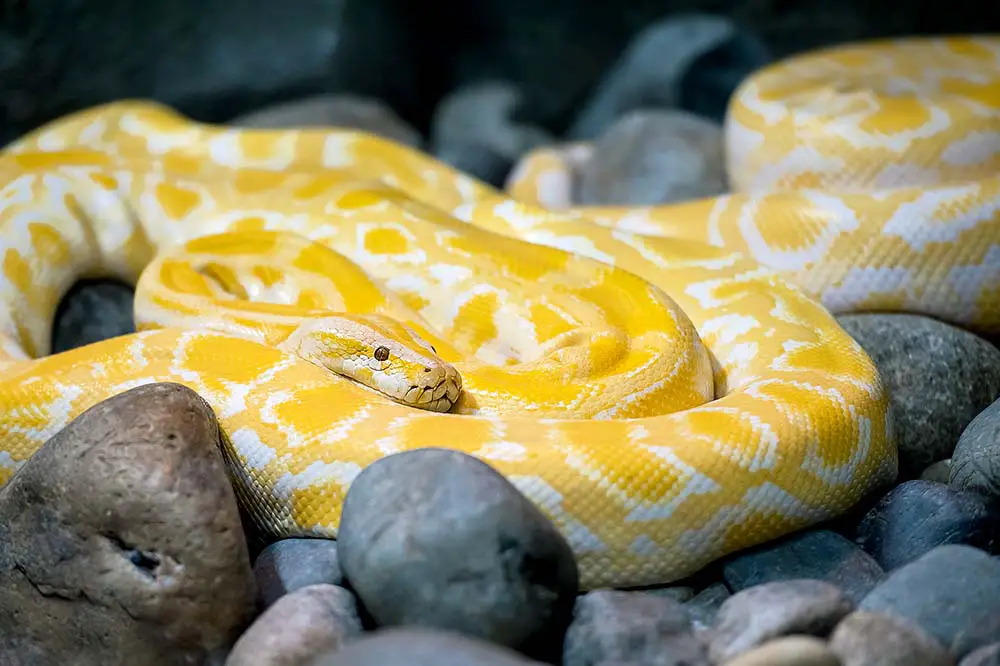
Left: Burmese python in the Everglades | Heiko Kiera / Shutterstock & Right: Albino Burmese python | PaniYani / Shutterstock
08 – Ball python | Python regius
The ball or royal python is native to west and central Africa and usually displays fairly standard colouring. They can be bred to exhibit a wide variety of colour morphs including the butter ball python, the pied royal python and the entirely white blue-eyed leucistic ball python.


Left: Butter ball python | bluedog studio / Shutterstock & Right: White leucistic ball python | Mark Kostich / Shutterstock
09 – Reticulated python | Malayopython reticulatus
The reticulated python is the longest snake in the world, reportedly measuring up to 10 meters or over 30ft in length. The word reticulated means constructed, arranged, or marked like a net or network, referencing the intricate pattern on this species’ skin.
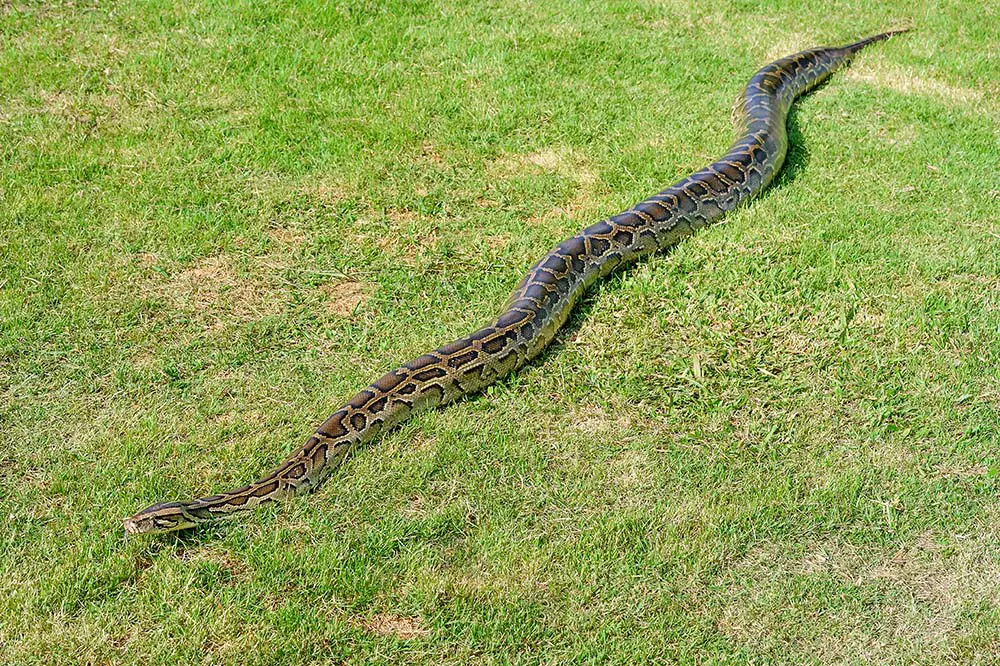
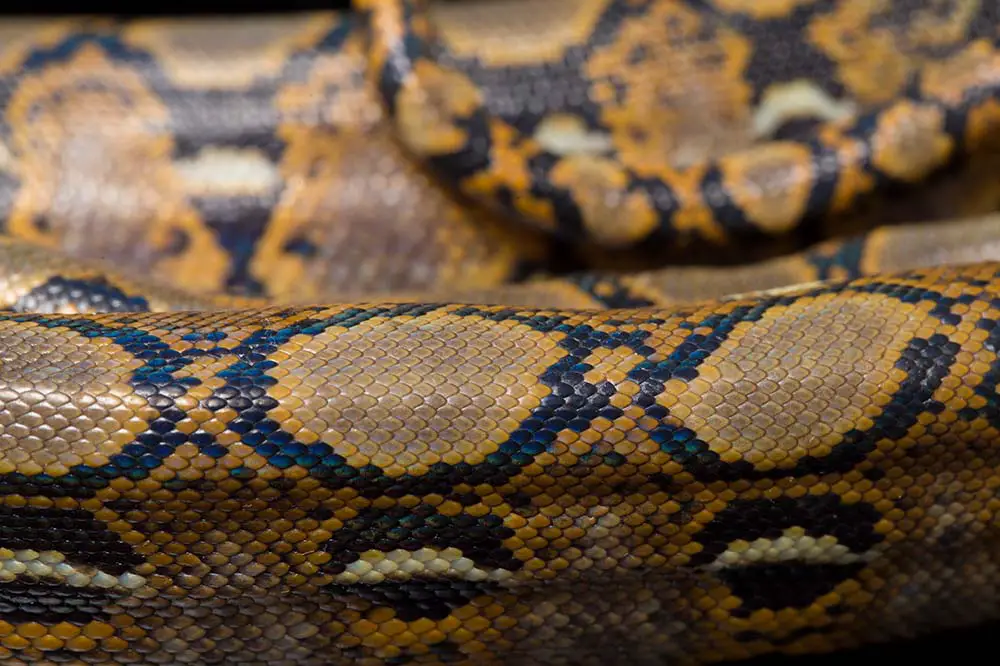
Left: Reticulated Python | Yatra / Shutterstock & Right: The skin of a reticulated python | Dwi putra stock / Shutterstock
10 – Green tree python | Morelia viridis
The spectacular green tree python is pythonidae’s answer to the emerald tree boa. In this particular species, juveniles can be both yellow in colour or a deep orange-red before turning green at around 1 year old.
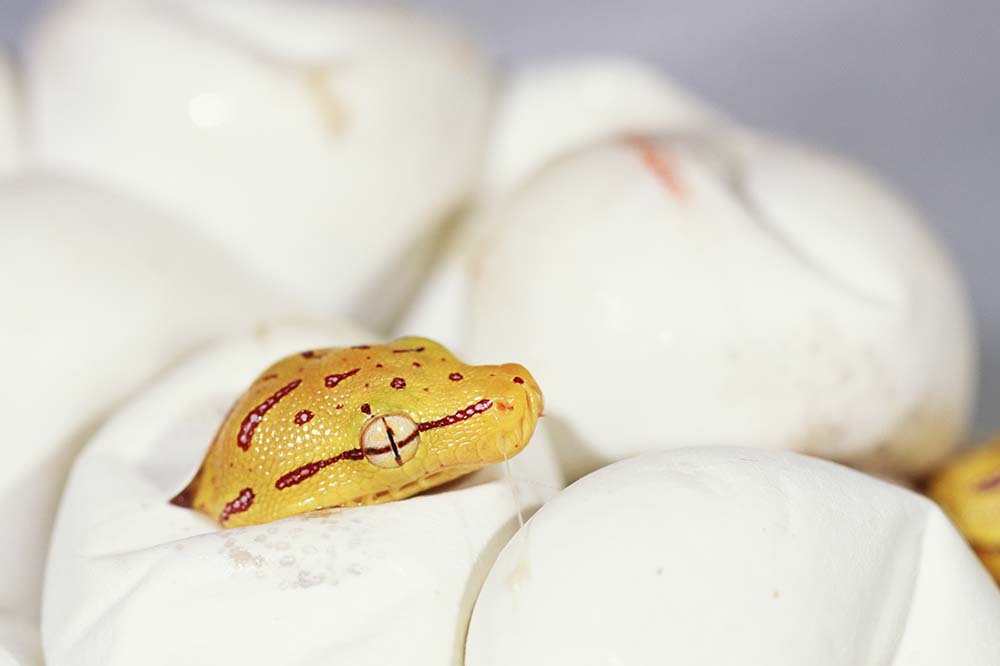

Left: Green tree python hatching out of its egg | Paul Tessier / Shutterstock & Right: Green tree python | Henner Damke / Shutterstock
11 – Black-headed python | Aspidites melanocephalus
The last species we’ll discuss in the python family, the black-headed python is a monotypic species endemic to Australia. They are found in tropical regions and eat many types of reptile, including other snakes, along with a variety of small mammals.
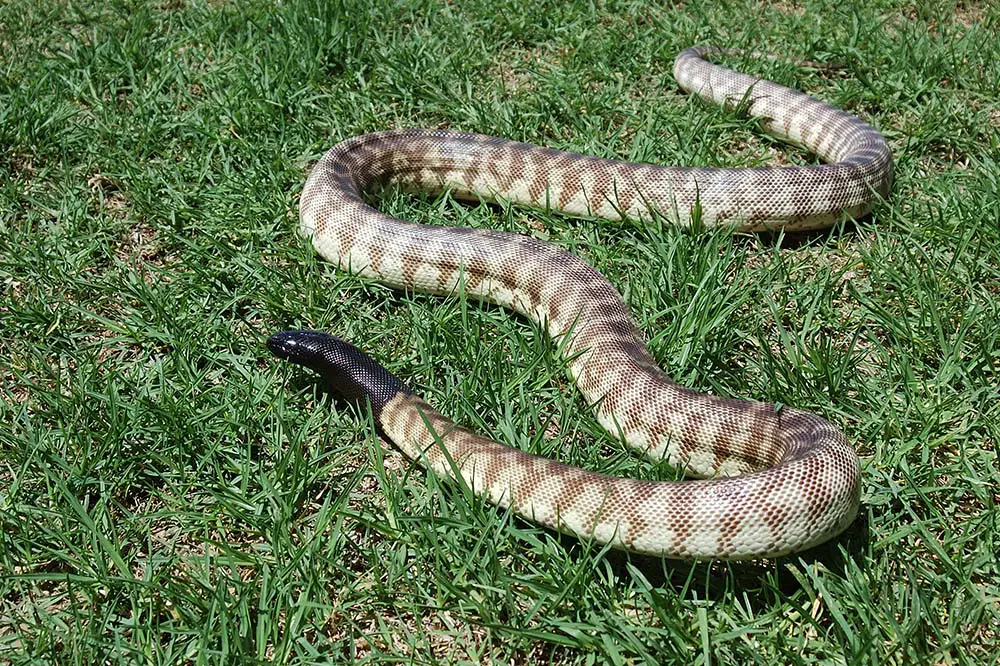
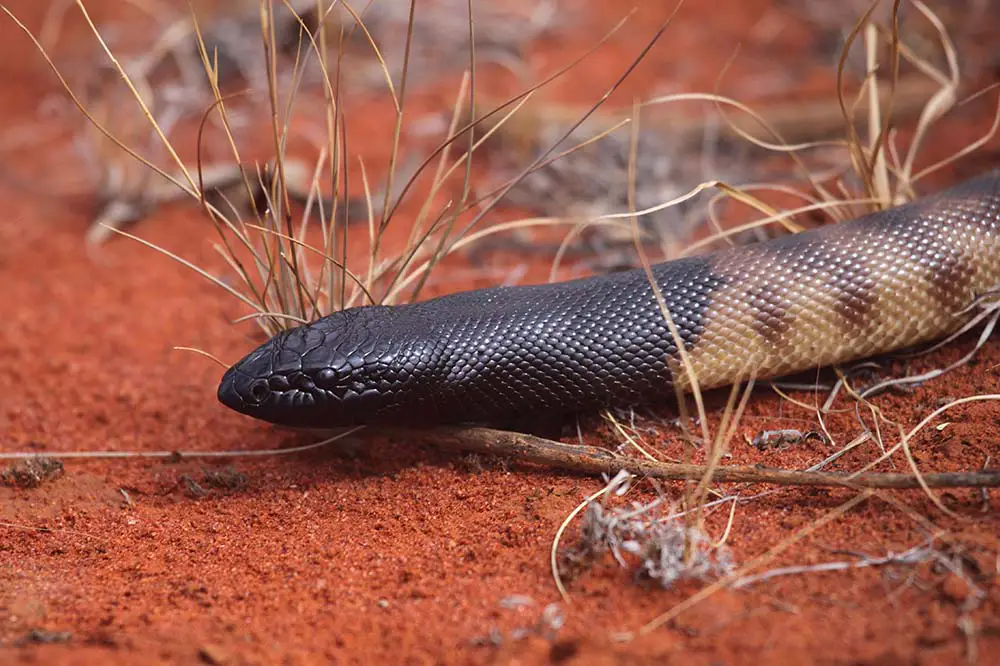
Left: Black-headed python | Lakeview Images / Shutterstock & Right: Black-headed Python in Australia’s desert | Chris Watson / Shutterstock
Family: Viperidae | Vipers
Vipers are a group of venomous snakes, much smaller than boas, who have long fangs used to inject venom into their prey. Vipers’ venom is hemotoxic, which is less deadly than the neurotoxic venom used by elapids that we’ll discuss later on.
Subfamily: Crotalinae | Pit vipers
Pit Vipers are the largest subfamily of vipers, which include lanceheads, rattlesnakes and moccasins, and are distinguished by the presence of their pits, which are found between the nostril and eye on each side of their face.
12 – Eyelash pit viper | Bothriechis schlegelii
The eyelash pit viper is one of the most colourful in this family and can be found in a bright yellow to shades of green and white. They are known as such for a row of superciliary scales above their eyes giving the appearance of eyelashes, which protect them in their arboreal environment.

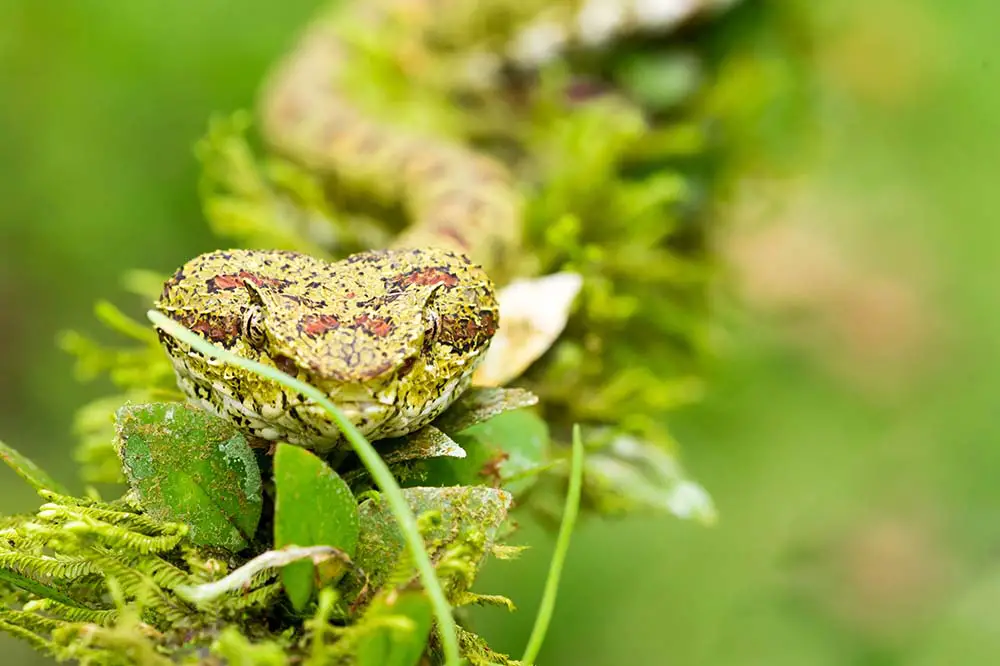
Left: Yellow Eyelash Pit Viper | Roy H / Shutterstock & Right: Eyelash Pit Viper in Costa Rica | Honesttraveller / Shutterstock
13 – Fer-de-lance | Bothrops atrox
The common lancehead otherwise known as the fer-de-lance has similar colouration to a boa or python and are found in central and South America. They are one of the most venomous of the viper family, a weapon they use to hunt rodents in banana and coffee plantations.
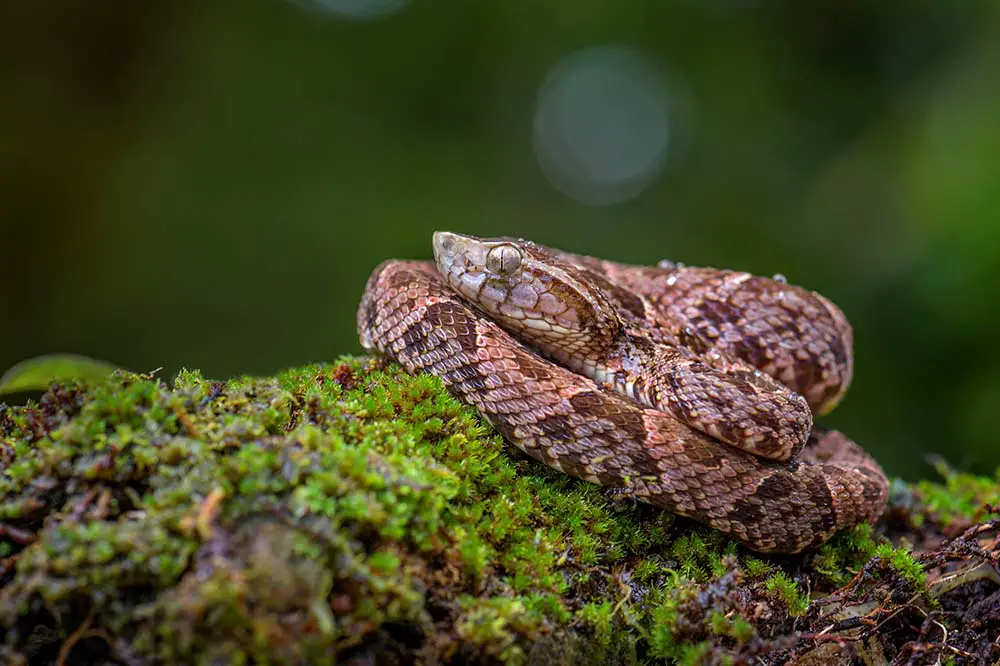

Left: A tiny fer-de-lance | David Havel / Shutterstock & Right: Fer-de-lance on a tree fungus | Ondrej Prosicky / Shutterstock
14 – Sunda Island pit viper | Trimeresurus insularis
The Sunda Island pit viper is the first of three colourful vipers that we’ll explore in the Asian lancehead genus. They can be found in a variety of colours although by far the most striking variation has a blue-green skin that is rare to find in other species.
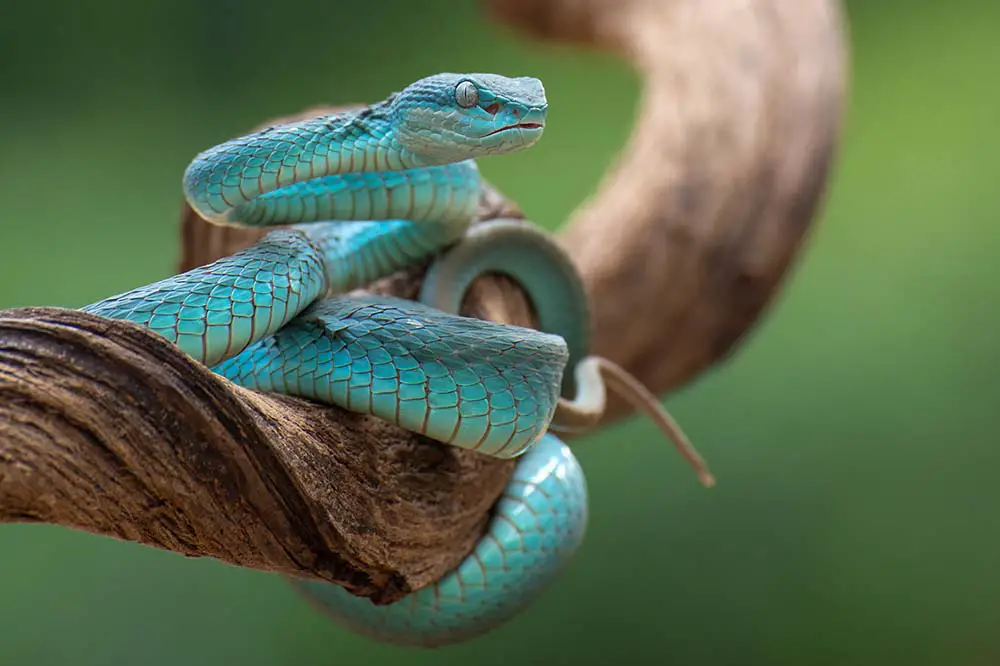
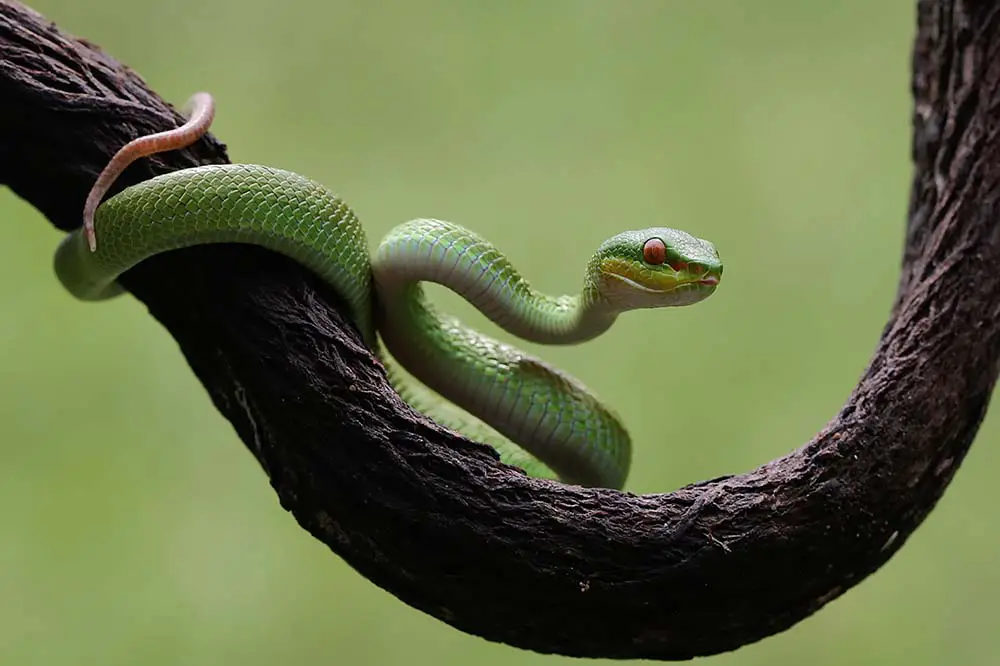
Left: Sunda Island pit viper | Cavan-Images / Shutterstock & Right: A baby Lesser Sunda pit viper I Wayan Sumatika / Shutterstock
15 – McGregor’s pit viper | Trimeresurus mcgregori
The McGregor’s pit viper is native to the Batanes Islands of the Philippines and can be found in an entirely white variation. The species is named after Richard Crittenden McGregor who survived being bitten while collecting the type specimen.

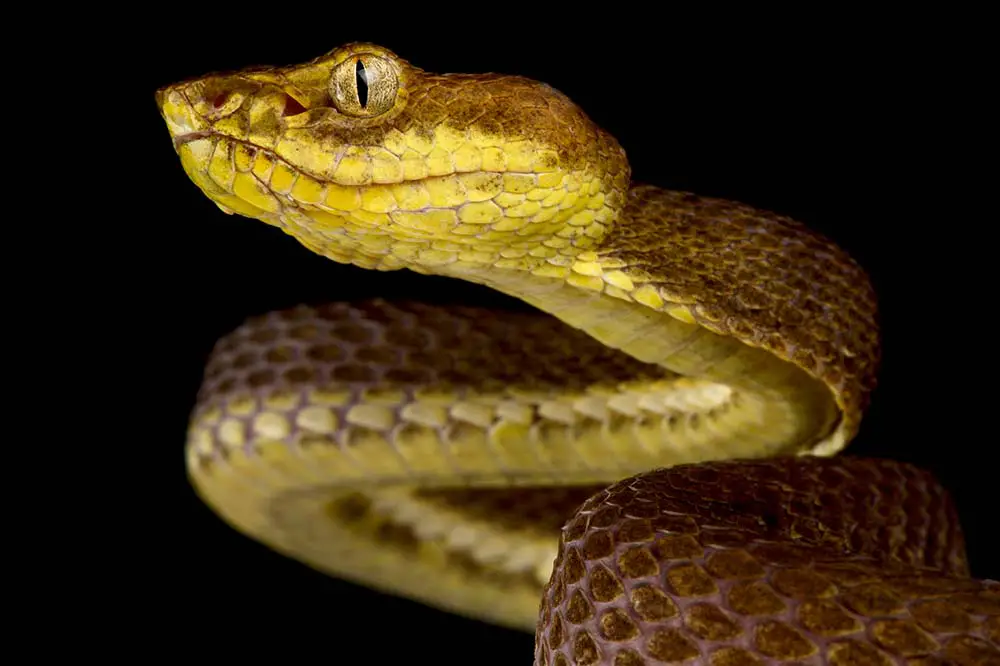
Left: A white McGregor’s pit viper | reptiles4all / Shutterstock & Right: Yellow McGregor’s pit viper | reptiles4all / Shutterstock
16 – Beautiful pit viper | Trimeresurus venustus
The brown-spotted pit viper also known as the beautiful pit viper is one of the most aptly named snakes in the world. They display a chequered green and brown skin with turquoise highlights and are found in southern Thailand.


Left: Beautiful pit viper in southern Thailand | Nenad Preradovic / Shutterstock & Right: Beautiful pit viper in Phuket | Binturong-tonoscarpe / Shutterstock
17 – Western diamondback rattlesnake | Crotalus atrox
Diamondback rattlesnakes are one of the heaviest venomous snakes in the world weighing up to 6.7 kg or 15 lbs. They are a type of pit viper who exhibit a rattle to warn predators, which they will use before striking. The Western Diamondback Rattlesnake is found in the southern US and Mexico.
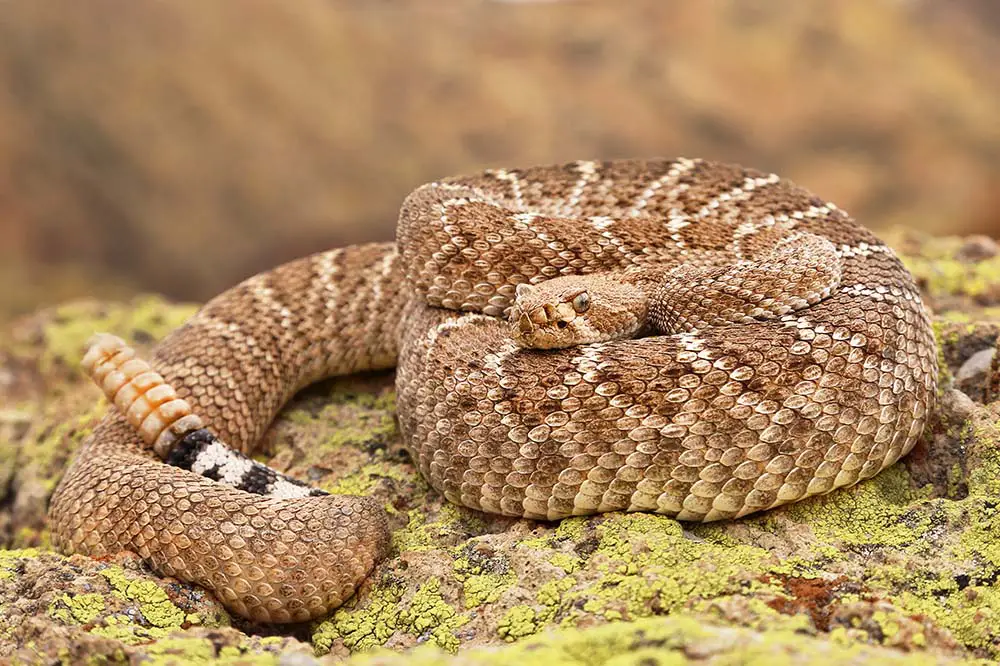

Left: A coiled up Western Diamondback Rattlesnake in Arizona | Ryan M. Bolton / Shutterstock & Right: Closeup of a Western Diamondback Rattlesnake | Audrey Snider-Bell / Shutterstock
18 – Rock rattlesnake | Crotalus lepidus
The rock rattlesnake is much smaller and has lighter skin. There are four known subspecies including the banded rock rattlesnake and the mottled rock rattlesnake who use their patterned skin for camouflage.

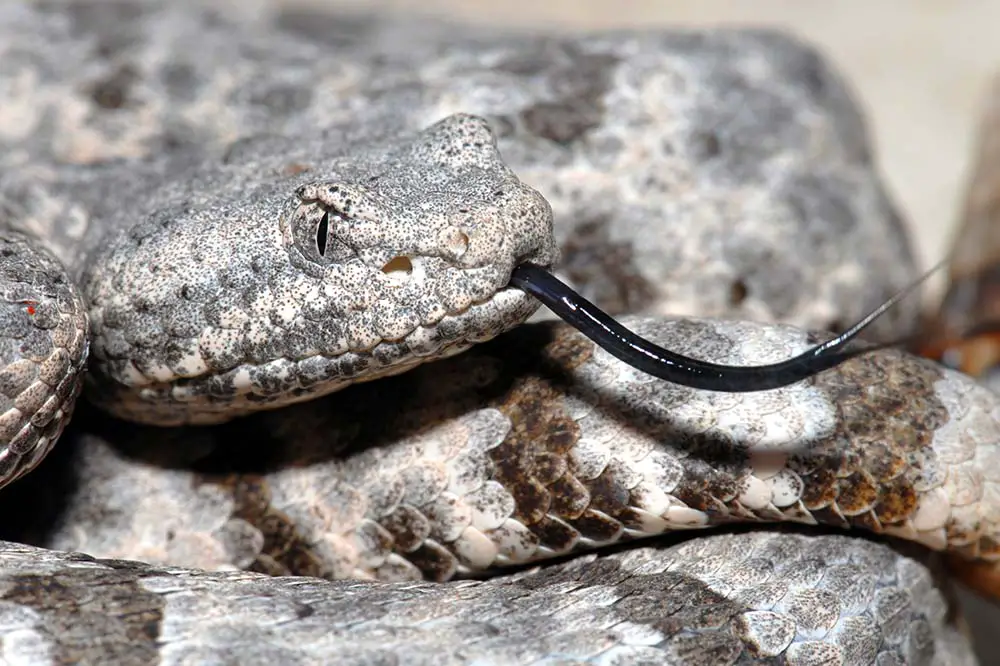
Left: Banded rock rattlesnake | Matt Jeppson / Shutterstock & Right: Mottled rock rattlesnake | Rusty Dodson / Shutterstock
19 – Eastern copperhead | Agkistrodon contortrix
The Eastern copperhead is the first of two American moccasins that we’ll look at. Its Latin name contortrix comes from the Latin contortus which means twisted, intricate or complex, referring to the bands of colour on its skin that contort in width.
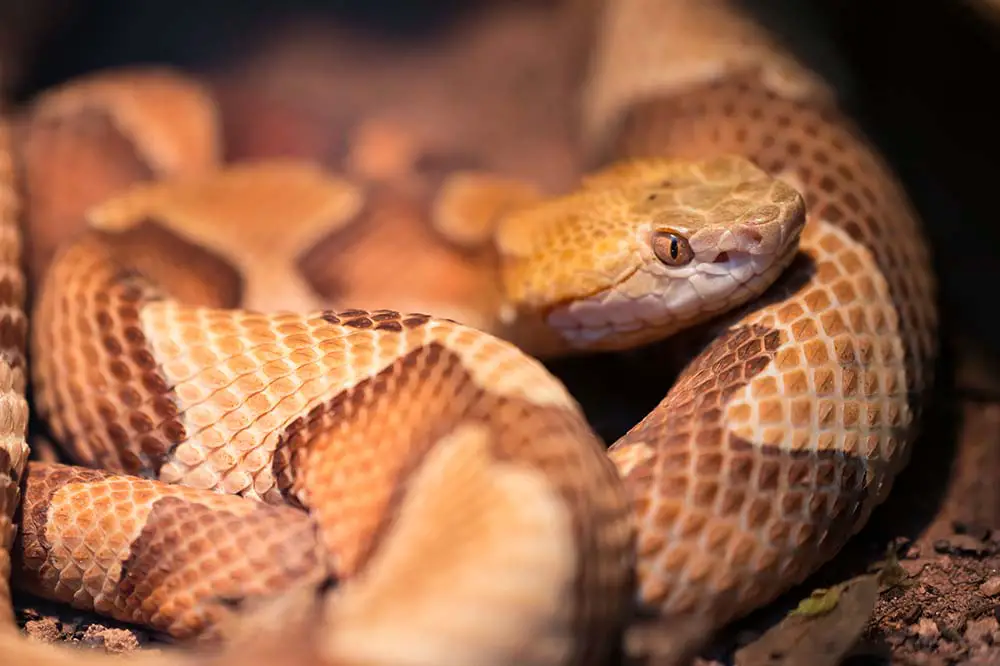
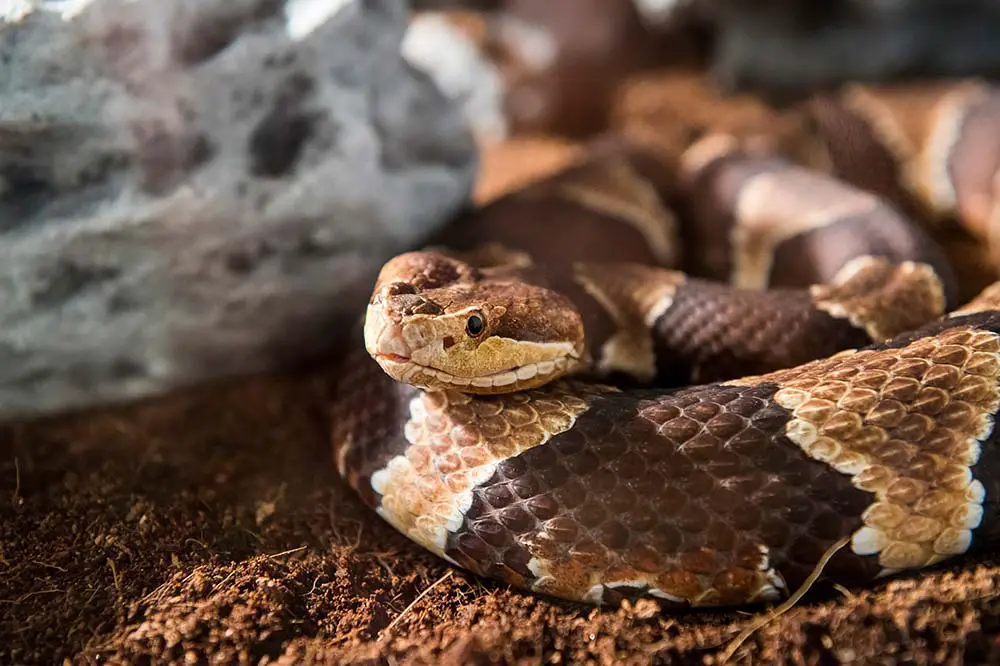
Left: Copperhead | Fabio Lotti / Shutterstock & Copperhead viper (Agkistrodon contortrix) | Giannis Papanikos / Shutterstock
20 – Cantil | Agkistrodon bilineatus
Cantils are another species of moccasin found in Mexico and Central America. They are around 60 cm or 24 inches in length and although they lack a rattle, they also vibrate their tails when threatened.
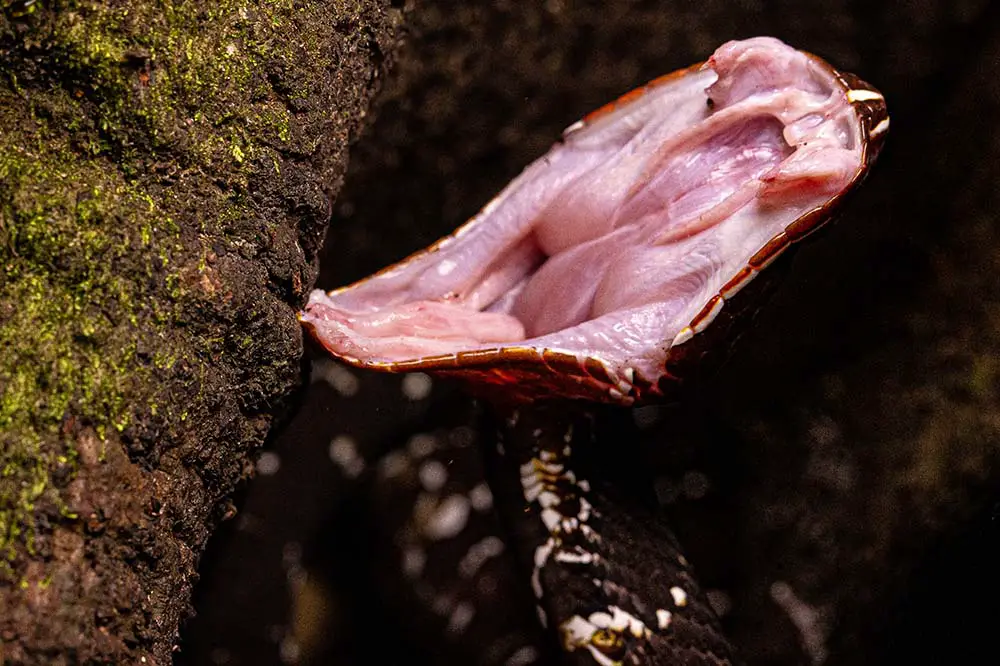

Left: The mouth of a Cantil | Rodolfo Ayala Plata / Shutterstock & Right: Mexican moccasin or Cantil | Eduardo Estellez / Shutterstock
Subfamily: Viperinae | True/Pitless vipers
True or pitless vipers are distinguished by a lack of pits, the heat-sensing organ present in other members of the viper family. This family is often referred to as true adders, containing the day adder, night adder and puff adder genera.
21 – Rough-scaled bush viper | Atheris hispida
The Rough-scaled bush viper also known as the hairy bush viper is very unique, exhibiting raised dorsal scales that give it an almost dragon-like appearance. They are found in Central and East Africa in the Congo, Uganda, Kenya and Tanzania.
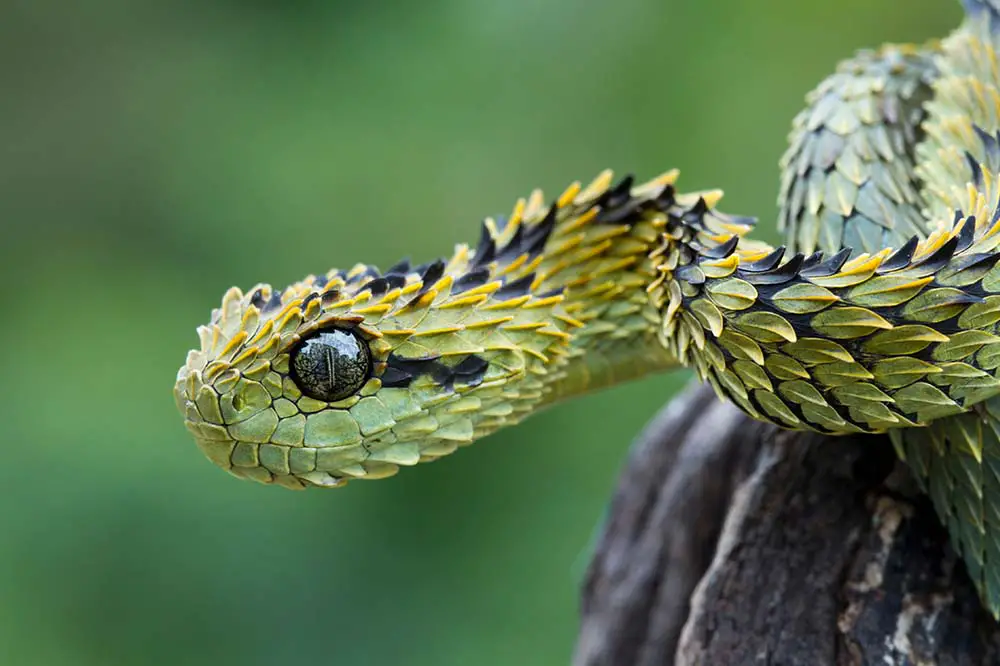

Left: Close up of a hairy bush viper & Right: A hairy bush viper in the rainforest | Mark Kostich / Shutterstock
22 – Variable bush viper | Atheris squamigera
The green or variable bush viper might just be the most colourful snake on this list. They are quite small with an average total length of 60 cm or 24 inches and can be found in a wide range of colours from green, yellow and reddish-orange to slate grey or black.

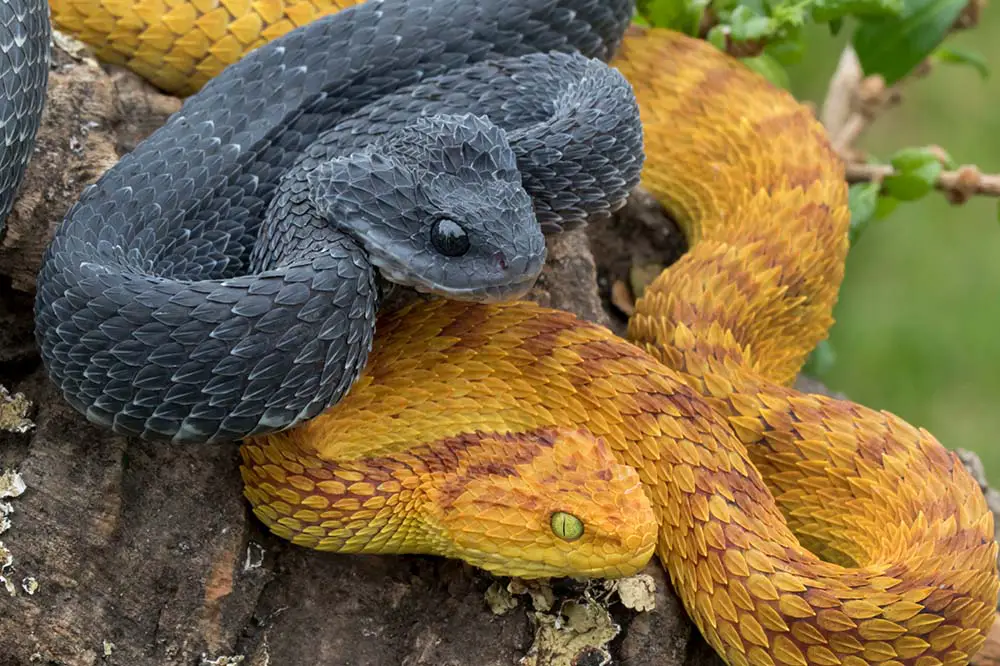
Left: Variable bush viper in its orange phase & Right: Two variable bush vipers | Mark Kostich / Shutterstock
23 – Many horned adder | Bitis cornuta
The many horned adder is a puff adder found in rocky desert areas in Southern Africa. Their name derives from the 2-5 raised scales above their eyes which give them a horned-like appearance not too dissimilar from the lashes of the eye-lash viper previously discussed.

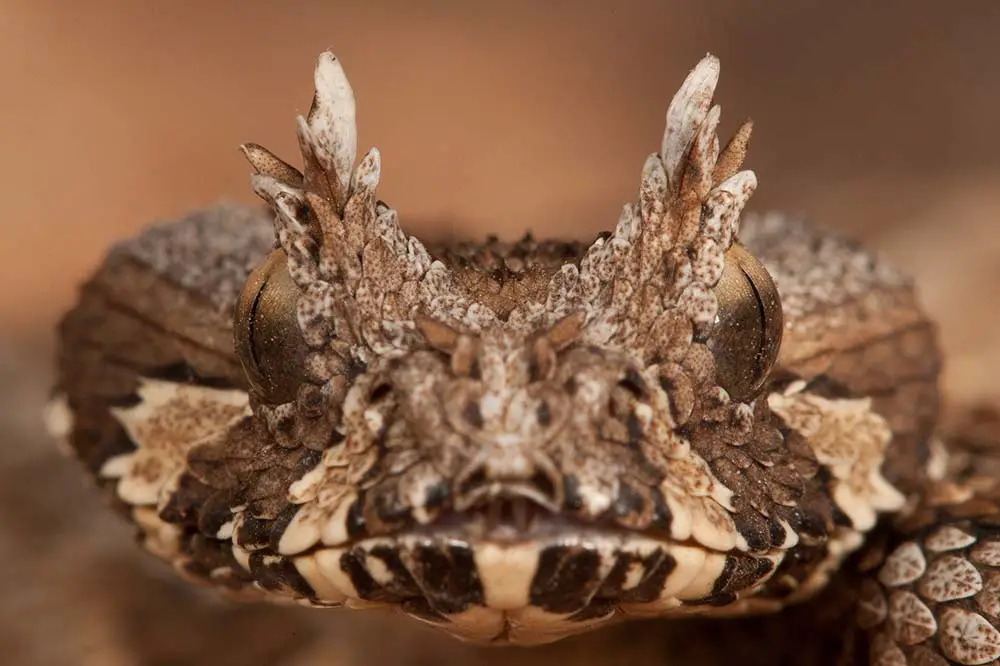
Left: Many-horned adder from Springbok, Northern Cape | Willem Van Zyl / Shutterstock & The many-horned adder | Andre Coetzer / Shutterstock
24 – Desert horned viper | Cerastes cerastes
The desert horned viper lives on the other side of the continent in Northern Africa and is also found in the Middle East. Instead of multiple scales, their horns consist of a single scale, which makes them easily distinguishable from other species in their genus.

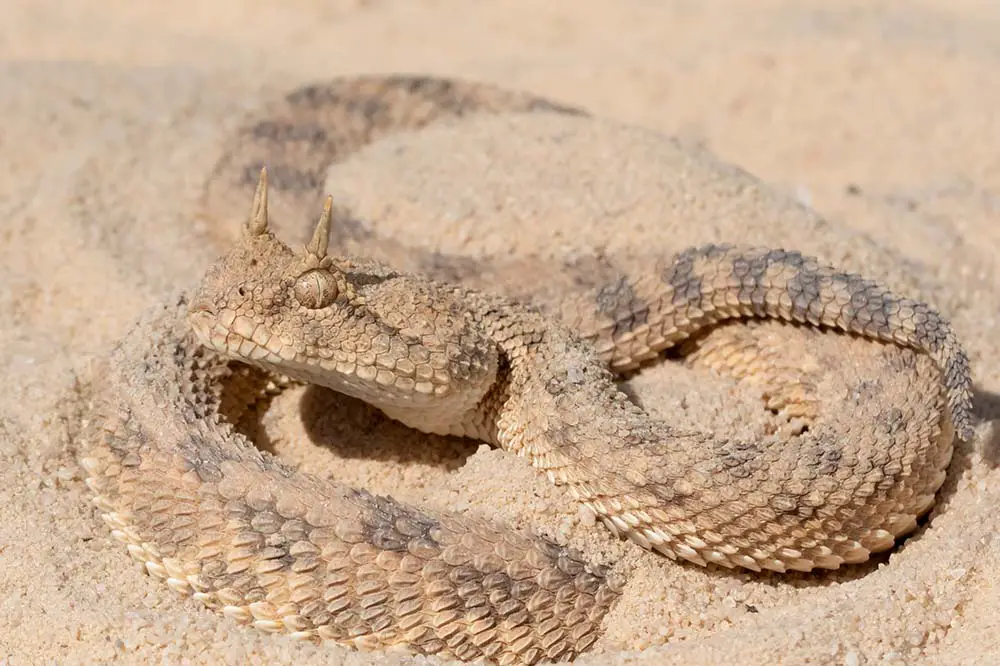
Left: Desert horned viper | Horia Bogdan / Shutterstock & Right: Desert horned viper in the sand | Mark Kostich | Shutterstock
25 – Spider-tailed horned viper | Pseudocerastes urarachnoides
The spider-tailed horned viper is the last viper we’ll cover; they are incredibly unique and are found only in a small area in western Iran. They have a spider-like tip to the tail, which they wave around to lure insectivorous birds into the range of their bite.
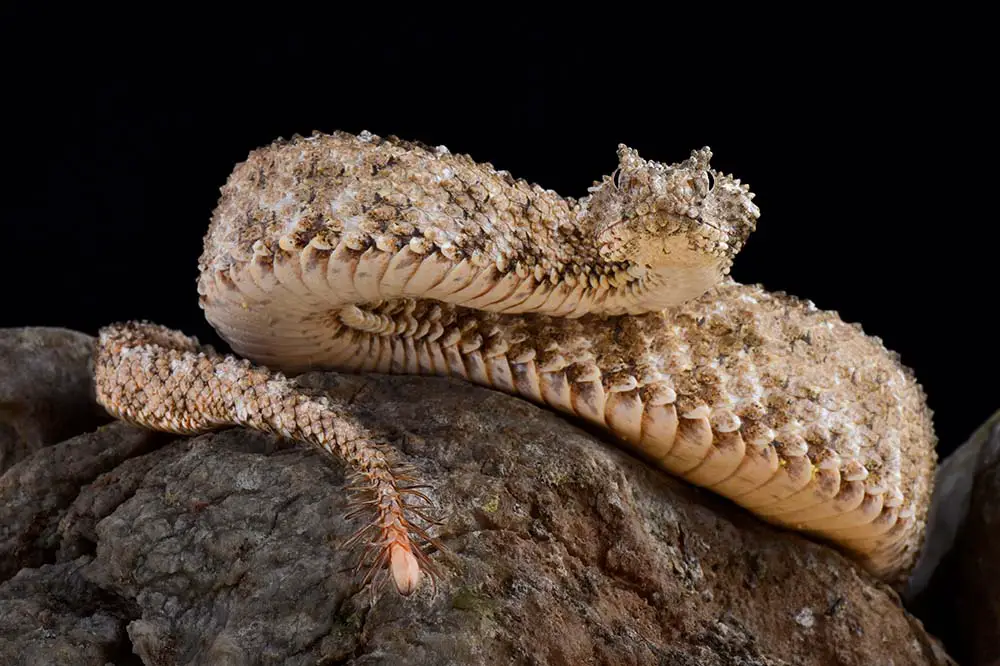
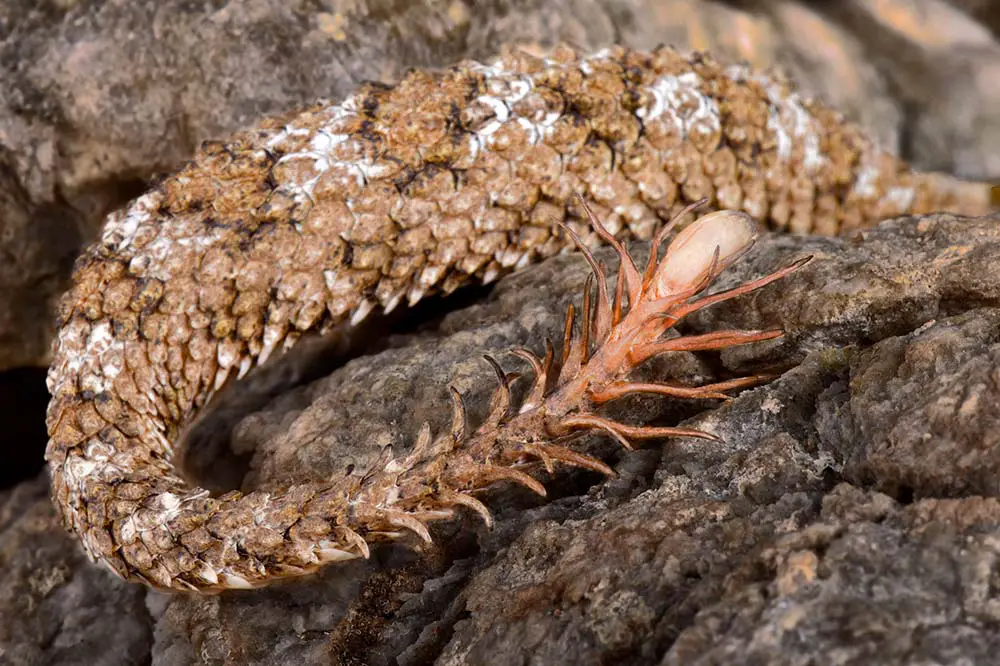
Left: The spider-tailed horned viper & Right: Close up of a spider-tailed horned viper’s tail | reptiles4all / Shutterstock
Family: Elapidae | Elapids
Elapids are the most venomous snakes on the planet. This family contains both terrestrial and aquatic snakes and, unlike the viper family who enclose their fangs in a sheath, the fangs of elapids are permanently erect and secrete powerful neurotoxins which attack nerve tissue. Terrifying!
Group: 7 x genera | Cobras
Cobra usually refers to a single genus containing 36 species, Naja, but can also refer to a group of 7 genera, the rest of which only contain 1-2 species including the King cobra, shield nose cobras and tree cobras.
26 – King cobra | Ophiophagus hannah
The king cobra is one of the most well-known snakes on the planet. It is not actually part of the cobra genus and is instead contained in its own monotypic genus. Furthermore, recent DNA analysis has shown that there may actually be multiple species of king cobra.


Left: A beautiful King cobra | Heiko Kiera / Shutterstock & Right: An erect King cobra in India | Mufti Adi Utomo / Shutterstock
27 – Indian cobra | Naja naja
The Indian cobra is the first of three true cobras that we’ll look at. The species plays an important role in Indian mythology and culture but is part of the “big 4” snakes that inflict the most bites on the Indian Subcontinent.


Left: Indian cobra | Guillermo Pis Gonzalez / Shutterstock & Right: Close view of Indian cobra | RealityImages / Shutterstock
28 – Samar cobra | Naja samarensis
The Samar cobra is a particularly colourful cobra native to a few small islands in the Philippines. They prey upon small rodents and reptiles and have a beautiful black and yellow skin that make them easily recognisable from other cobras.
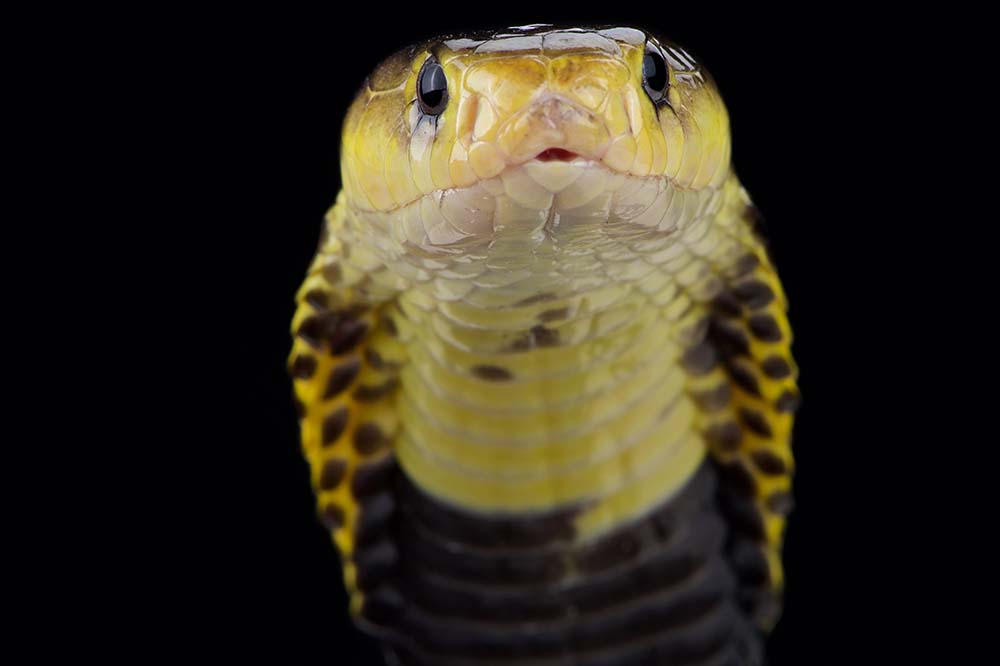
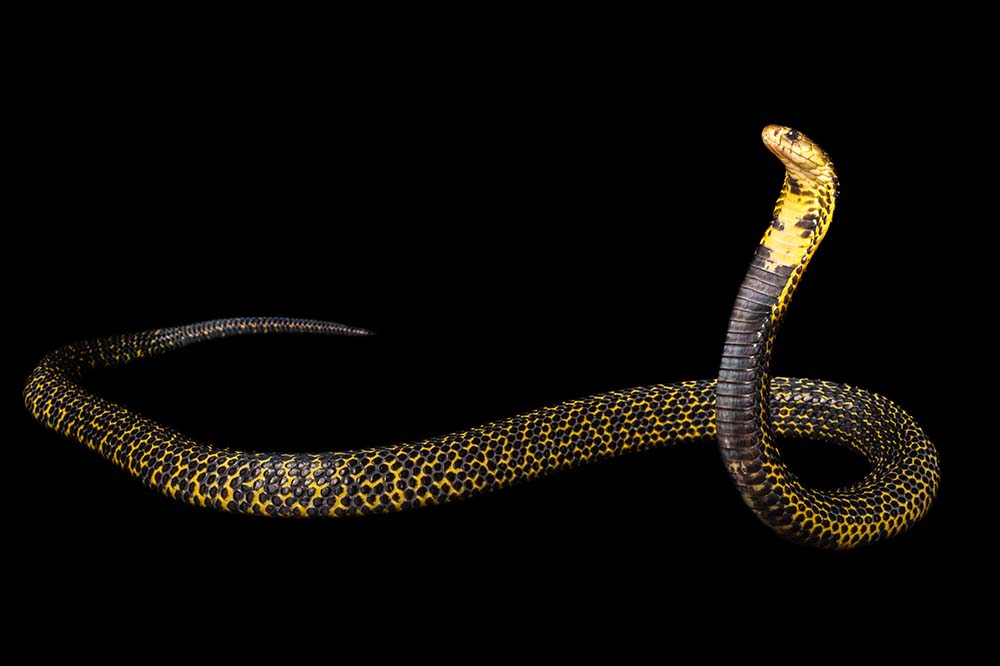
Left: Close up of a samar spitting cobra | reptiles4all / Shutterstock & Right: Samar spitting cobra | Sibons photography / Shutterstock
29 – Red spitting cobra | Naja pallida
The red spitting cobra is another very unique cobra exhibiting dark red scales and a black band around its neck. They are found mainly in East Africa and their venom is a combination of neurotoxic and cytotoxic which affects cell function.

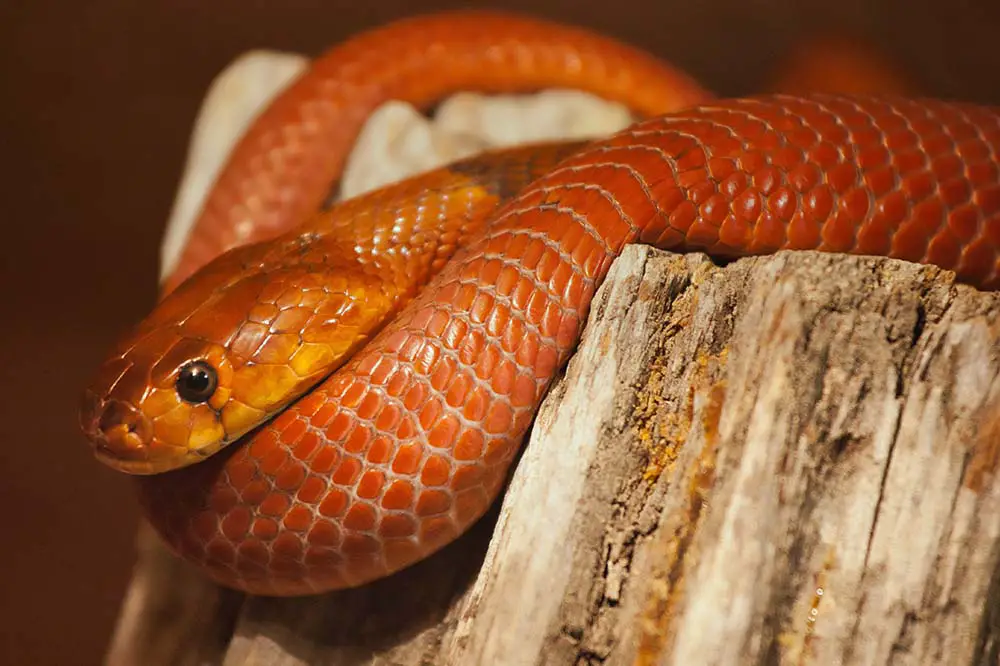
Left: A attacking red spitting cobra | reptiles4all / Shutterstock & Right: Red spitting cobra lying on a tree | M. Schauer / Shutterstock
30 – Rinkhals | Hemachatus haemachatus
The rinkhals or ring-necked spitting cobra is another species of cobra contained within its own monotypic genus—those containing a single species. They can be both chequered and almost entirely black but always with a white ring towards the top of the body.


Left: Black ringhals spitting cobra side view | Andre Coetzer / Shutterstock & Right: Rinkhals striking a pose | Cormac Price / Shutterstock
31 – Cape coral snake | Aspidelaps lubricus
The cape coral snake is part of a genus of snakes commonly known as shield-nosed cobras or coral cobras. There are two subspecies, both of which are found in Southern Africa. They bridge the gap nicely between the cobras of this section and the coral snakes of the next.
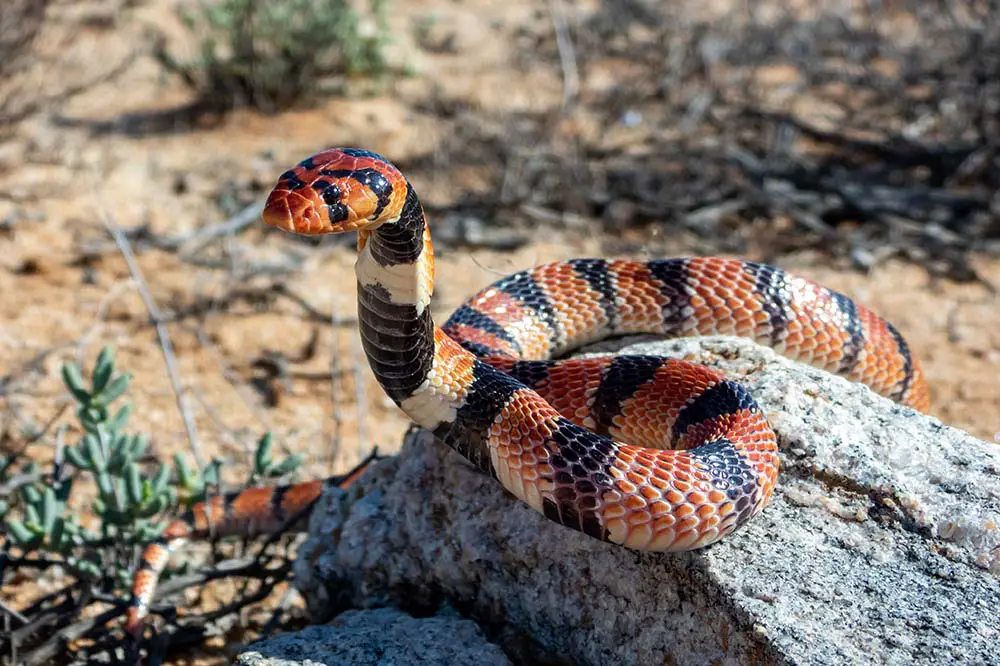

Left: Cape coral snake from Springbok, Northern Cape | Willem Van Zyl / Shutterstock & Right: Coral shield cobra | Willem Van Zyl / Shutterstock
Group: 4 x genera | Coral snakes
Coral snakes are a group of snakes made up of old world and new world snakes. Old world coral snakes are made up of three genera and exist in Europe, Asia and Africa. New world coral snakes are made up of two genera and exist in the Americas.
32 – Eastern coral snake | Micrurus fulvius
The eastern coral snake is also known as the candy-stick snake, the coral adder or the American cobra but is not closely related to other cobras apart from being in the elapid family. They are relatively small, rarely surpassing 80 cm or 31 inches in length.
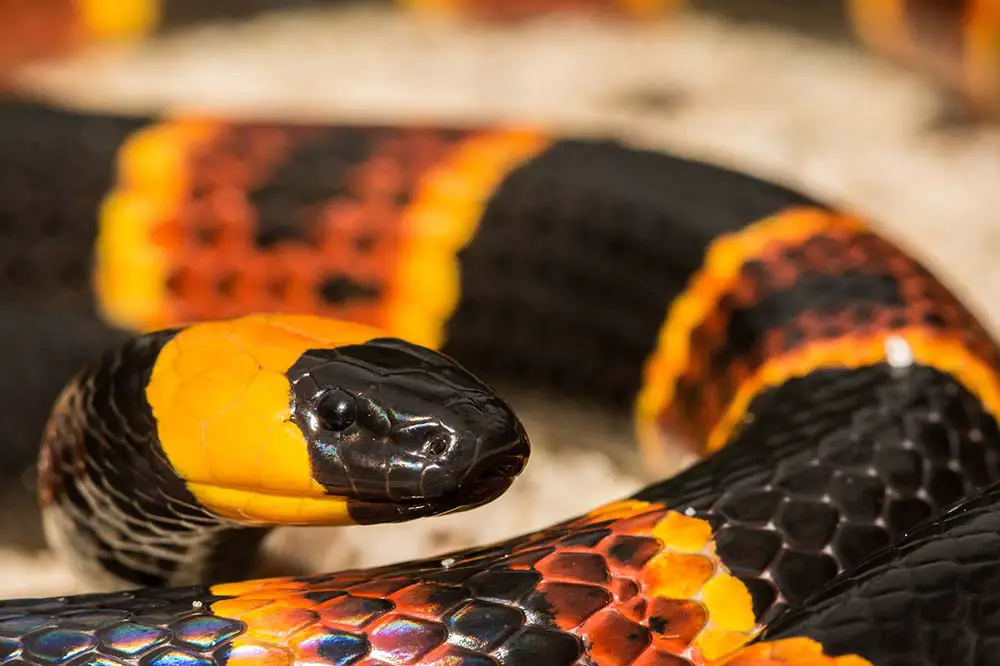
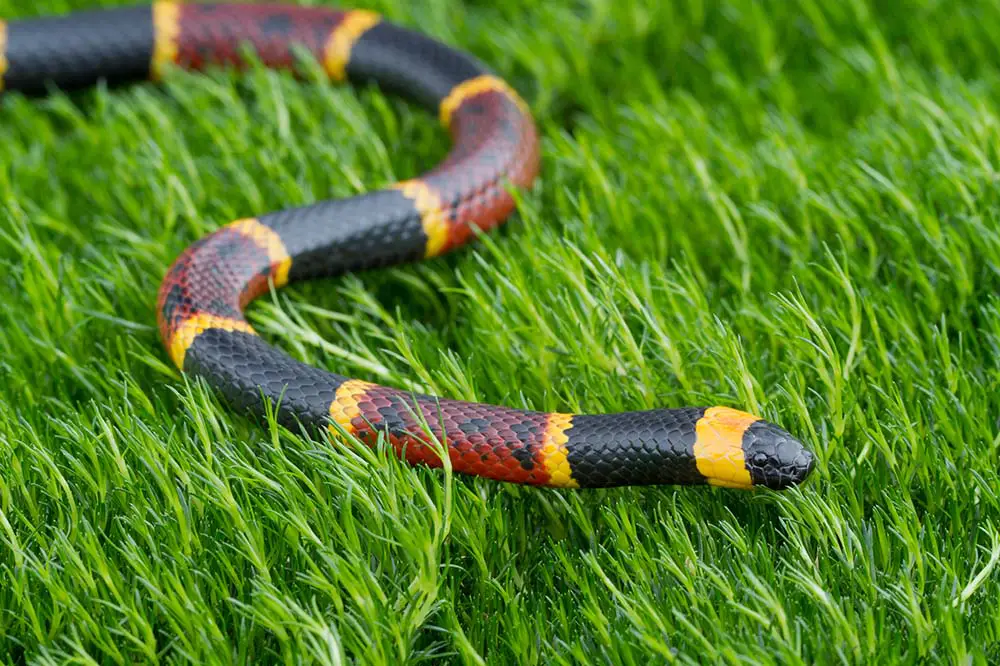
Left: Eastern coral snake | Jay Ondreicka / Shutterstock & Right: Venomous eastern coral snake | Mark Kostich / Shutterstock
33 – Australian coral snake | Brachyurophis australis
The Australian coral snake is different to the eastern coral snake in almost every way! Although they are still venomous, they are tiny, usually reaching about 38 cm or 15 inches and, being a burrowing snake, live mostly underground.
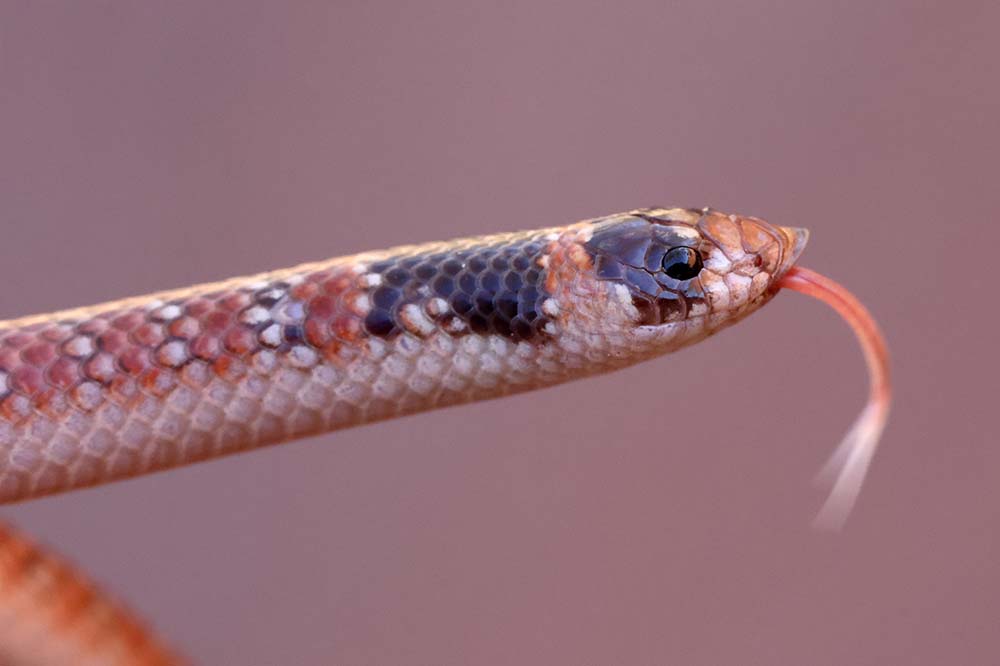

Left: Australian coral snake flickering its tongue | Ken Griffiths / Shutterstock & Right: Close up of Australian coral snake | Ken Griffiths / Shutterstock
34 – Blue Malaysian coral snake | Calliophis bivirgatus
The blue Malaysian coral snake is part of the oriental coral snake genus and is one of the most venomous, with venom glands extending up to 25% of the total length of their bodies. They are native to Southeast Asia and, interestingly, prey upon other snakes.

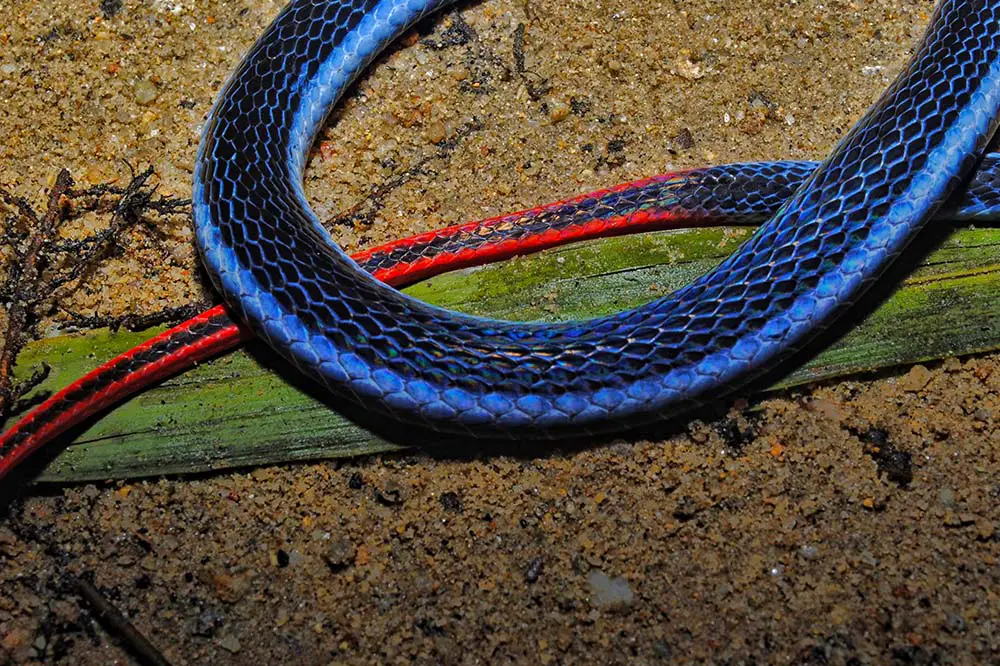
Left: Malaysian blue coral snake | Charles Bokman / Shutterstock & Right: The body part of the Malayan blue coral snake | Farriz Photos / Shutterstock
35 – MacClelland’s coral snake | Sinomicrurus macclellandi
The MacClelland’s coral snake is named in honour of the naturalist, John McClelland. There are 4 recognised subspecies and are found throughout much of east, south and Southeast Asia including the Ryukyu islands of Japan.
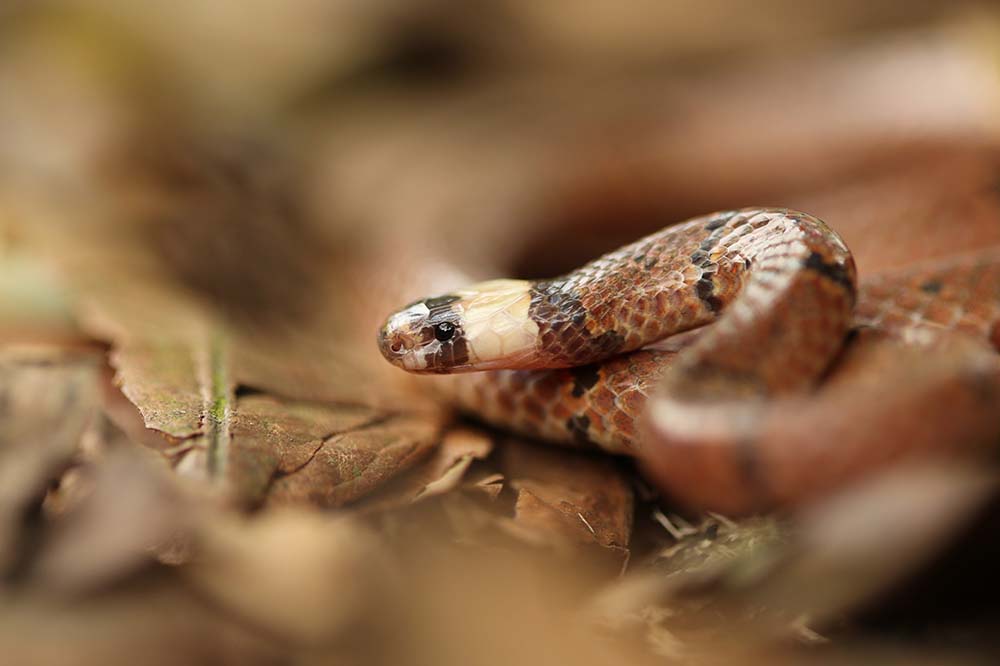

Left & Right: MacClelland’s coral snake, Vietnam | Dan Koleska / Shutterstock
Group: 7 x genera | Sea snakes/kraits
Sea snakes may refer to the single family or a collection of 7 families of aquatic snakes including sea kraits. These sea-dwelling serpents spend their lives in the shallow tropical waters of the Indian and Pacific oceans and all apart from one genus are unable to permanently exist on land.
36 – Yellow-lipped sea krait | Laticauda colubrina
The yellow-lipped sea krait is perhaps the most well-known sea snake with its distinctive black and blue striped skin. They have a yellow upper lip and snout, hence the name, and have a paddle-like tail used for swimming.


Left: Yellow-lipped sea krait | Rich Carey / Shutterstock & Right: Close up of a Yellow-lipped sea krait | Ethan Daniels / Shutterstock
37 – Black-banded sea krait | Laticauda semifasciata
The black-banded sea krait, also known as the Chinese sea krait, is similar in colour pattern but much lighter. They break the surface once every six hours to breathe and, like all sea snakes, are highly venomous; this species, in particular, are reportedly more deadly than a cobra.


Left: Tail and body of a black-banded sea krait | Ethan Daniels Shutterstock & Right: Chinese sea snake | SergeUWPhoto / Shutterstock
38 – Yellow-bellied Sea Snake | Hydrophis platurus
The yellow-bellied Sea Snake is part of the main family of sea snakes, Hydrophis, which contains 36 other species. Most have a yellow belly and black back but they can also be found entirely in yellow.

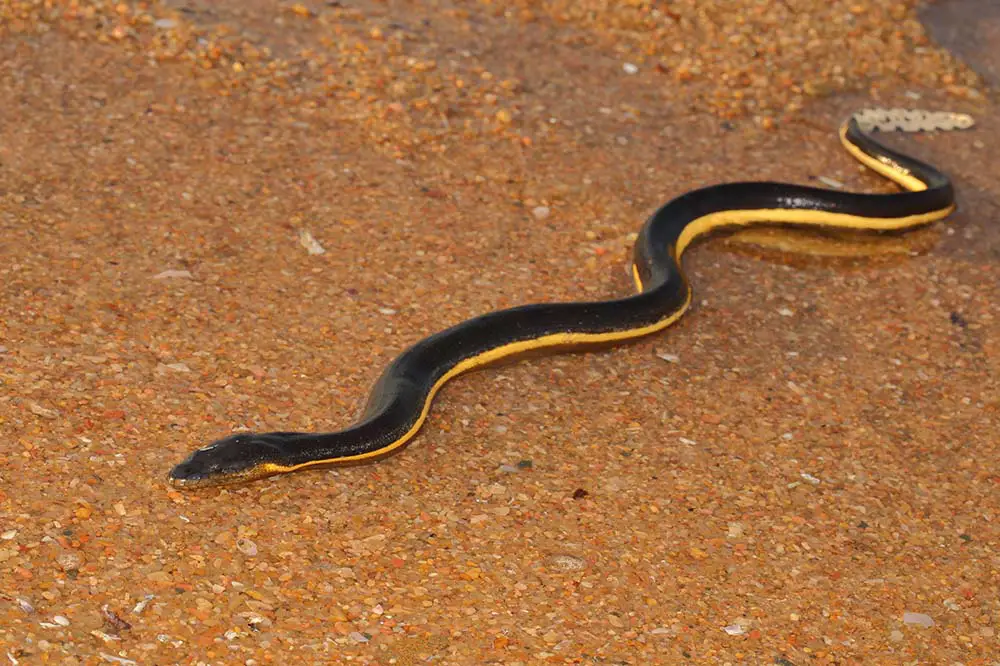
Left: Close up of a yellow-bellied sea snake | NickEvansKZN / Shutterstock & Right: Yellow-bellied sea snake on the sand | NickEvansKZN / Shutterstock
39 – Olive sea snake | Aipysurus laevis
The olive sea snake is a particularly beautiful species. They feed on crustaceans, fish, and fish eggs and are preyed upon by sharks and ospreys. They are said to be the most toxic of all sea snakes with venom that breaks down their prey to aid with digestion.
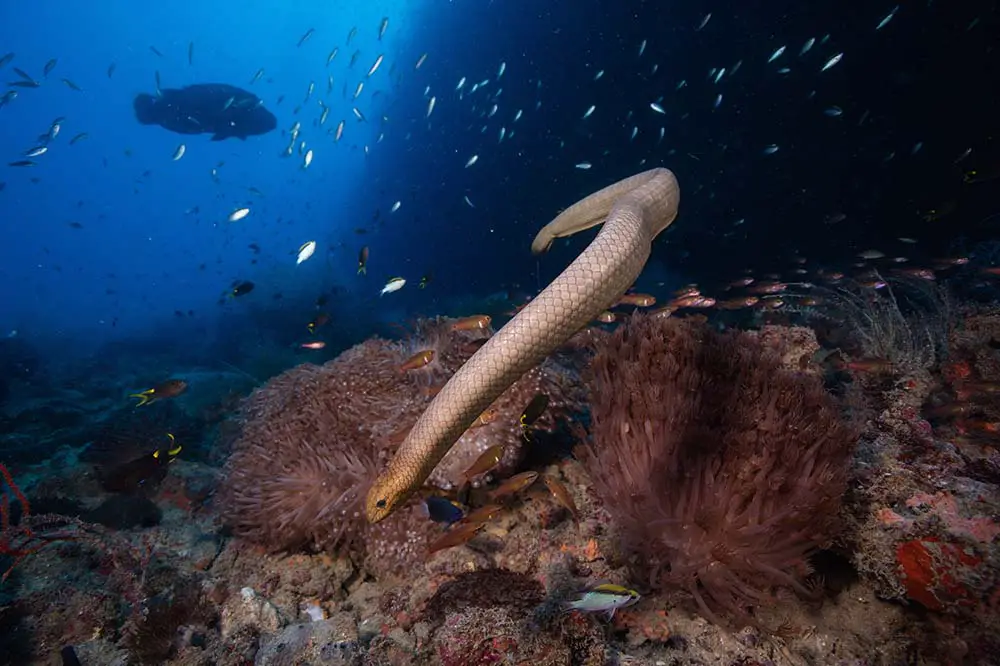
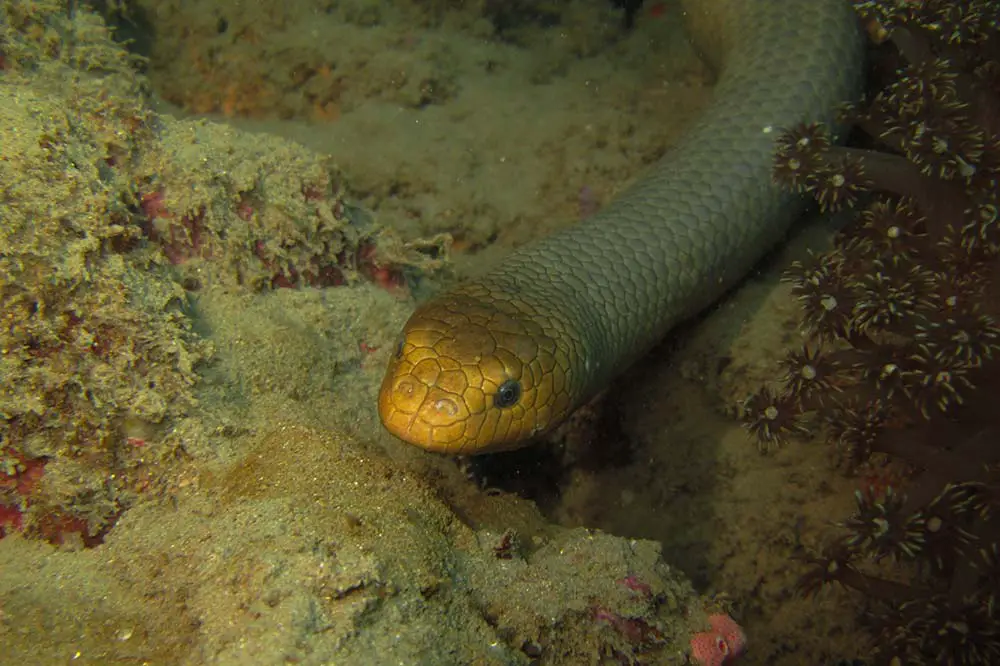
Left: Olive sea snake swimming in coral | Gabriel Guzman / Shutterstock & Right: A large olive sea snake | DNC40 / Shutterstock
Group: Other Elapids
While we have discussed a few of the main groups; cobras, coral snakes and sea snakes, there are many other interesting genera of the highly venomous elapid family that we’ll group together such as mambas, brown snakes, taipans and death adders.
40 – Banded krait | Bungarus fasciatus
The banded krait is a particularly dangerous-looking member of the krait genus that is separate from the sea-dwelling kraits we discussed in the previous chapter. This particular species inhabits termite mounds in the countryside of eastern Asia.
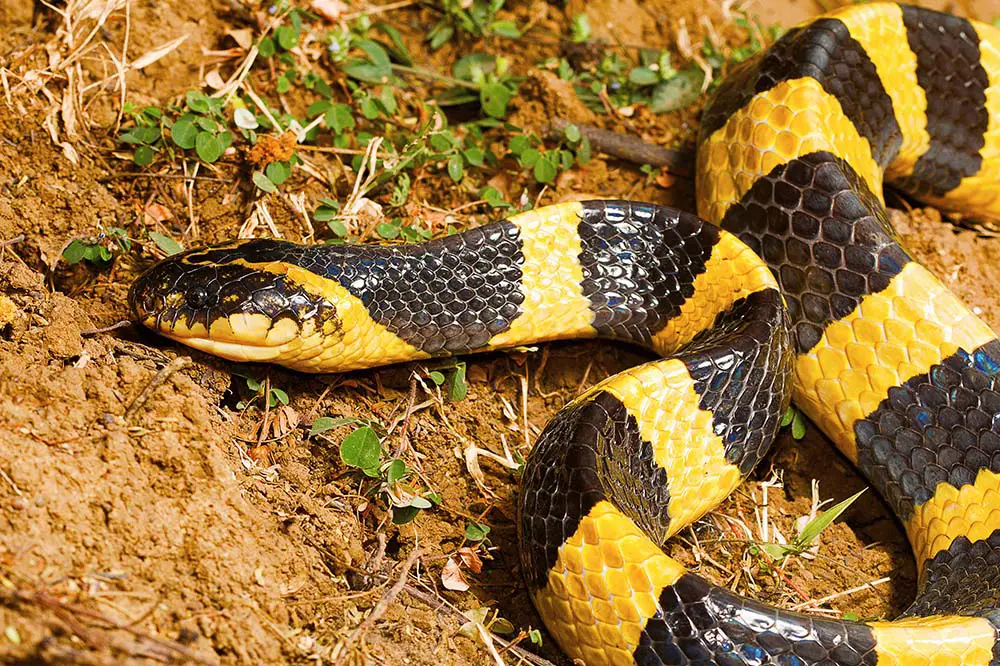
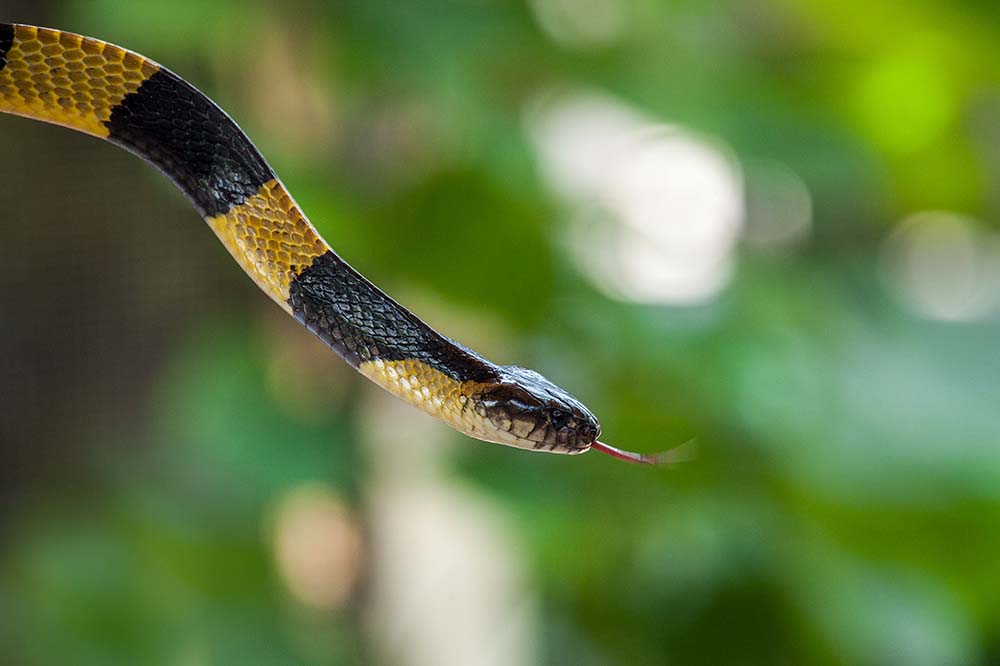
Left: Banded krait in Raipur, Chhattisgarh, India | RealityImages / Shutterstock & Right: Banded krait with its tongue out | apple2499 / Shutterstock
41 – Black mamba | Dendroaspis polylepis
The black mamba is one of the most well-known and infamous snakes in the world. They are found in parts of sub-Saharan Africa and, in terms of venomous snakes, the black mamba is second only in length to the king cobra.
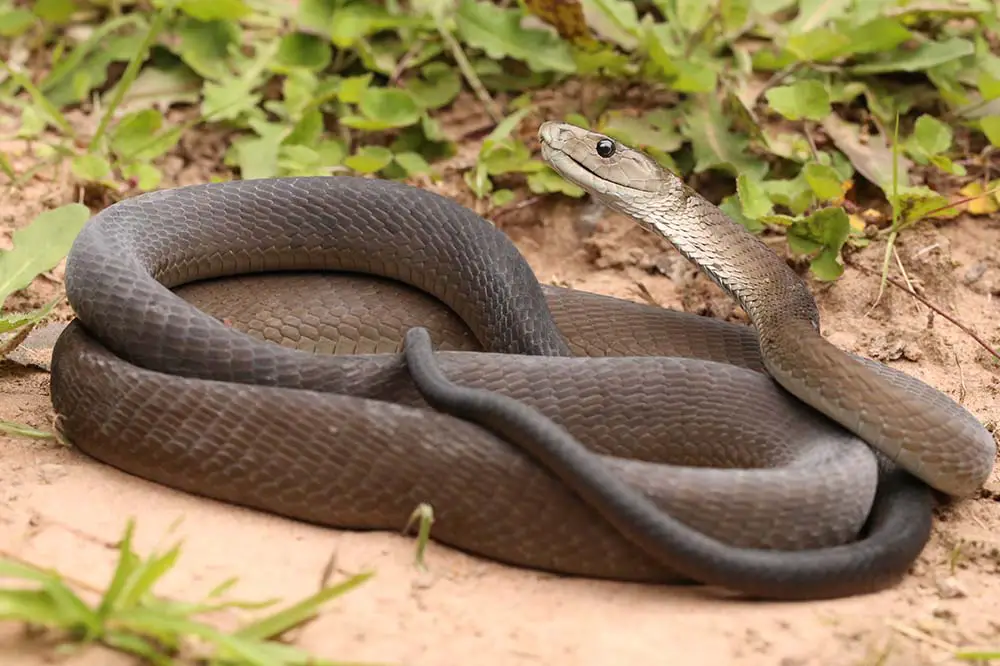
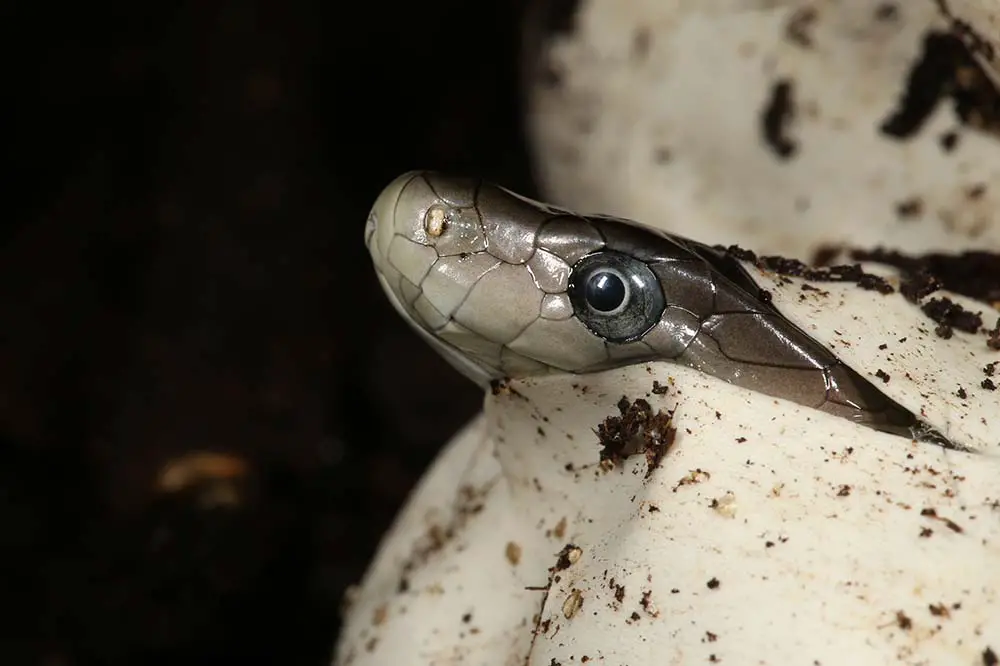
Left: A coiled black mamba | NickEvansKZN / Shutterstock & Right: Black Mamba hatching | NickEvansKZN / Shutterstock
42 – Western green mamba | Dendroaspis viridis
The western green mamba inhabits the coastal tropical forest and woodland regions of West Africa and is one of two species of green mamba—the other being the eastern green mamba found in East and Southern Africa.

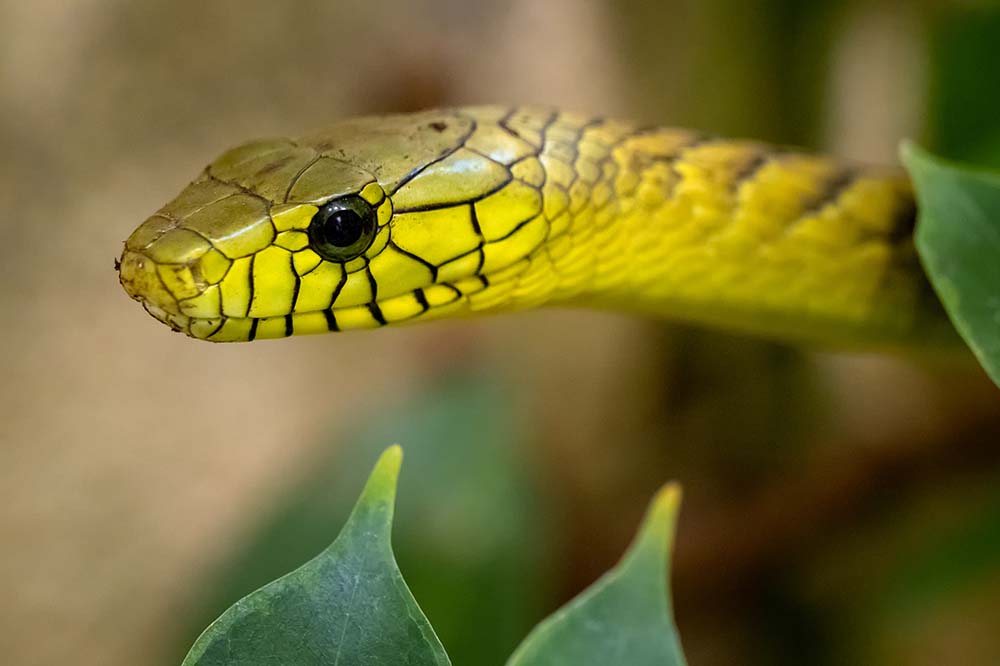
Left: Western green mamba in green foliage | Prill / Shutterstock & Right: Western green mamba | Lubos Chlubny / Shutterstock
43 – Eastern brown snake | Pseudonaja textilis
The eastern brown snake can reach up to 2 meters or 7 feet in length and is considered to be the second most poisonous snake in the world. They are found in Australia and New Guinea especially in areas such as farmland with high populations of house mice.

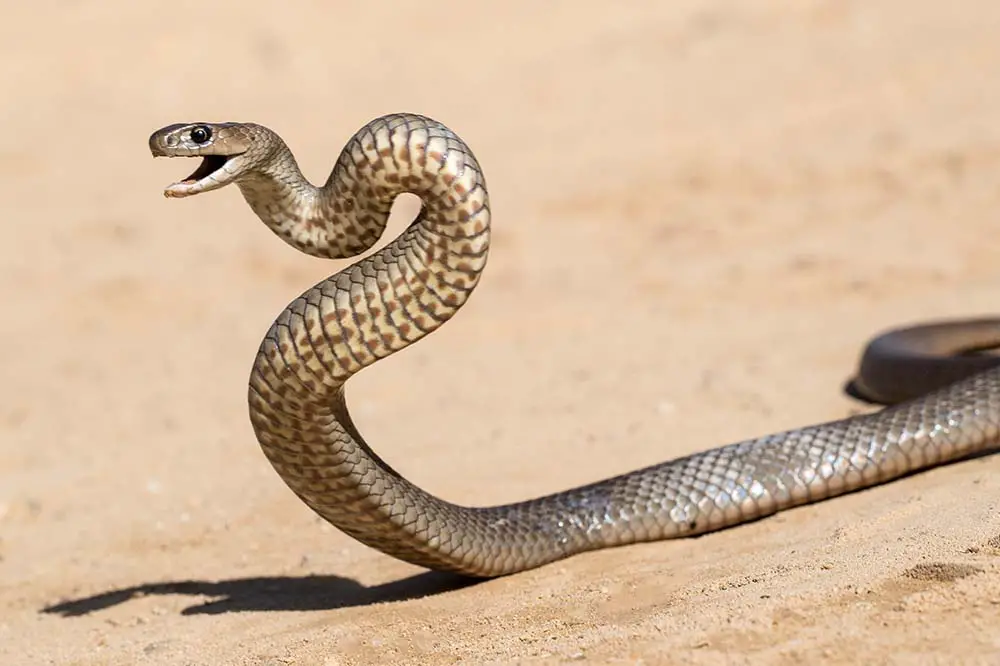
Left: Highly venomous eastern brown snake | Ken Griffiths / Shutterstock & Right: Eastern brown snake in striking position | Ken Griffiths / Shutterstock
44 – Ringed brown snake | Pseudonaja modesta
The ringed brown snake is a close relative to the eastern brown snake and is distinguished by four to seven black bands dispersed throughout its body although these bands or rings are much less prominent on some individuals.
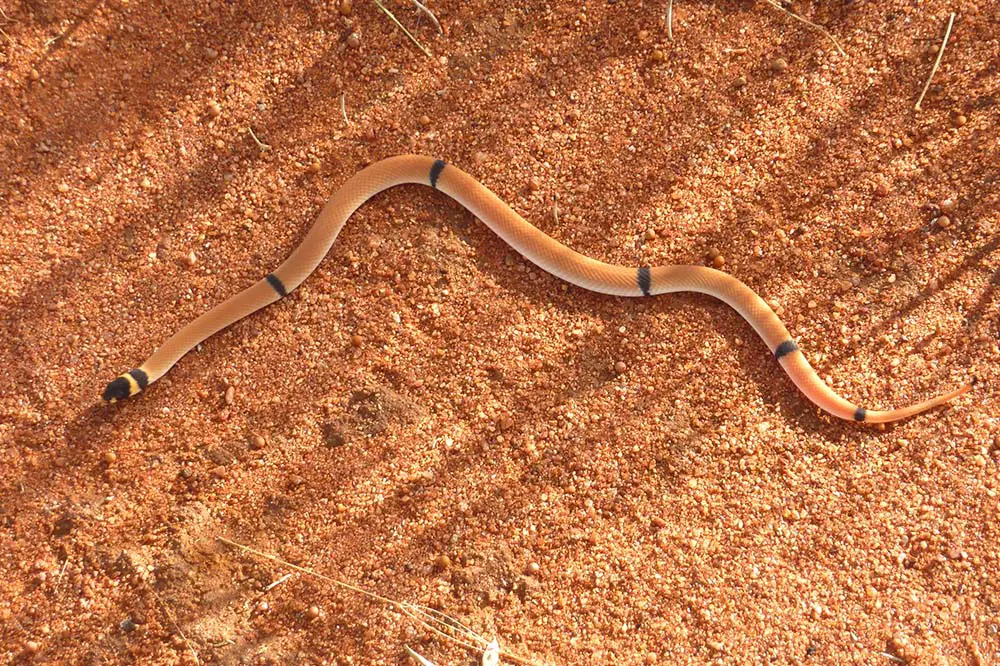
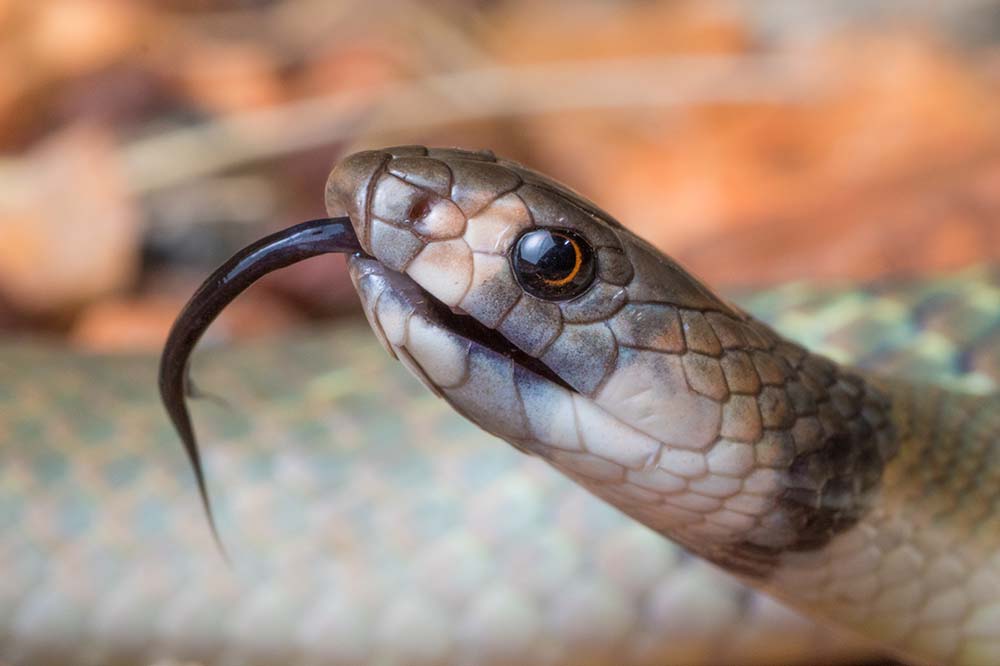
Left: A black and orange Australian ringed brown snake in the Australian outback | Chris Watson / Shutterstock & Right: Close up of a ringed brown snake | Adam Brice / Shutterstock
45 – King brown | Pseudechis australis
The king brown snake is not actually a brown snake, rather, it is the first of two black snakes that we’ll discuss. They are quite large growing up to 3.3 meters or 11 ft in length and are found in either a browny-black or a reddish-brown colour.
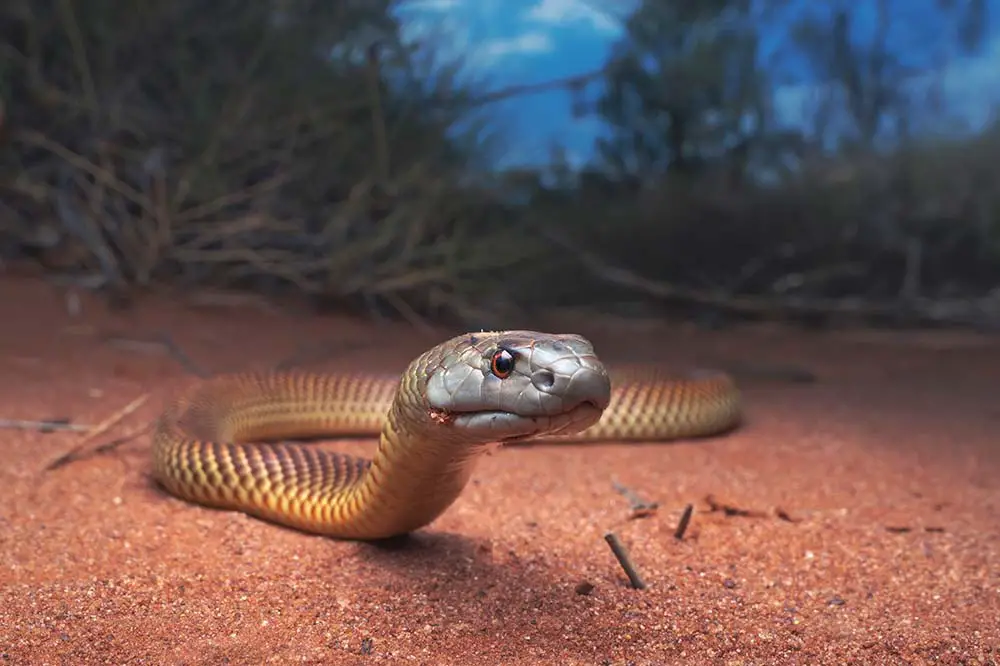

Left: King brown snake | Ken Griffiths / Shutterstock & Right: Juvenile king brown aka the mulga snake | Kristian Bell / Shutterstock
46 – Inland taipan | Oxyuranus microlepidotus
The inland taipan, which is also named the fierce snake, changes the colour of its skin depending on the season to aid with thermoregulation. It is endemic to Australia and is the most venomous species of snake in the world.
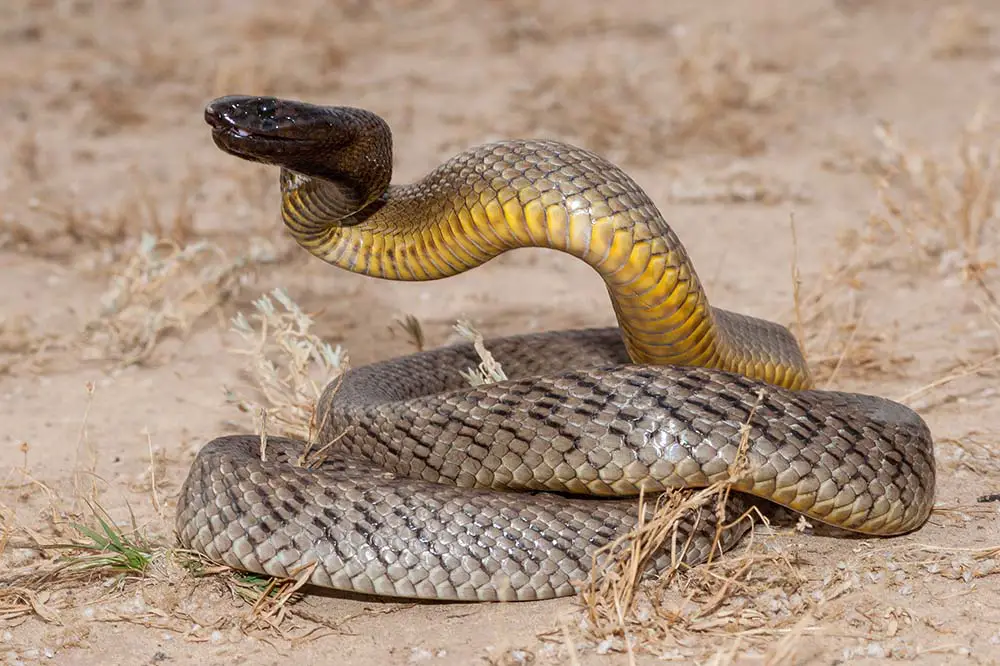

Left: Inland taipan in coiled position | Ken Griffiths / Shutterstock & Right: Yellow inland taipan in Australia | Ondrej Prosicky / Shutterstock
47 – Coastal taipan | Oxyuranus scutellatus
The coastal or common taipan is found in the coastal regions of Australia and on the island of New Guinea where there is a particularly colourful subspecies known as the Papuan Taipan, which has a much lighter body and an orange head.
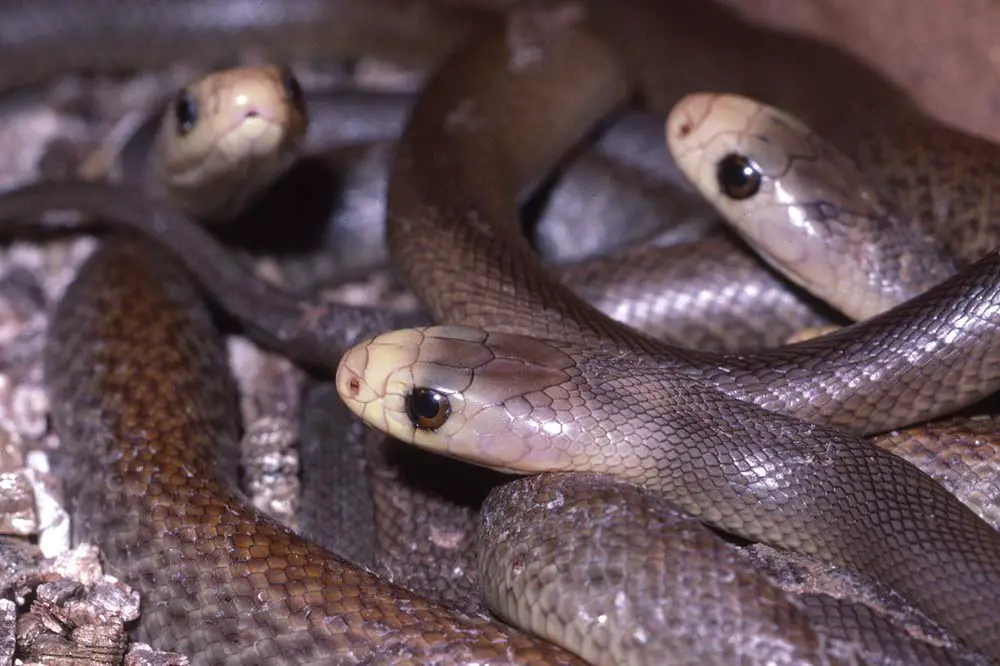

Left: Hatchling coastal taipans | Ken Griffiths / Shutterstock & Right: Close up of a coastal taipan | reptiles4all / Shutterstock
48 – Tiger snake | Notechis scutatus
Tiger snakes are named so for the tiger-like bands across the length of their bodies. They are excellent swimmers and come in a wide range of colours depending on which part of Australia they are from.
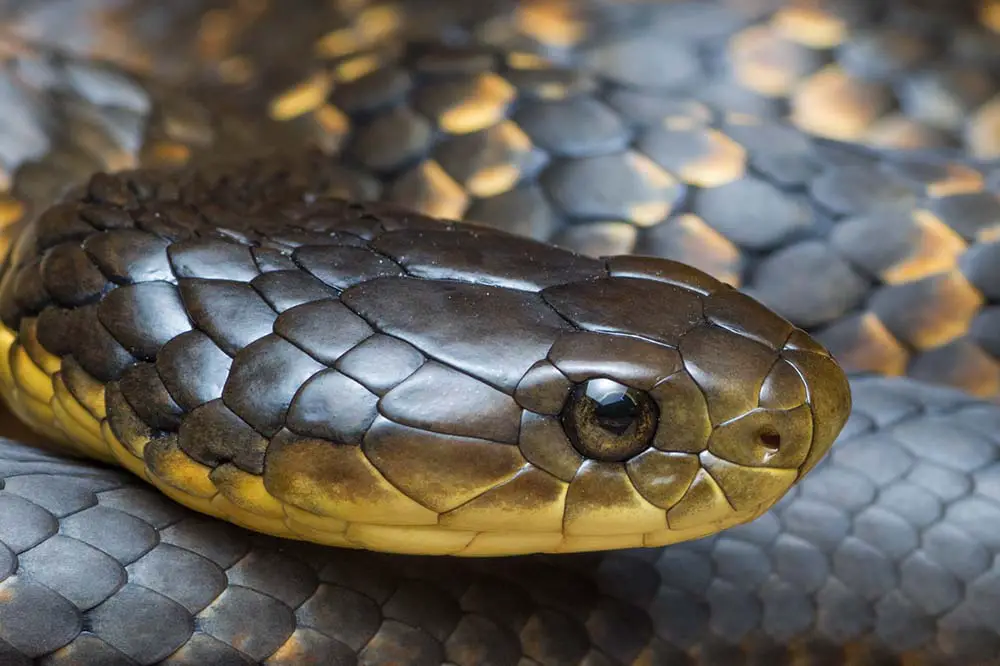
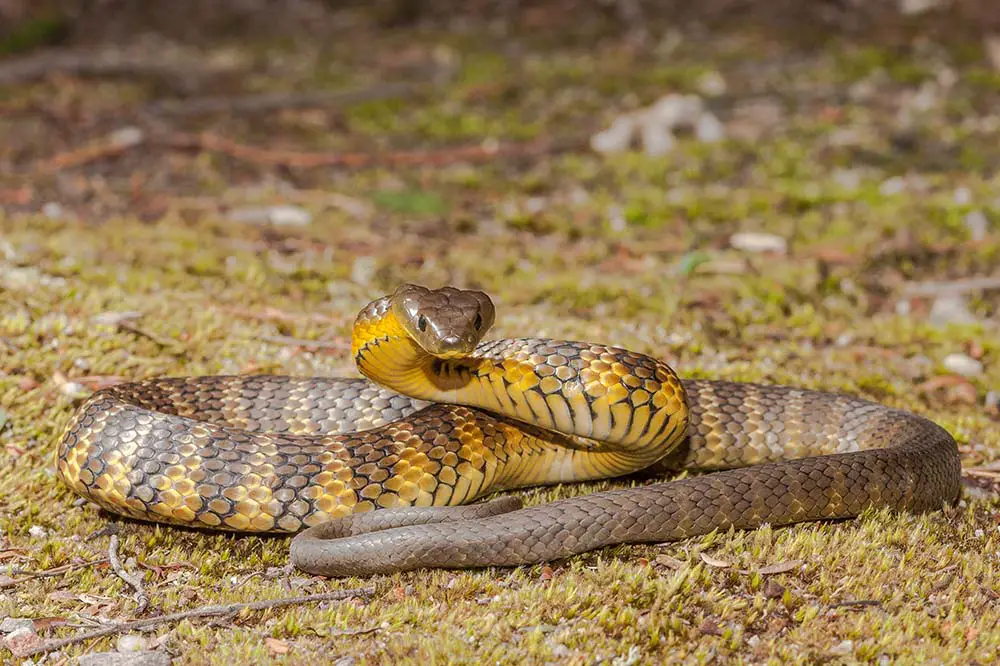
Left: Close up of a tiger snake in the Perth region of Western Australia | Adam Brice / Shutterstock & Right: Eastern tiger snake in defence pose | Ken Griffiths / Shutterstock
49 – Common death adder | Acanthophis antarcticus
The common death adder is one of two death adders that we’ll explore and the last in the Elapid family. Death adders possess the longest fangs of any snake in Australia but, rather bizarrely, are currently threatened by an invasion of cane toads.

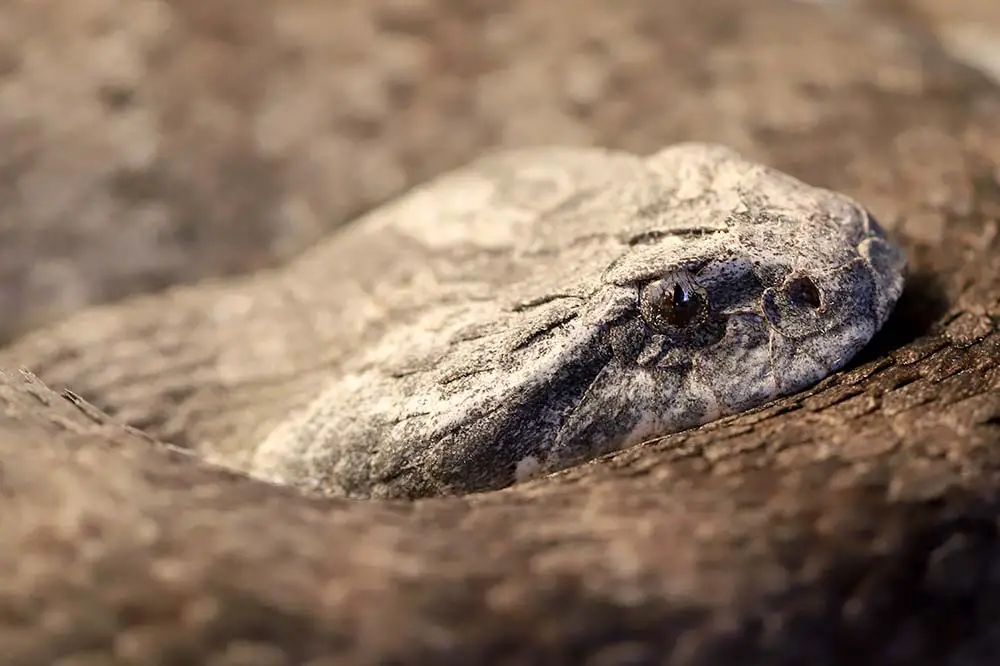
Left: Close up of Australian common death adder showing lure at tip of tail | Ken Griffiths / Shutterstock & Right: Common death adder in curled up position | Ken Griffiths / Shutterstock
50 – Desert death adder | Acanthophis pyrrhus
Desert death adders are extremely well camouflaged for their environment and can either be a brick red or more of a yellowish colour. They are found in central and western Australia where they prey upon lizards and small mammals.
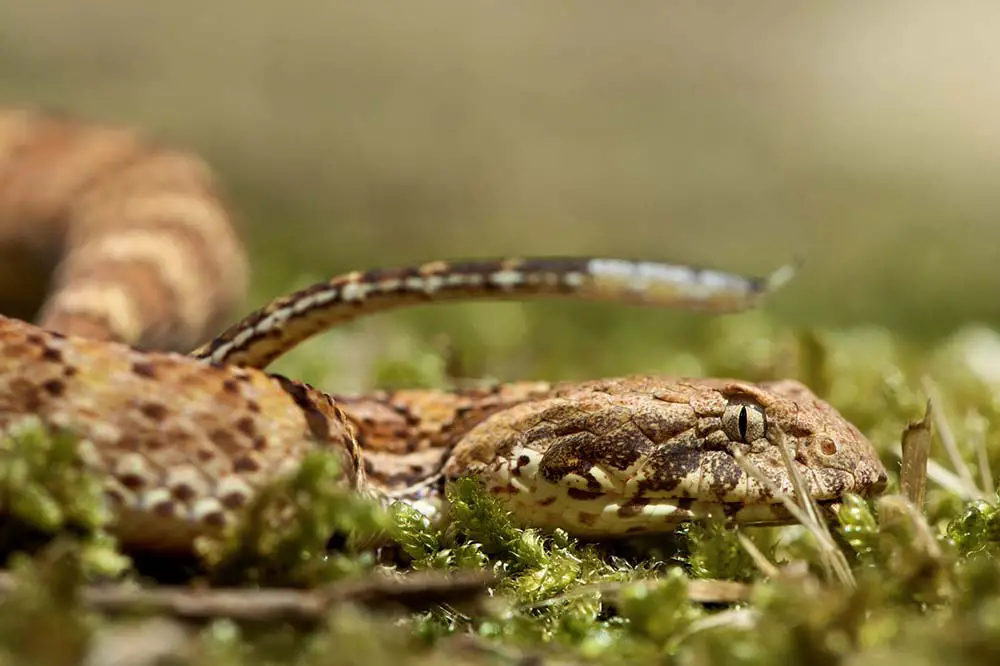
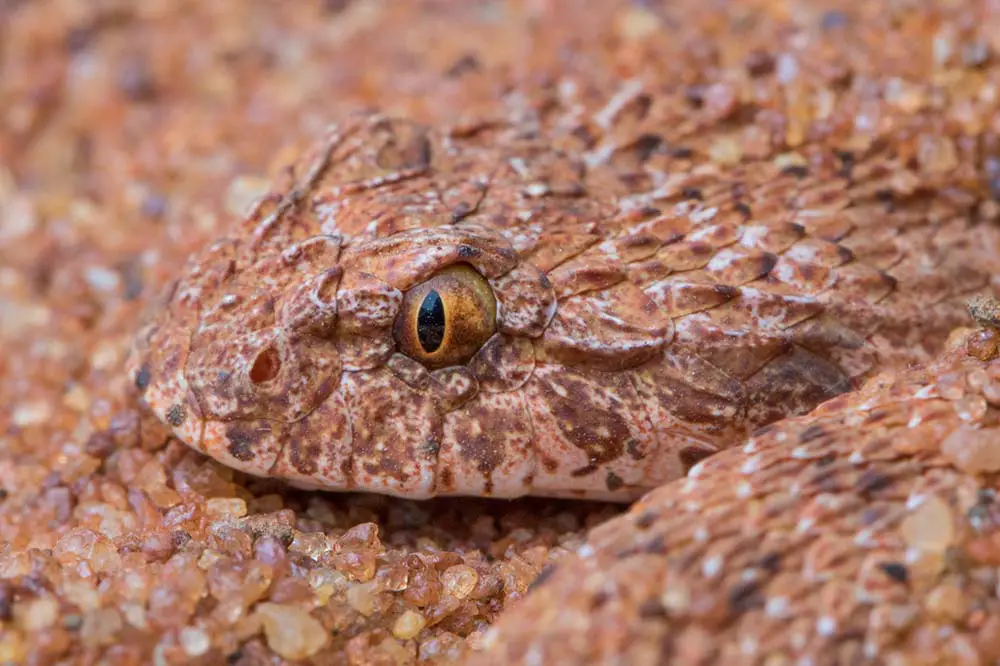
Left: Death adder with tail lure | Brooke Whatnall / Shutterstock & Right: A desert death adder await in ambush | Adam Brice / Shutterstock
Family: Colubridae | Typical snakes
Commonly referred to as typical snakes, Colubridae is the largest snake family comprising 8 subfamilies, 258 genera and over 1800 species. The vast majority of these snakes are non-venomous, although there are a few species that have caused human fatalities.
Subfamily: Natricinae
The first subfamily that we’ll explore is Natricinae. It contains 37 genera and includes grass snakes, water snakes and garter snakes. They are found on most continents with the exception of South America and only a few that exist in Australasia.
51 – Grass snake | Natrix natrix
Grass snakes are strong swimmers and feed exclusively on amphibians. They spend winter underground where they are not subject to freezing and males will bask in the sun in the spring to raise their body temperature before mating.

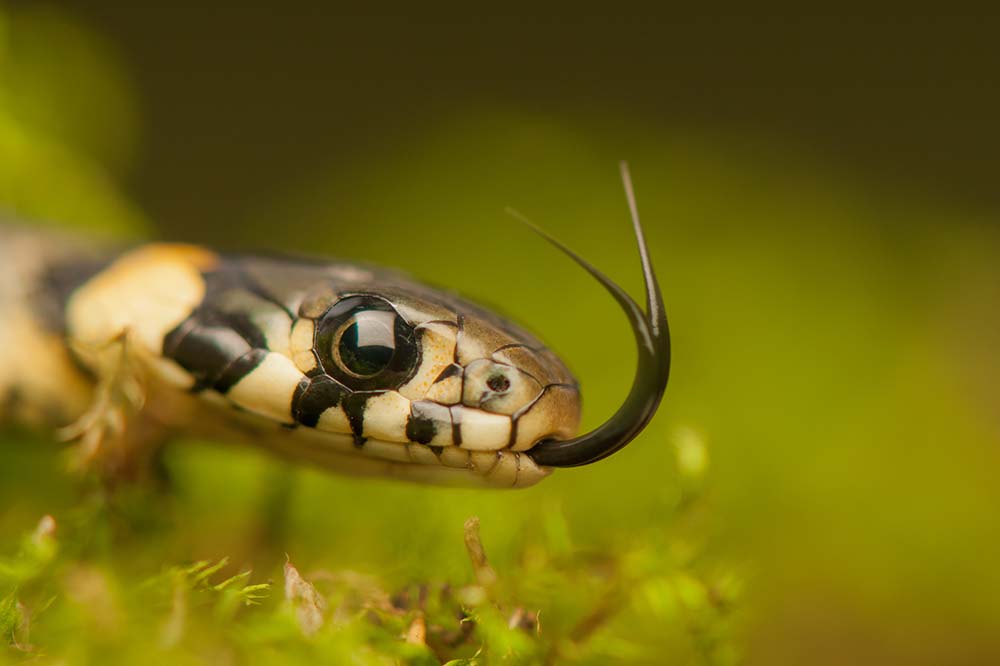
Left: Grass snake on pond with water lily leaf | Dr Pixel / Shutterstock & Right: Close up of a grass snake | Gucio_55 / Shutterstock
52 – Common garter snake | Thamnophis sirtalis
Garter snakes are relatively small skinny snakes, with a maximum total length of 1.4 meters or 4 feet. Their venom is very mild but they are efficient hunters often catching fish and tadpoles. They are present in North America where there are 13 subspecies.

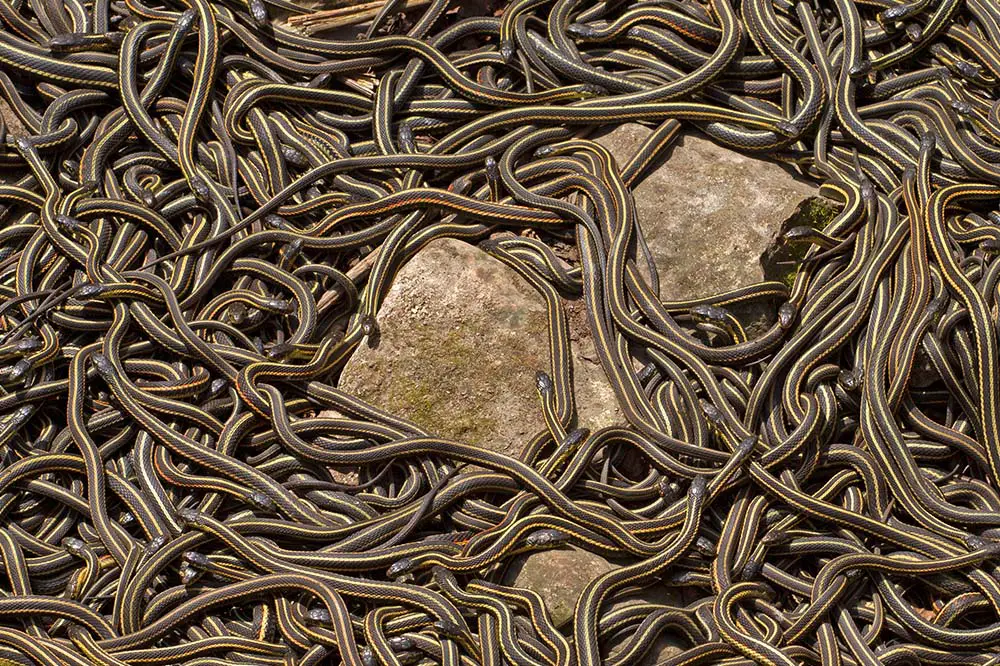
Left: Headshot of a common garter snake | Paul Tessier / Shutterstock & Right: A group of garter snakes mating in Narcisse, Manitoba, Canada | Jukka Palm / Shutterstock
53 – San Francisco garter snake | Thamnophis sirtalis tetrataenia
The San Francisco garter snake is by far the most colourful subspecies of garter snake, exhibiting blue, red and black stripes along the length of its body. They are currently listed as endangered with some researchers estimating that only 1-2 thousand remain in the wild.


Left: Close up of a San Francisco garter snake | reptiles4all / Shutterstock & Right: Group of San Francisco garter snakes, endemic to California | spatuletail / Shutterstock
54 – Buff striped keelback | Amphiesma stolatum
The buff striped keelback is a particularly docile snake, it is said to be the Asia version of the American garter snake being found in South and Southeast Asia. They tend to dwell in areas with lots of water where they feed on frogs and toads.
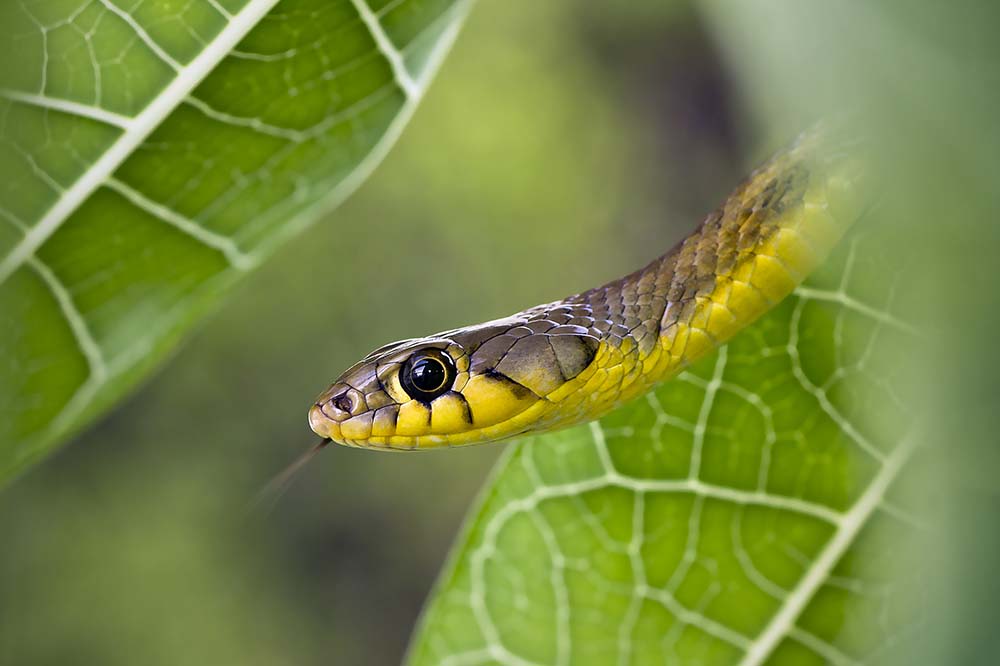
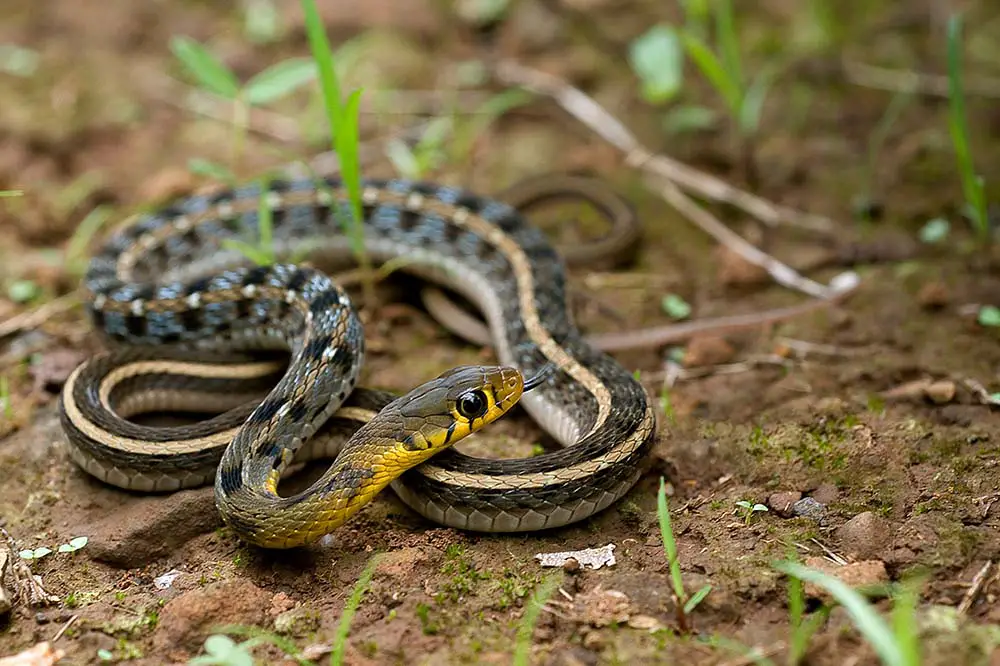
Left: Buff striped keelback | irfanazam / Shutterstock & Right: Coiled up buff striped keelback | Pratimaan / Shutterstock
55 – Common watersnake | Nerodia sipedon
The common watersnake also feeds on amphibians along with small birds and mammals, which they hunt at the water’s edge. This snake is ovoviviparous, meaning that it gives birth to live offspring rather than laying eggs.

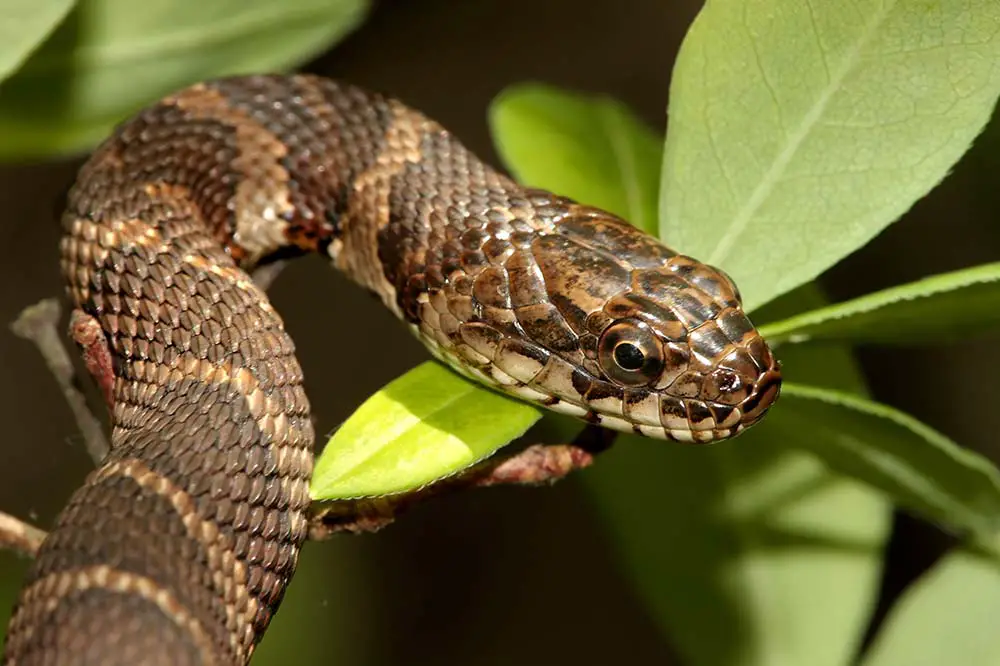
Left: Northern water snake basking on a rock in Haliburton, ON, Canada | Brian Lasenby / Shutterstock & Right: Northern water snake climbing in a tree | Steve Byland / Shutterstock
56 – Diamondback water snake | Nerodia rhombifer
The diamondback water snake gets its name from the roughly diamond-shaped black spots that are present along its body and also, coincidentally, has a diamond-shaped head. This harmless species is often mistaken for the highly venomous cottonmouth.


Left: Diamondback water snakes | Laurie L Snidow / Shutterstock & Right: Diamondback water snake that is flattening its head in a defensive posture | Michael Benard / Shutterstock
Subfamily: Dipsadinae
Dipsadinae is a family of snakes containing 700 species that are present throughout the Americas. The various genera include snail-eaters, hognose snakes and a group of snakes that mimic various members of the venomous coral snake and viper families.
57 – Western worm snake | Carphophis vermis
The western worm snake has a very unique colouration, with a black or purple back and a light pink belly. They are very small with adults rarely surpassing 28 cm or 11 inches and their diet consists almost entirely of earthworms.
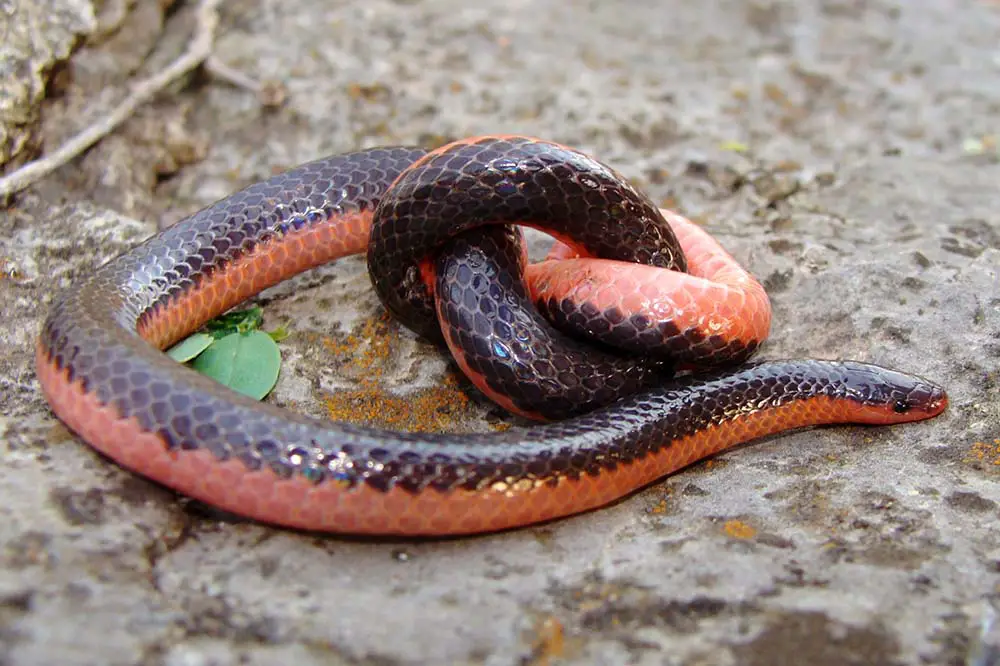
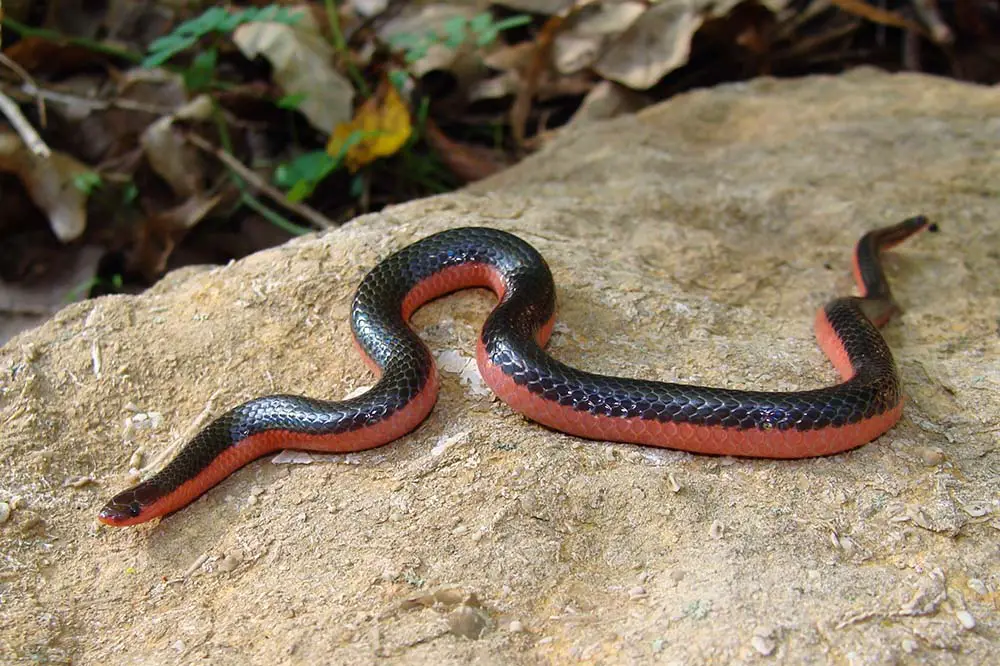
Left: Western worm snake in a knot! | Matt Jeppson / Shutterstock & Right: Western worm snake | Matt Jeppson / Shutterstock
58 – Ring-necked snake | Diadophis punctatus
The ring-necked snake is around the same size as the western worm snake and, like their pink-bellied cousins, exhibit a darker back and colourful belly, this time with a spectacular combination of orange and red.


Left: Ring-necked snake close up portrait | Tucker Heptinstall / Shutterstock & Right: Ring-necked snake from Arizona | jokerbethyname / Shutterstock
59 – Catesby’s snail-eater | Dipsas catesbyi
The Catesby’s snail-eater is the first of two snakes that we’ll look at who prey upon arboreal land snails and slugs. This particular species lives in tropical forests, lowland areas and mountainous regions at altitudes of up to 1,500 meters or just under 5,000 feet.

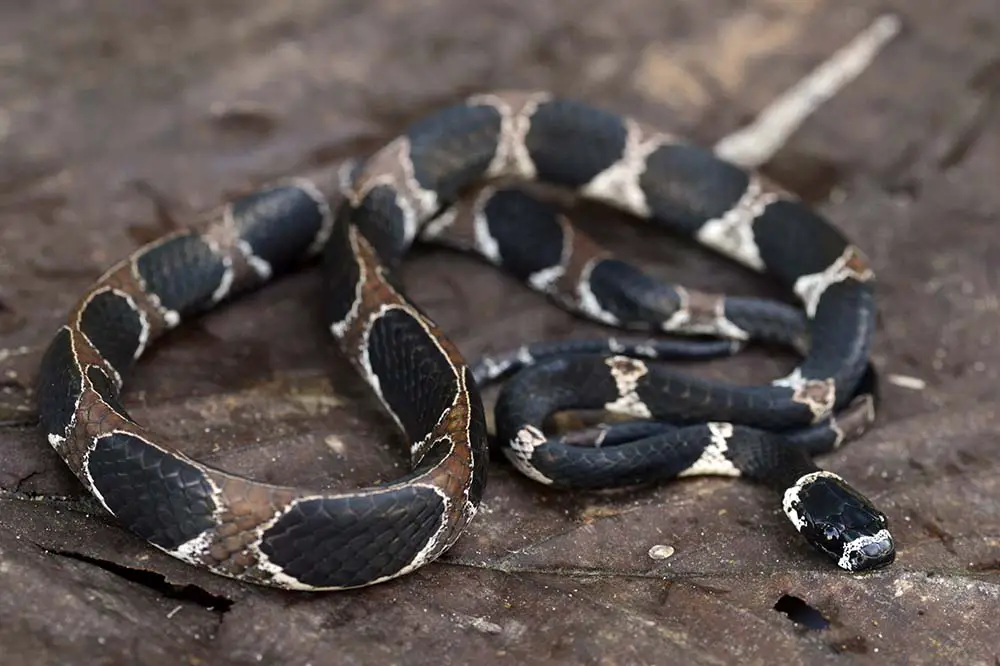
Left: Catesby’s snail-eater portrait | Patrick K. Campbell / Shutterstock & Right: Catesby’s snail-eater | Patrick K. Campbell / Shutterstock
60 – Neo-tropical snail-eater | Dipsas indica
The neo-tropical snail-eater lives in South America alongside the Catesby’s snail-eater and uses its slender jaw to pry snails from their shells. There are two known subspecies both of which are fully arboreal.
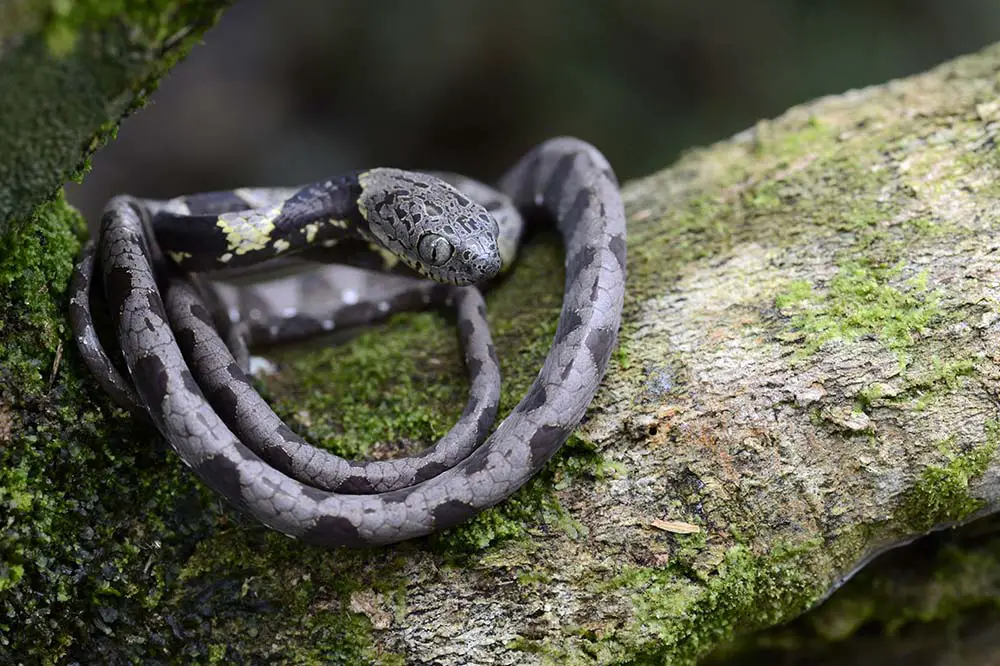
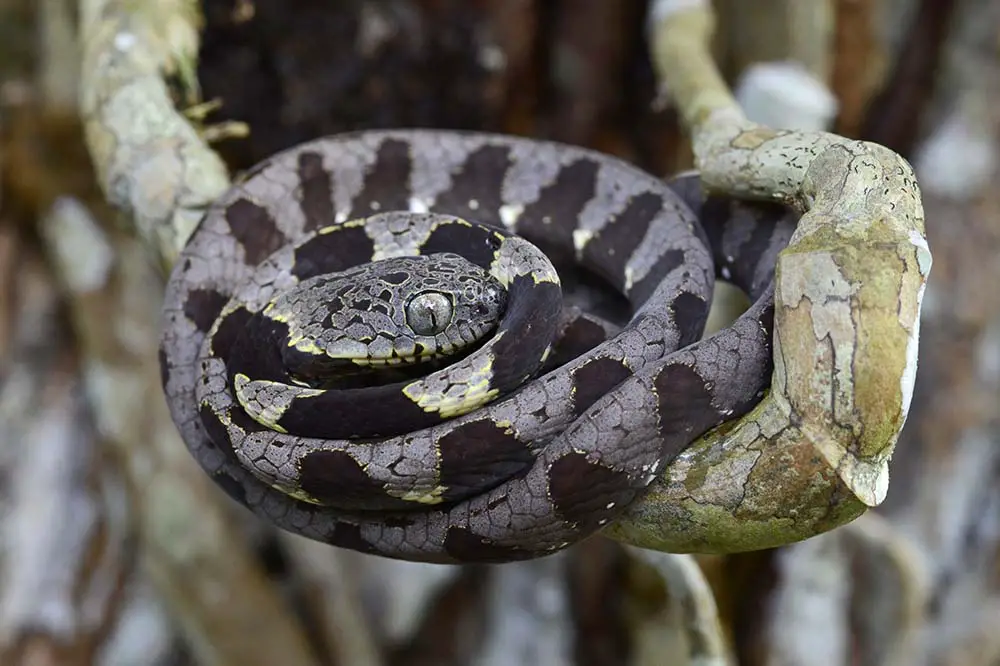
Left: A cute Amazonian snail eater | Patrick K. Campbell / Shutterstock & Right: Curled up Amazonian snail eater | Patrick K. Campbell / Shutterstock
61 – False coral snake | Oxyrhopus guibei
The false coral snake is one of many species of snake that have evolved to display the colouration of the highly venomous coral snake, a defence known as Batesian mimicry, where a harmless species mimics the appearance of a dangerous species.
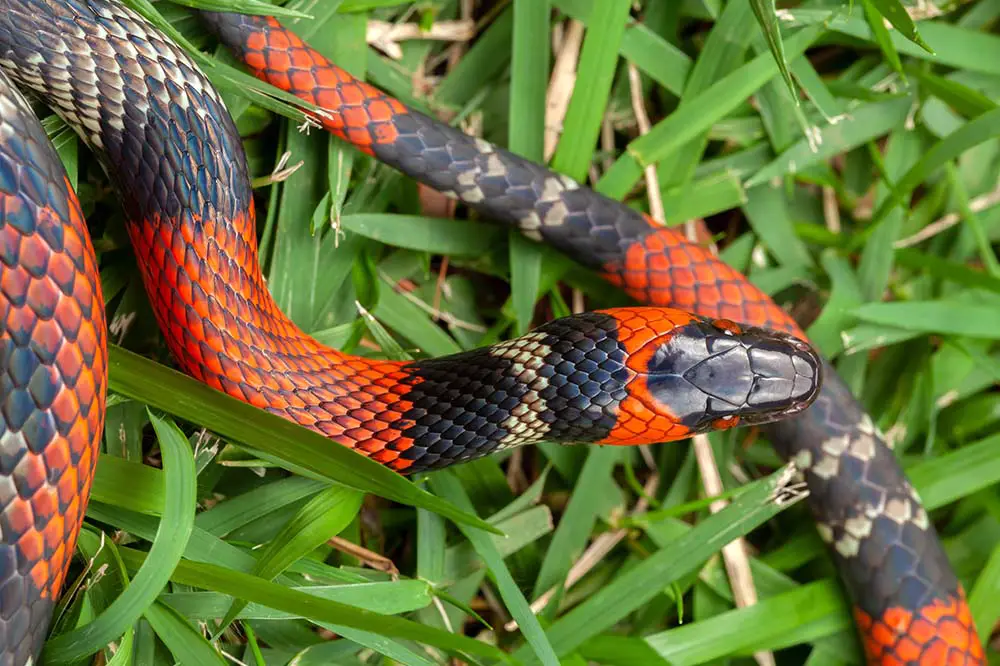

Left: False coral snake | Tacio Philip Sansonovski / Shutterstock & Right: Portrait of a false coral snake | Tacio Philip Sansonovski / Shutterstock
62 – Tschudi’s false coral snake | Oxyrhopus melanogenys
The Tschudi’s false coral snake has two highly distinct subspecies. The first has black and red scales with black and white stripes. The second is known as the Black-Headed Calico Snake and is almost entirely black in colour with yellow stripes.
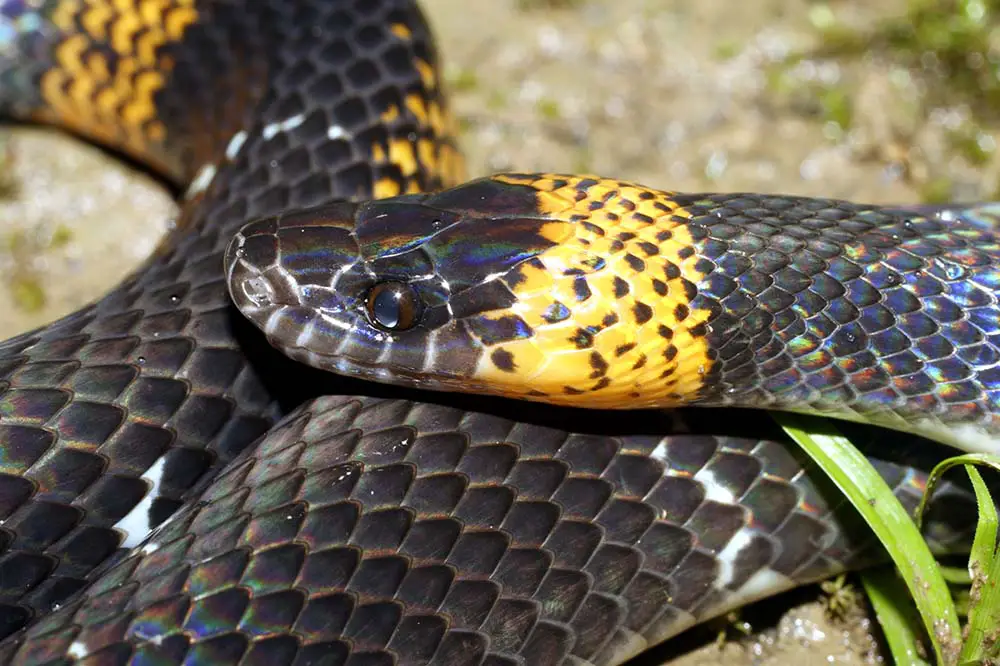
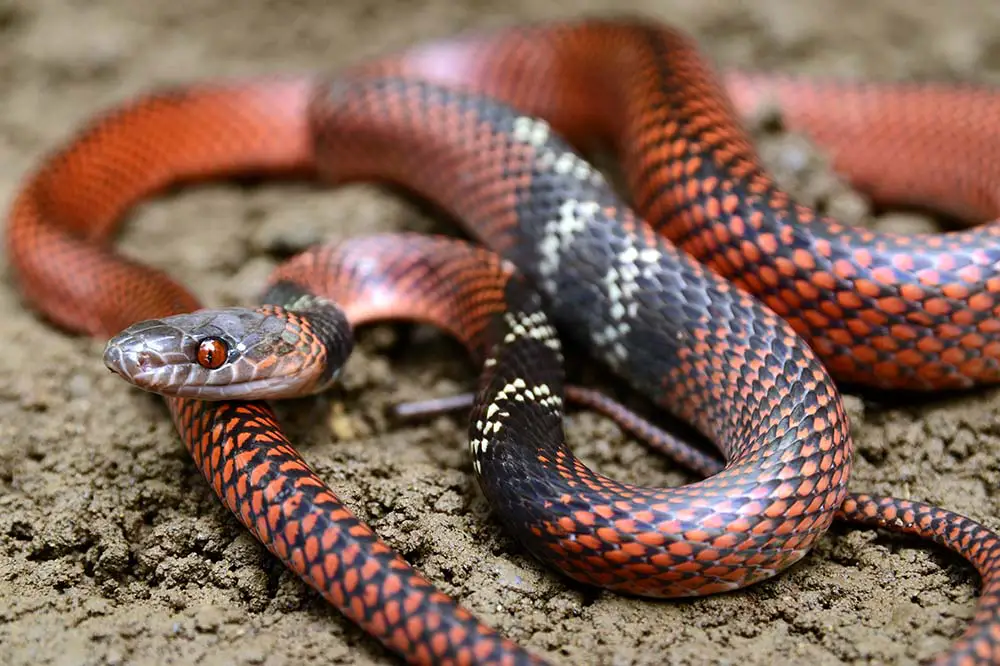
Left: Black-headed calico snake | Dr Morley Read / Shutterstock & Right: Tschudi’s false coral snake | Oxyrhopus melanogenys Shutterstock
63 – Mud snake | Farancia abacura
The mud snake is almost entirely aquatic; it is usually found on the edge of swamps and streams where it preys on salamanders and other amphibians. They are found throughout much of the southeastern United Stakes.

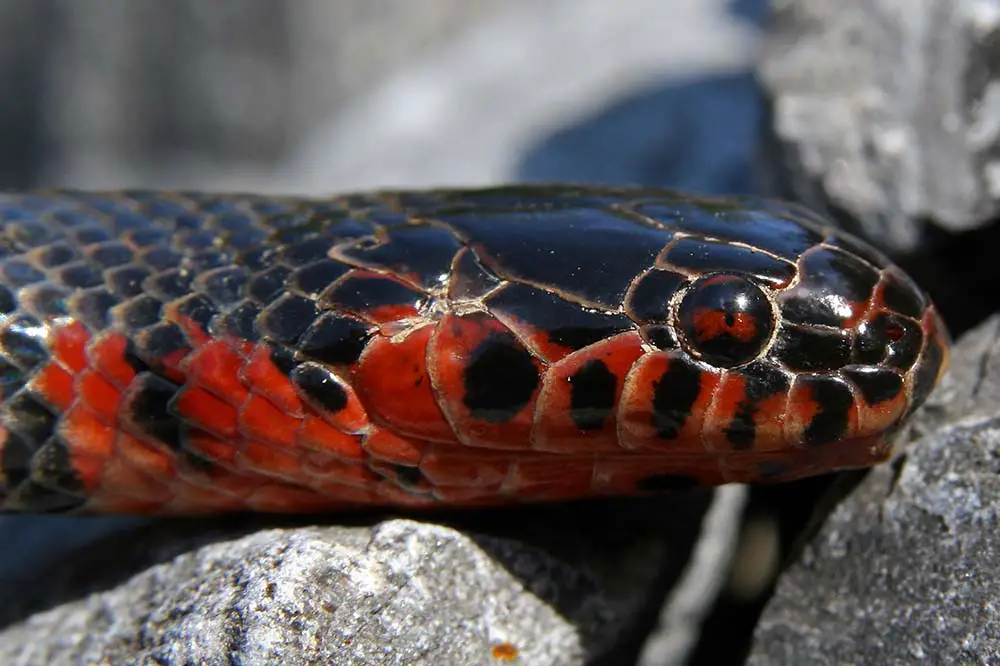
Left: Eastern mud snake | Nathan A Shepard / Shutterstock & Right: Western mud snake | Ryan M. Bolton / Shutterstock
64 – Western hog-nosed snake | Heterodon nasicus
The Western hognose snake is one of two hog-nosed snakes we’ll cover that have upturned snouts, which they use for digging in the soil. This particular species has developed a resistance to the toxicity of toads, its primary prey.


Left: A colourful orange-red Eastern Hognose snake | Mike Wilhelm / Shutterstock & Right: Flattened-out eastern hognose snake with rear fangs exposed | Mike Wilhelm / Shutterstock
65 – Eastern hognose snake | Heterodon platirhinos
The Eastern hognose snake is the colourful cousin to its western counterpart. Although they can be found in a normal colouration, they can also exhibit reddish-orange skin with black chequers or blotches.

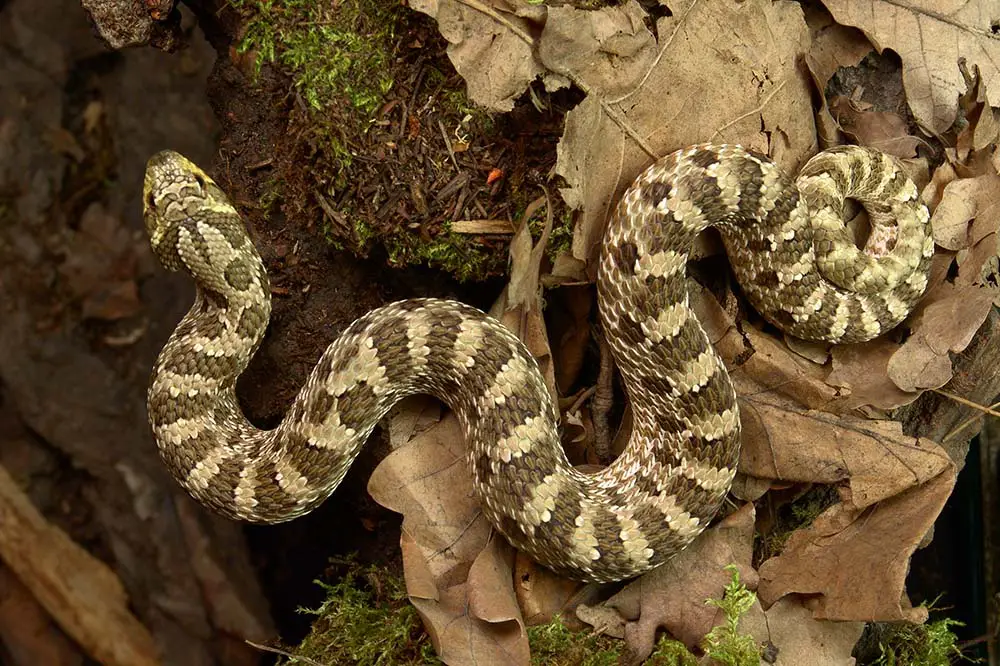
Left: Western hognose snake portrait | Mark Kostich / Shutterstock & Right: The body of a western hognose snake | skifbook / Shutterstock
66 – Blunt-headed tree snake | Imantodes cenchoa
The Blunt-headed tree snake is a mildly venomous snake that lives in Mexico, Central America, and South America. They are well-known for their slender bodies and large heads that house their particularly googly eyes!


Left: Blunt-headed tree snake | Edvard Mizsei / Shutterstock & Right: A blunt-headed tree snake in the jungle of Ecuador | Zaruba Ondrej / Shutterstock
67 – Clouded snake | Sibon nebulatus
The clouded snake has a similar appearance to the blunt-headed tree snake but is a little darker with a blotched pattern. They are found in a similar range but also inhabit Venezuela’s Isla Margarita and the island nation of Trinidad and Tobago.


Left: A cloudy snail sucker perched on a flower | Vaclav Sebek / Shutterstock & Right: The clouded snake | David Havel / Shutterstock
68 – Giant false viper | Xenodon severus
The giant false viper is part of a genus of snakes, Xenodon, many of which mimic the appearance of the highly venomous viper family. This entire genus, which is made up of 12 species, prey almost entirely on toads.


Left: A baby giant false viper in the Peruvian Amazon | Ryan M Bolton / Shutterstock & Right: Giant Amazon false viper | Patrick K. Campbell / Shutterstock
Subfamily: Ahaetuliinae
The snakes of the subfamily Ahaetuliinae are found throughout much of Asia, as far west as Pakistan and as far south as Australia. It contains some of the most unique and beautiful species of snake including vine snakes, flying snakes and bronzebacks.
69 – Common vine snake | Ahaetulla nasuta
The common vine snake, also known as the Sri Lankan green vine is a venomous snake found on the island of Sri Lanka. They were previously thought to inhabit much of India but a 2020 study categorized those snakes into 4 different species.


Left: Sri Lankan green vine snake | Capture i_524 / Shutterstock & Right: Green vine snake hanging on the tree | Panu_Sa / Shutterstock
70 – Oriental whip snake | Ahaetulla prasina
The Oriental whip snake has a broader range, being found throughout much of southern Asia. It is very similar in appearance to the common vine snake but comes in a fascinating array of colour morphs including yellow and white.


Left: Yellow oriental whip snake | panda3800 / Shutterstock & Right: Oriental whip snake in a white morph form | Chattraphas / Pongcharoen Shutterstock
71 – Paradise tree snake | Chrysopelea paradisi
The paradise tree snake is one of two snakes on this list who are capable of a type of gliding flight and are known as flying or gliding snakes. They flatten their body using their ribs, which allows them to glide for distances of up to 10 meters or 30 feet.

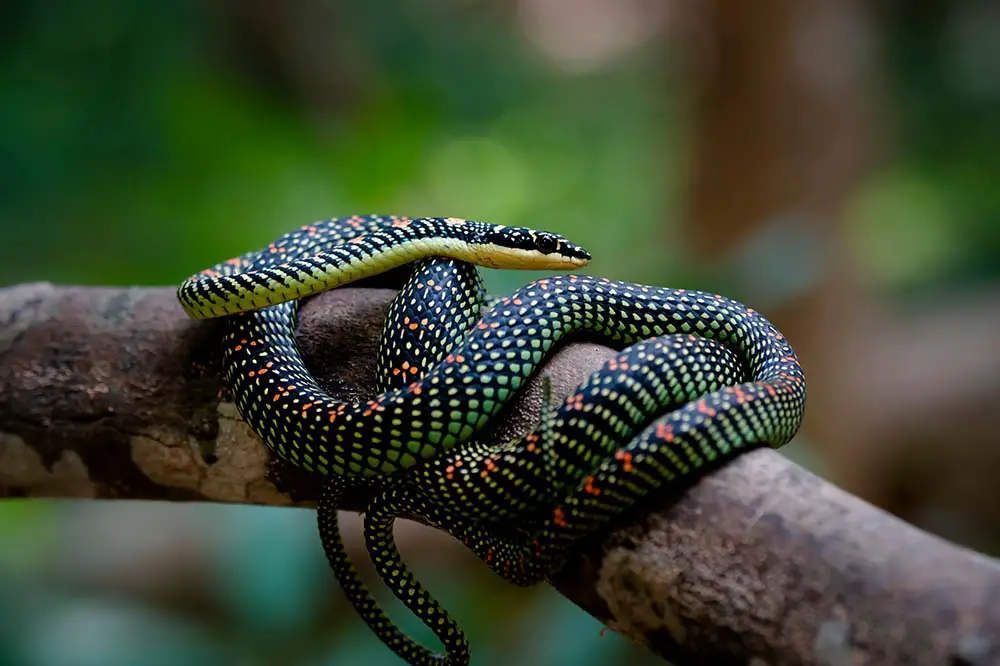
Left: Paradise tree snake or paradise flying snake | Nenad Preradovic / Shutterstock & Right: Flying snake hiding in the forest | Forrest9 / Shutterstock
72 – Golden tree snake/ornate flying snake | Chrysopelea ornata
The golden tree snake or ornate flying snake can reach up to around 1.3 meters or 2.7 feet and exists in two colour variations. The most common is found in Sri Lanka and is a green-yellow colour. The second is found in Southeast Asia and is black with red and white highlights.
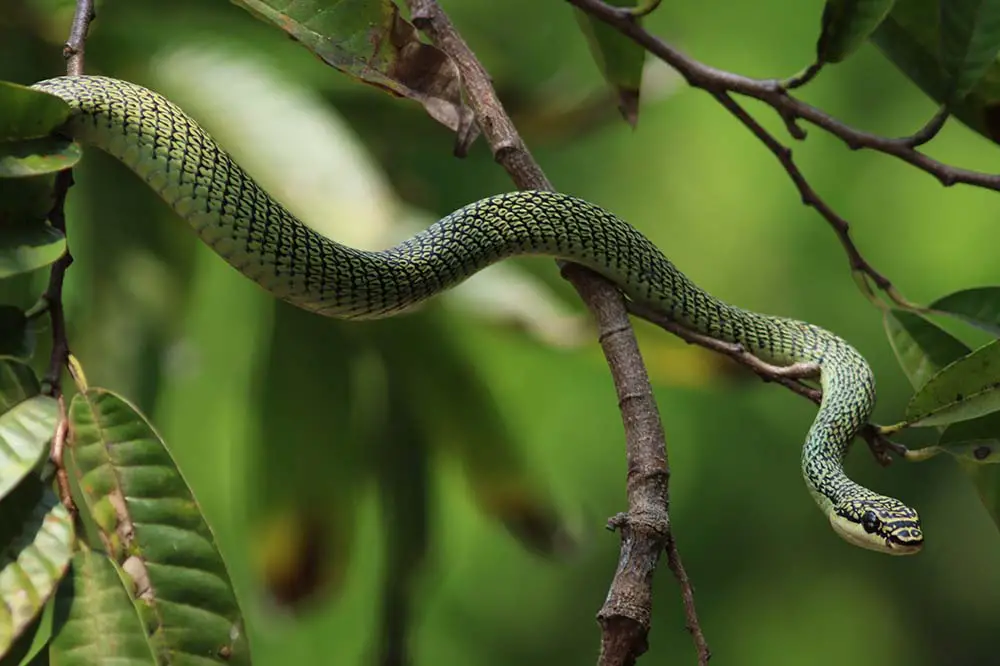

Left: Close up of a golden tree snake or ornate flying snake | Polbkt / Shutterstock & Right: Golden tree snake or ornate flying snake | Polbkt / Shutterstock
73 – Common bronzeback | Dendrelaphis tristis
Although bronzeback snakes prefer the tops of trees, unfortunately for them they cannot fly. However, they make up for this lack of aerial finesse by being particularly elegant. They prey upon geckos, birds and occasionally frogs.


Left: Common bronzeback | Pratimaan / Shutterstock & Right: A bronzeback on a palm leaf in Maharashtra, India | RealityImages / Shutterstock
74 – Beautiful bronzeback tree snake | Dendrelaphis formosus
The beautiful bronzeback tree snake is just that, exhibiting a bright green belly and a darker back. They prefer lowland forests at elevations of no more than 600 meters or 2,000 feet and are found from southern Thailand to the Indonesian archipelago.


Left: Beautiful bronzeback tree snake | Ewil Zulfie / Shutterstock & Right: Beautiful bronzeback tree snake on a flower | Thousandlies / Shutterstock
Subfamily: Colubrinae
Colubrinae is the second-largest subfamily of typical snakes., containing around 93 genera and over 700 species, depending on the source. It contains many well-known groups of snakes such as kingsnakes, vine snakes and rat snakes.
75 – Mangrove snake | Boiga dendrophila
The mangrove snake is one of the largest snakes in the Boiga genus, more commonly known as catsnakes. They are venomous and display a very dangerous looking black and yellow striped skin, although no human fatalities have ever been recorded.

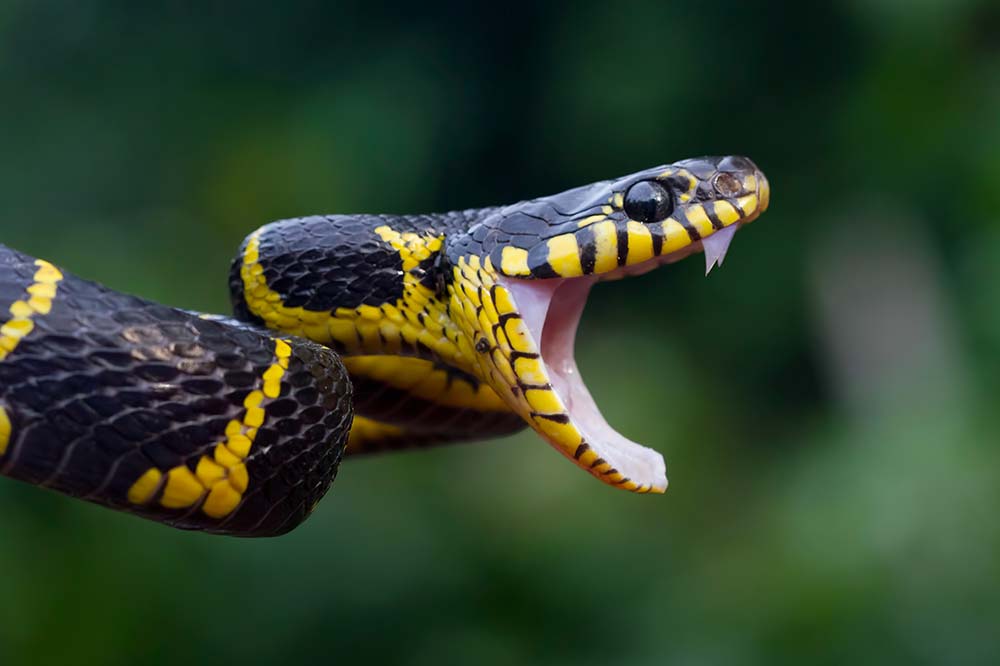
Left: A yellow and black mangrove snake | Opayaza12 / Shutterstock & Right: Mangrove snake or boiga | Kurit Afshen / Shutterstock
76 – Red milk snake | Lampropeltis triangulum syspila
The red milk snake is a non-venomous kingsnake found in the southeastern United States. Their skin displays black-lined red blotches over a white or a beautiful dark grey background. They prey on small mammals and reptiles, which they kill by constriction.


Left: Red milk snake | Psychotic Nature / Shutterstock & Right: A coiled up red milk snake | Psychotic Nature / Shutterstock
77 – Honduran milk snake | Lampropeltis triangulum hondurensis
The Honduran milk snake is another kingsnake that is a very popular pet. They are usually found in a deep red and black but also have an albino form that sees white areas that would usually be black and some of the red areas in a yellow-orange.
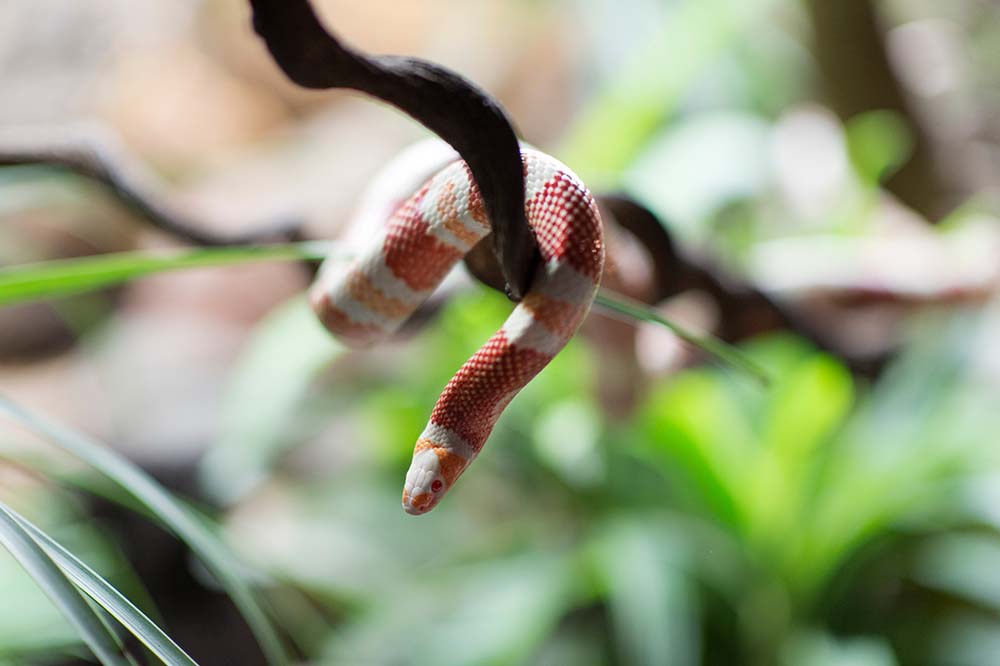

Left: Albino tangerine Honduran milk snake | LR Photo / Shutterstock & Right: Honduran milk snake | reptiles4all / Shutterstock
78 – Green vine snake | Oxybelis fulgidus
Green vine snakes are similar in appearance to the vine snakes previously discussed but are from a completely different family and found in Central and South America. They are around 2 cm or 0.8 inches thick and can grow up to 2 meters or 80 inches long.
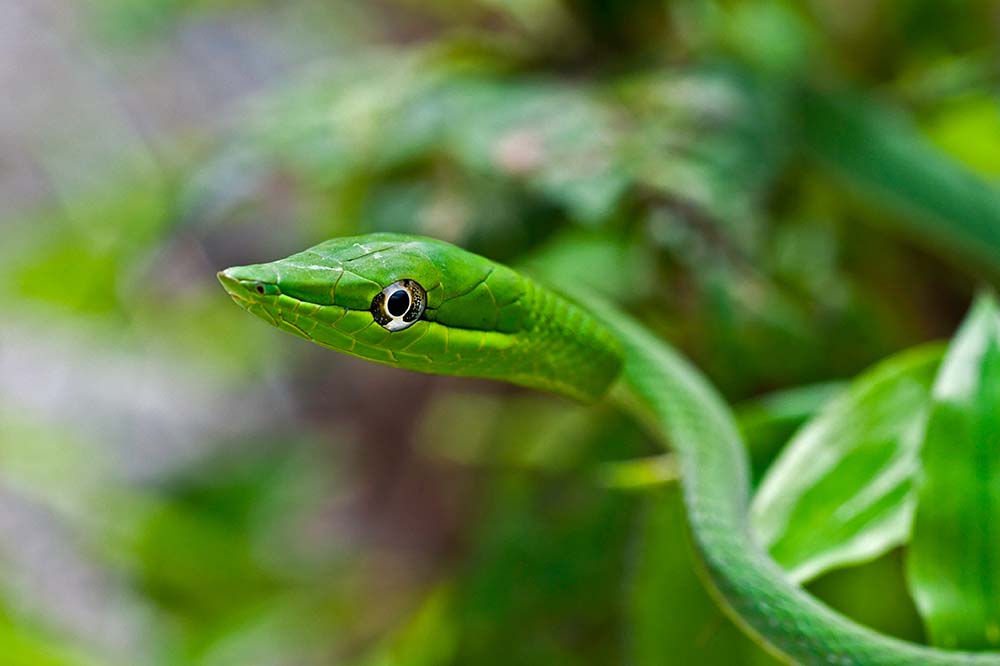

Left: Green vine snake | Klaus Mohr / Shutterstock & Right: Oxybelis fulgidus commonly known as the green vine snake | guentermanaus / Shutterstock
79 – Mexican vine snake | Oxybelis aeneus
The Mexican vine snake is found as far north as Arizona and as far south as northern South America. Instead of an all green body, they exhibit a white belly and a brown back, which presumably, is a more suitable camouflage for its environment.
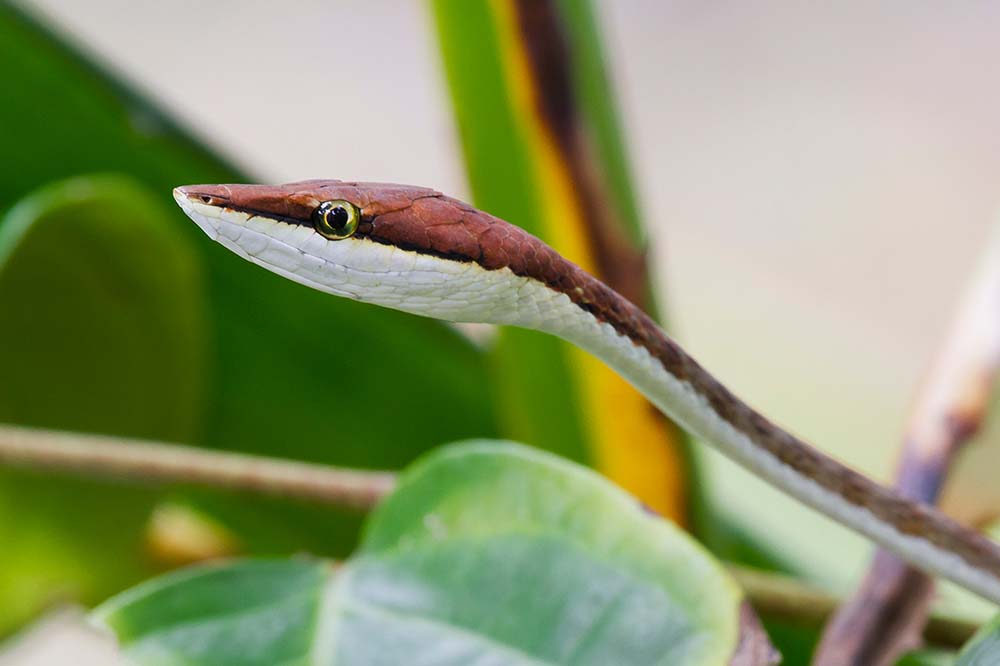

Left: A brown vine snake up close in Tortuguero National Park, Costa Rica | Kevin Wells Photography / Shutterstock & Right: Mexican vine snake or brown vine snake | Stefan Warwas / Shutterstock
80 – Eastern indigo snake | Drymarchon couperi
The eastern indigo snake is the longest native snake species in North America, measuring up to 2.4 meters or 7.7 feet. The Latin name of its genus, Drymarchon, means “Lord of the forest”.

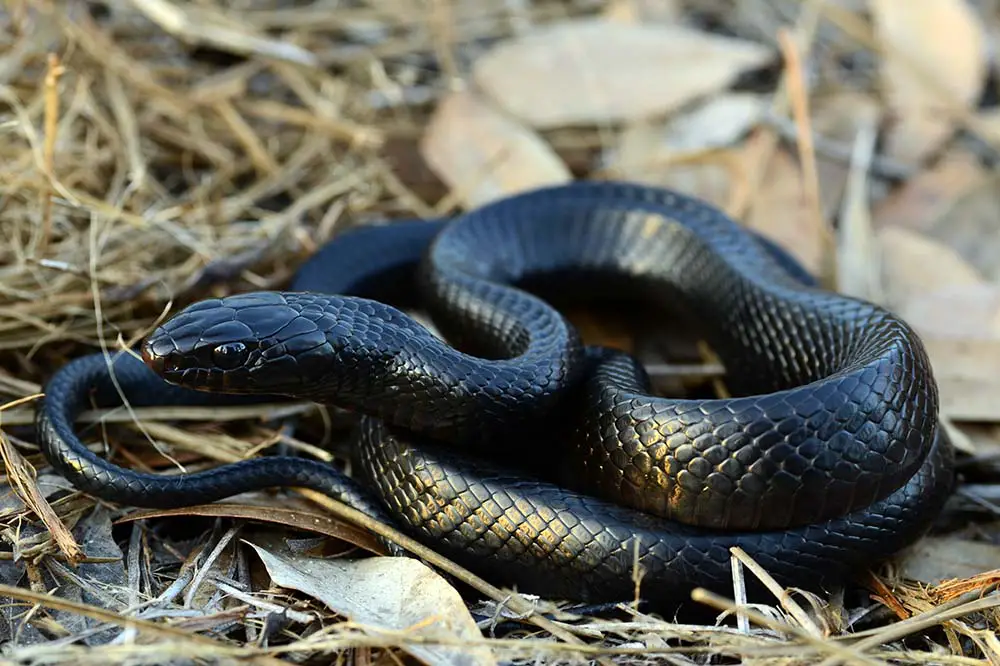
Left: Eastern indigo snake | Patrick K. Campbell / Shutterstock & Right: A coiled up eastern indigo snake | Patrick K. Campbell / Shutterstock
Group: Rat snakes
The Colubrinae subfamily contains a group of snakes spread across many genera that are collectively known as rat snakes. They are medium to large-sized snakes who feed on rodents and are split into two groups; old world rat snakes, who are found in Africa and Eurasia and new world rat snakes, found in the Americas.
81 – Red-tailed green rat snake | Gonyosoma oxycephalum
The red-tailed green rat snake is the first of 5 old world rat snakes we’ll take a look at. The average lifespan of this snake is a whopping 20 years and although they are named as such, their tail is usually a grey colour rather than red.
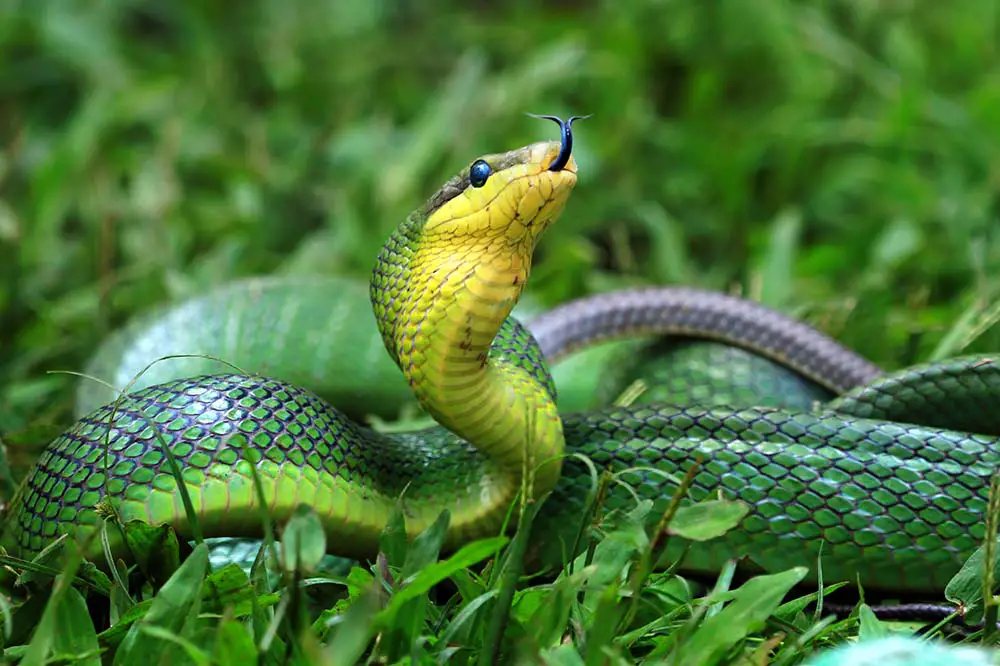

Left: Green gonyosoma snake | Kurit afshen / Shutterstock & Right: A green rat snake I Wayan Sumatika / Shutterstock
82 – Japanese rat snake | Elaphe climacophora
The Japanese rat snake is found on the island nation of Japan where they are known colloquially as the “blue general”. They eat many small animals including rodents, lizards and frogs and are preyed upon by the eagle and the Japanese racoon dog or tanuki.
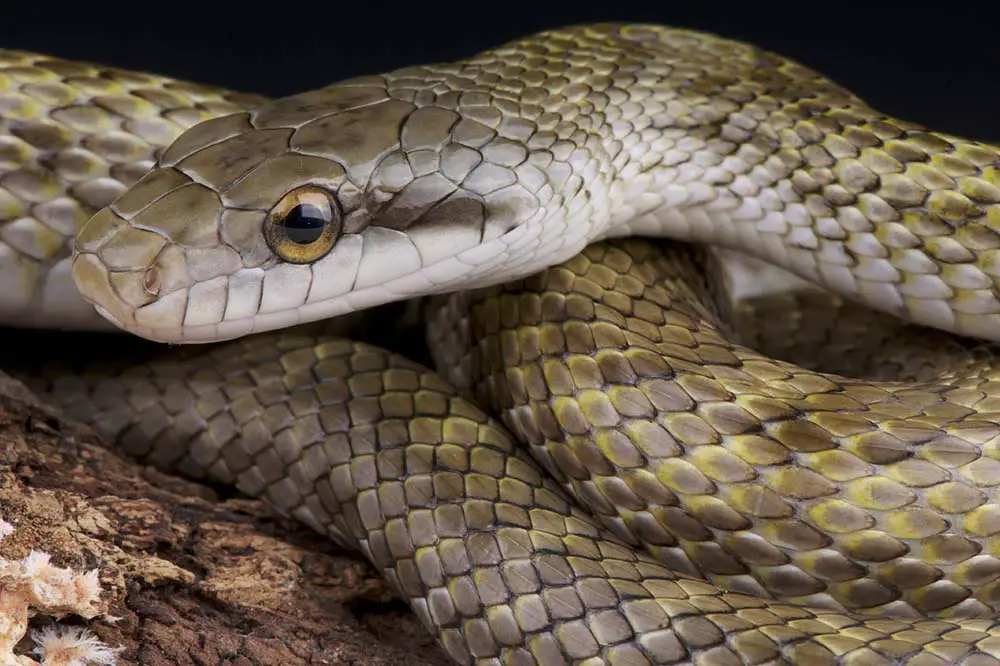

Left: Japanese rat snake portrait shot | reptiles4all / Shutterstock & Right: A Japanese rat snake on the forest floor | High Mountain / Shutterstock
83 – Black copper rat snake | Coelognathus flavolineatus
The black copper rat snake is one of the most colourful species of rat snake, displaying a complex pattern of white, green, black and yellow. They are mostly found in Southeast Asia but exist as far west as India too.


Left: Black copper rat snake | aDam Wildlife / Shutterstock & Right: Black copper rat snake aka yellow striped snake | aDam Wildlife / Shutterstock
84 – Radiated ratsnake | Coelognathus radiatus
The radiated rat snake, also known as the copper-headed trinket snake, is another particularly colourful rat snake. They are very defensive and although they are non-venomous, will strike easily if provoked.


Left: Copper-headed trinket snake ready to attack & Right Copper-headed trinket snake ready to attack | Kurit Afshen / Shutterstock
85 – Rhinoceros rat snake | Gonyosoma boulengeri
The rhinoceros rat snake is the last old world rat snake that we’ll discuss and easily the most unique. They are found in the subtropical rainforests of northern Vietnam and China and have a scaly protuberance on the tip of their snout, the function of which is unknown.
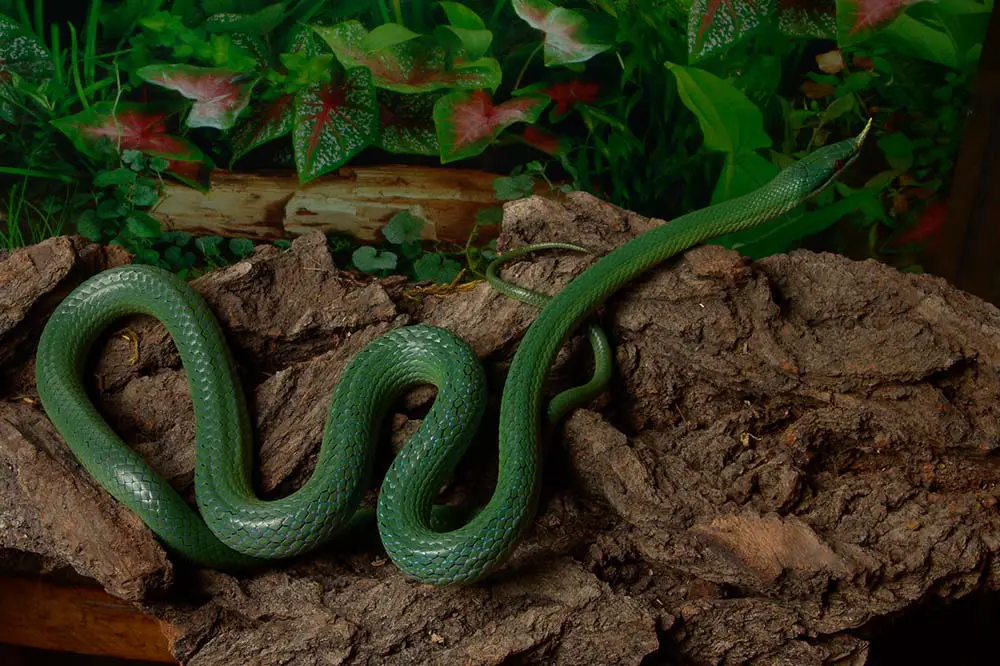
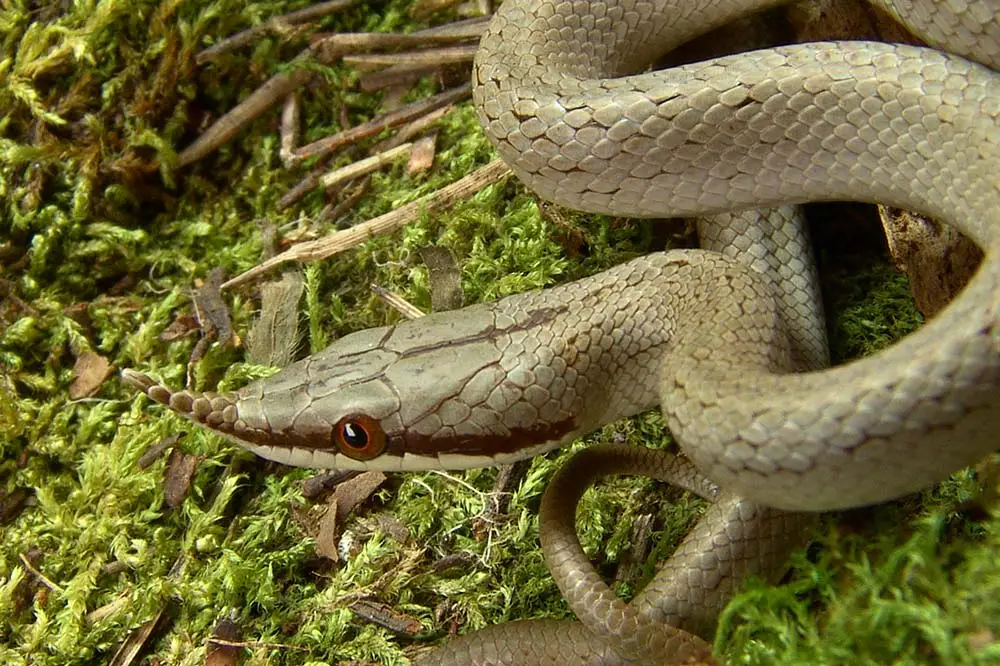
Left: A rhinoceros rat snake & Right: A rhinoceros rat snake coiled on a mossy bed | skifbook / Shutterstock
86 – Great plains rat snake | Pantherophis emoryi
The Great plains rat snake is a species of new world rat snake found in the grasslands, forests and semi-arid regions of the United States and Mexico. They survive primarily on rodents and sometimes chickens and can often be found next to farmland.
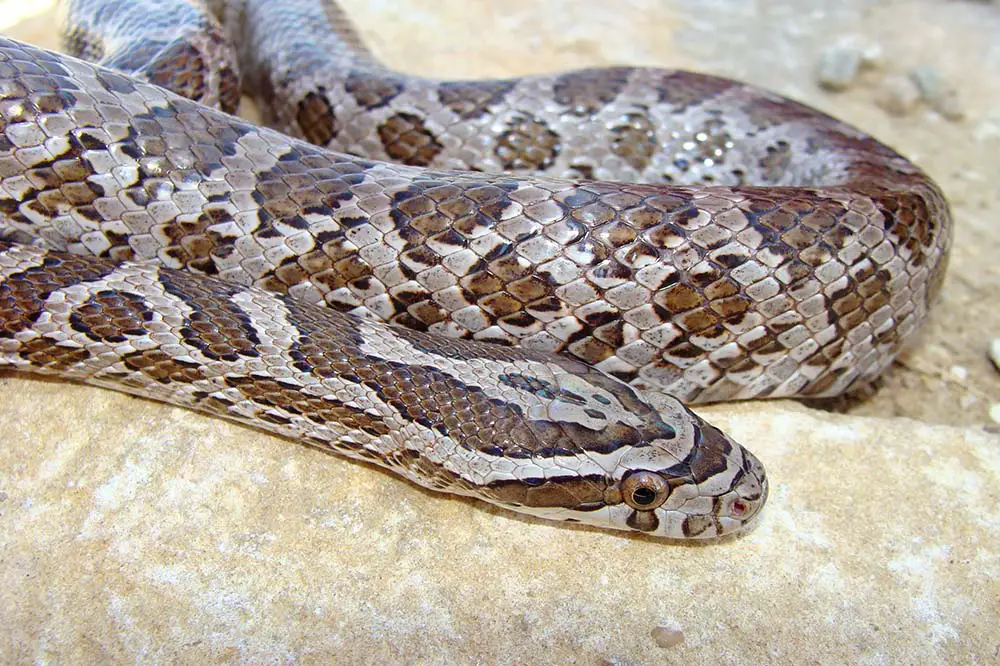

Left: Great plains rat snake | Matt Jeppson / Shutterstock & Right: A great plains rat snake in the grass | The Jungle Explorer / Shutterstock
87 – Corn snake | Pantherophis guttatus
The corn snake is one of the most well-known snakes in the United States and is often mistaken for the highly venomous copperhead. Their skin is a spectacular mix of reds, oranges and whites and, like the Honduran milk snake, look particularly captivating in their albino form.


Left: Beautiful corn snake close-up | Enrique Ramos / Shutterstock & Right: An albino corn snake portrait | TKBackyard / Shutterstock
88 – Western rat snake | Pantherophis obsoleta
The western rat snake is somewhat unremarkable on its own but one of its subspecies, the Texas rat snake is extremely popular as it can be subject to leucism, producing an entirely white, non-venomous snake, which many consider the perfect pet.
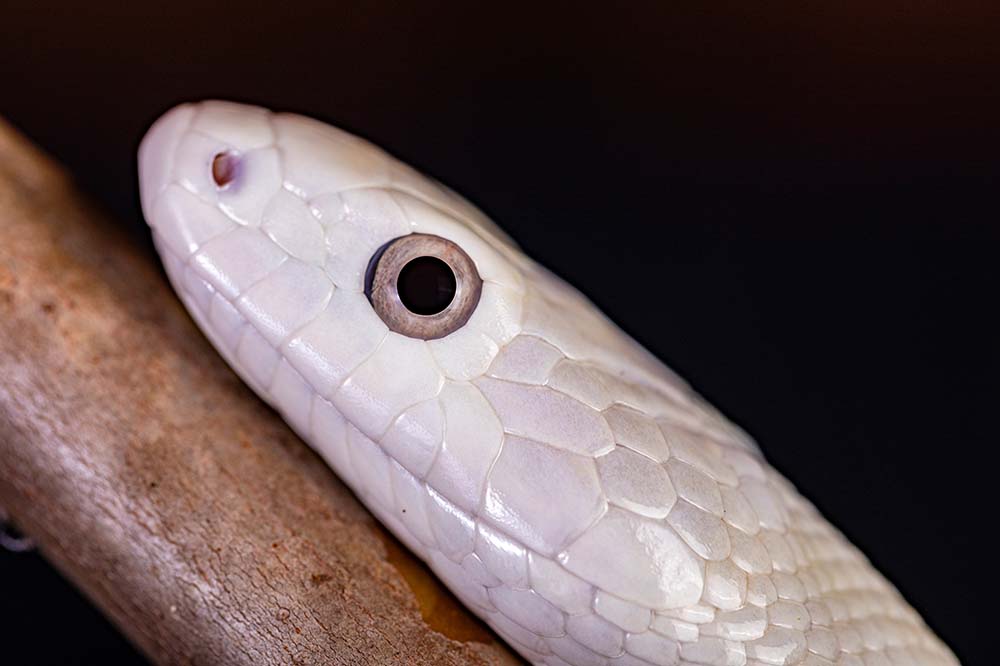
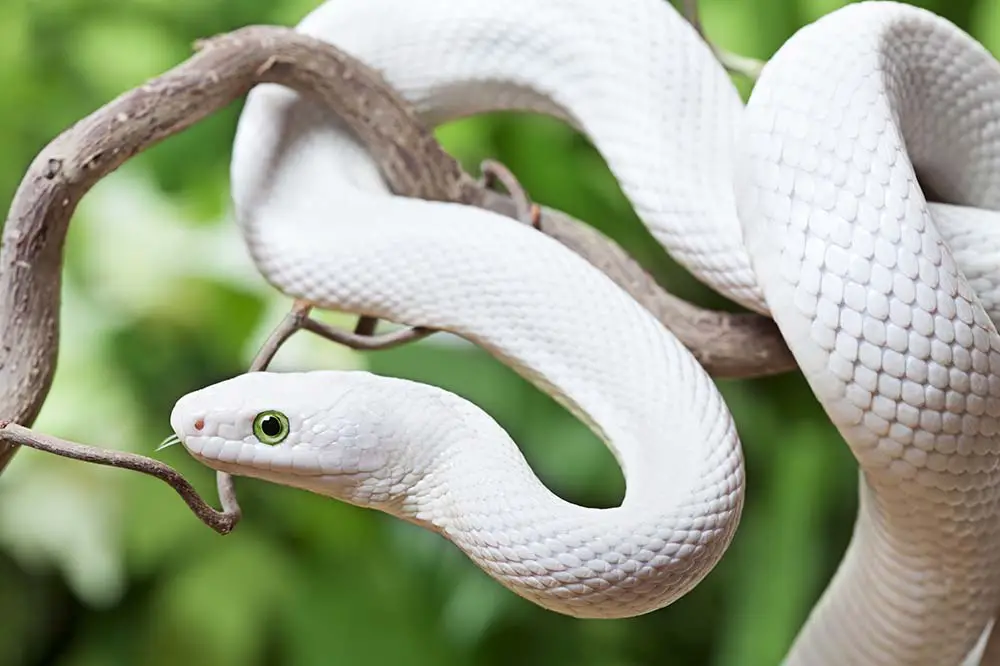
Left: Portrait of a Texas rat snake | Murilo Mazzo / Shutterstock & Right: Texas rat snake creeping on a wooden branch | Kuznetsov Alexey / Shutterstock
89 – Eastern rat snake | Pantherophis alleghaniensis
Much like its western counterpart, the eastern rat snake would likely not have made this list if it were not for the yellow rat snake, one of its most colourful subspecies. They are found throughout much of the southeastern United States.
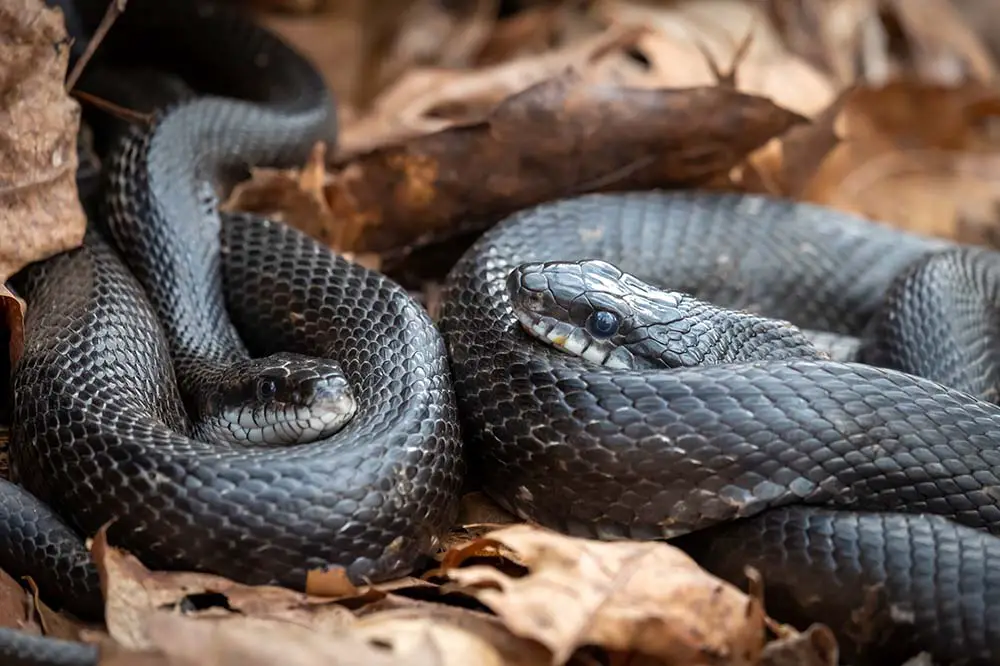
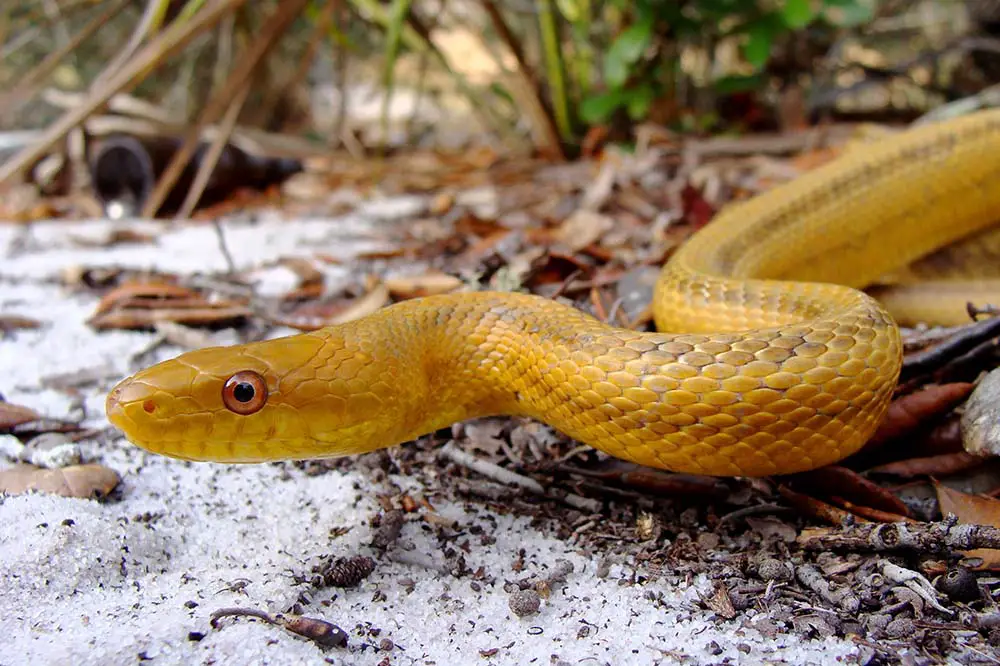
Left: A pair of eastern rat snakes snuggle during the spring season in Raleigh, North Carolina | Samray / Shutterstock & Right: Portrait shot of a yellow rat snake in the southeastern United States | Matt Jeppson / Shutterstock
Remaining families
It may surprise you to know that the 89 species that we’ve discussed so far come from just 6 families of snakes. The remaining 11 species that we’ll discuss come from 9 of the remaining 12 families and feature some of the oddest looking creatures on this list including the infamous blind snake.
90 – Aurora house snake | Lamprophis aurora
The aurora house snake is endemic to Southern Africa where it enjoys grassland ecosystems such as the savanna. They vary in colour from dark green to a lighter yellowish-olive colour but all have a single orange stripe that runs down the centre of their back.
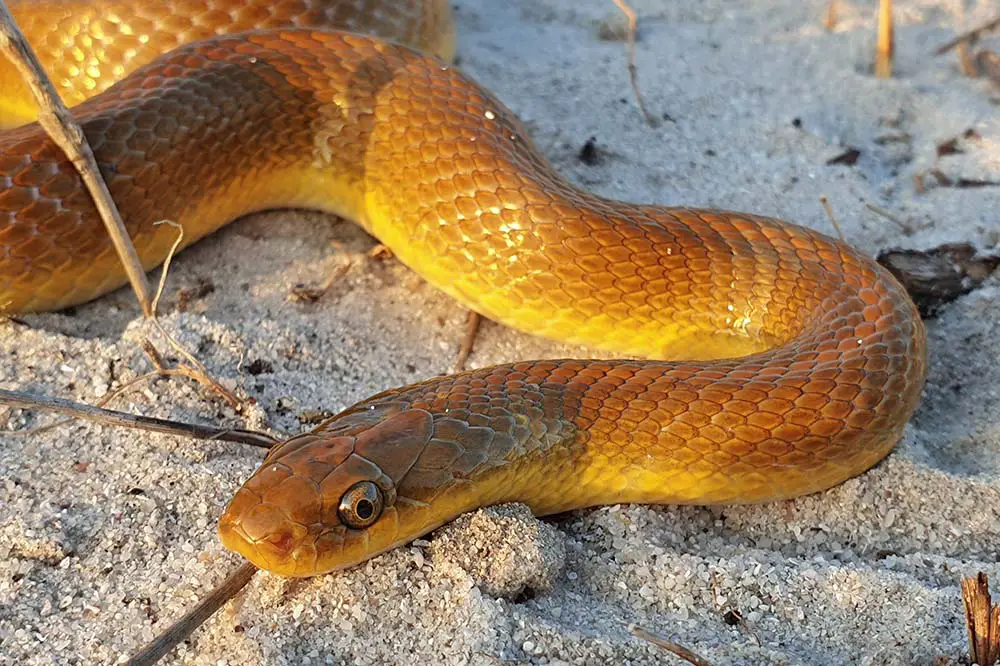

Left: A yellow aurora house snake | Willem Van Zyl / Shutterstock & Right: A green aurora house snake photographed in Cape Town, South Africa | Craig Campbell / Shutterstock
91 – Madagascar leaf-nosed snake | Langaha madagascariensis
The Madagascar leaf-nosed snake is a very unique species that camouflages extremely effectively into its environment. They vary in colour and their leaf-shaped snout is used in combination with the tone of their skin to blend into the branches of trees.


Left: Madagascar or Malagasy leaf-nosed snake | Ryan M. Bolton / Shutterstock & Right: Madagascar leaf-nosed snake | Danny Ye / Shutterstock
92 – Bibron’s burrowing asp | Atractaspis bibronii
The Bibron’s burrowing asp, also known as the stiletto snake, is a species of venomous snake found in Africa. They are relatively small, measuring no more than 55 cm or 22 inches in length and are known to hunt burrowing reptiles in old termite mounds.

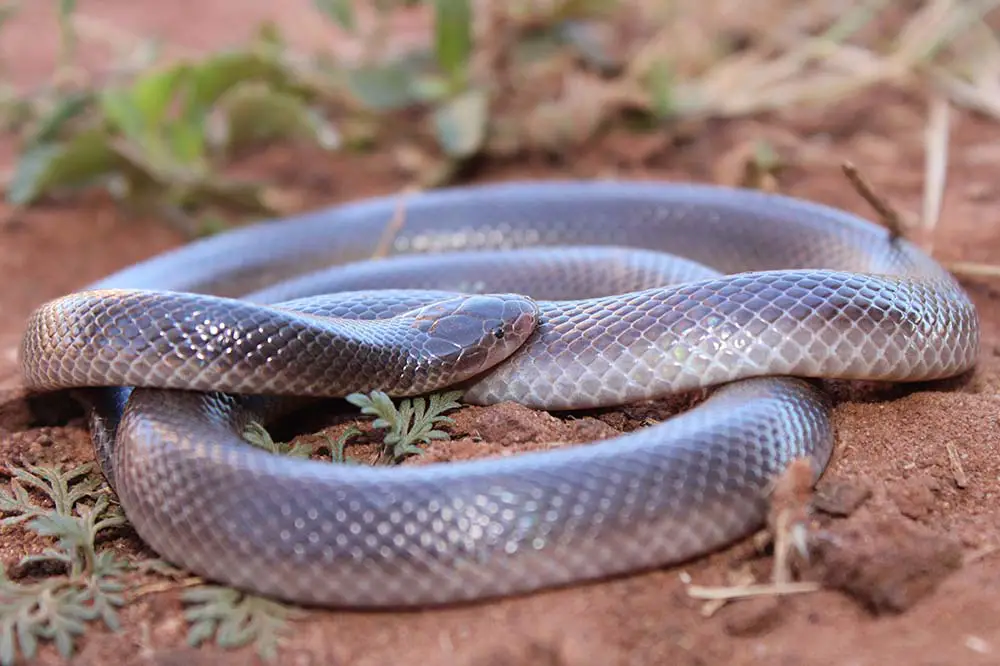
Left: A coiled up stiletto snake | Cormac Price / Shutterstock & Right: Bibron’s stiletto snake portrait | Eugene Troskie / Shutterstock
93 – Tentacled snake | Erpeton tentaculatum
The tentacled snake is the only species of snake to display two tentacles protruding from its snout. These tentacles have been shown to have mechanosensory function, which provides the basis for the senses of light touch, hearing, proprioception, and pain.

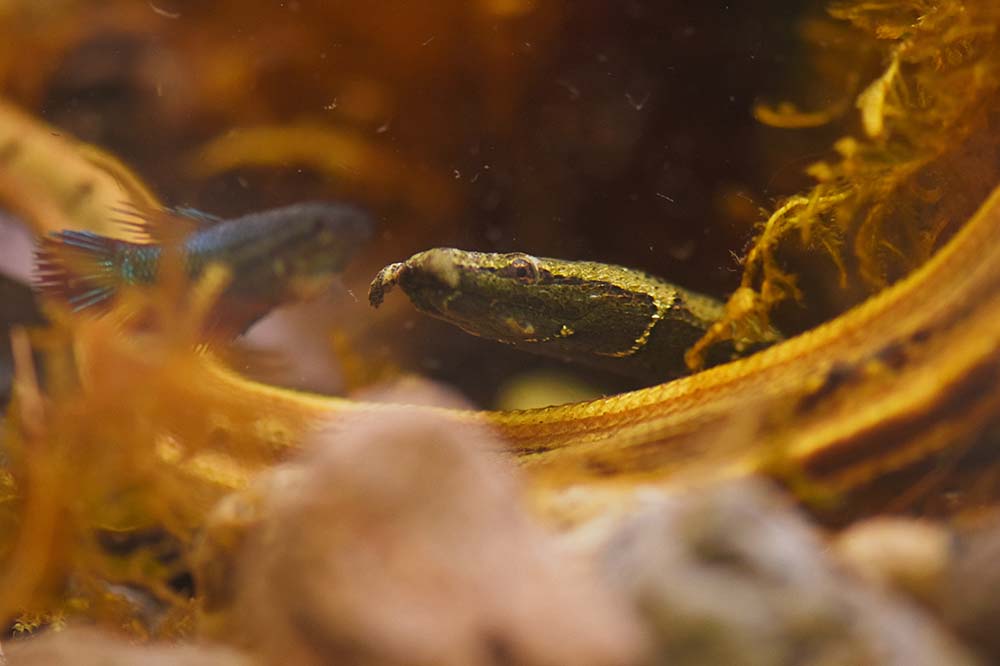
Left: Tentacled water snake under water | Keung / Shutterstock & Right: Tentacled water snake with the fishes | Keung / Shutterstock
94 – Bombay shieldtail | Uropeltis macrolepis
The Bombay shieldtail, also known as the Bombay earth snake, is a member of the Uropeltis family which derives from the Greek “ura” which means tail and “pelte” meaning shield. They are a non-venomous burrowing snake endemic to southern India.

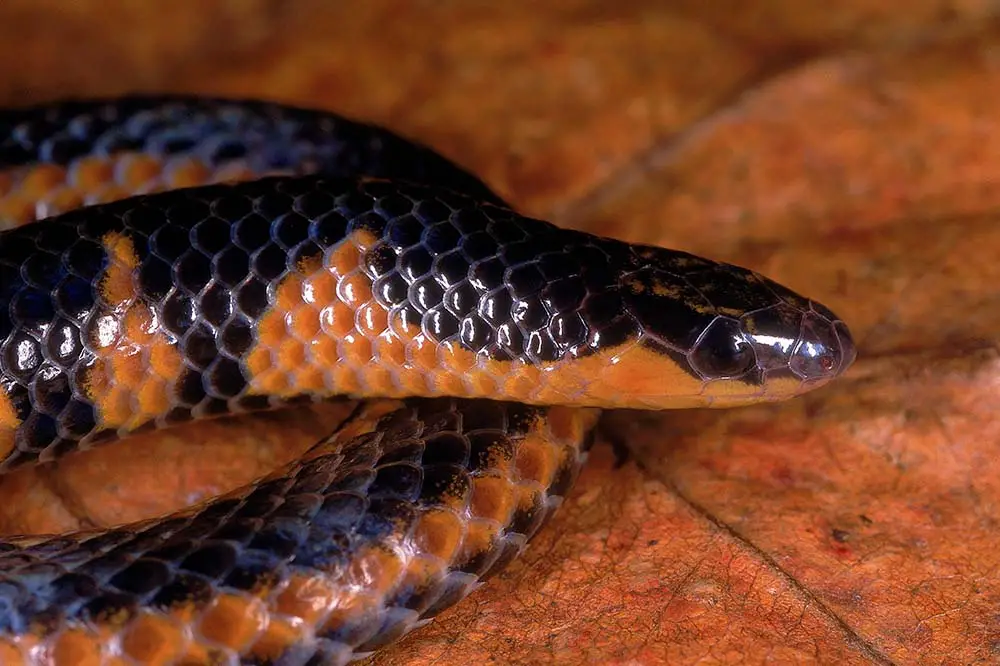
Left: Bombay shield tail | RealityImages / Shutterstock & Right: Portrait of a Bombay shield tail from Mahableshwar, Maharashtra, India | RealityImages / Shutterstock
95 – Keeled slug snake | Pareas carinatus
The keeled slug snake is a member of the Pareidae family, a group of snakes that were previously thought to be typical snakes. They are found in Southeast Asia, are arboreal, and feed exclusively on snails and slugs.

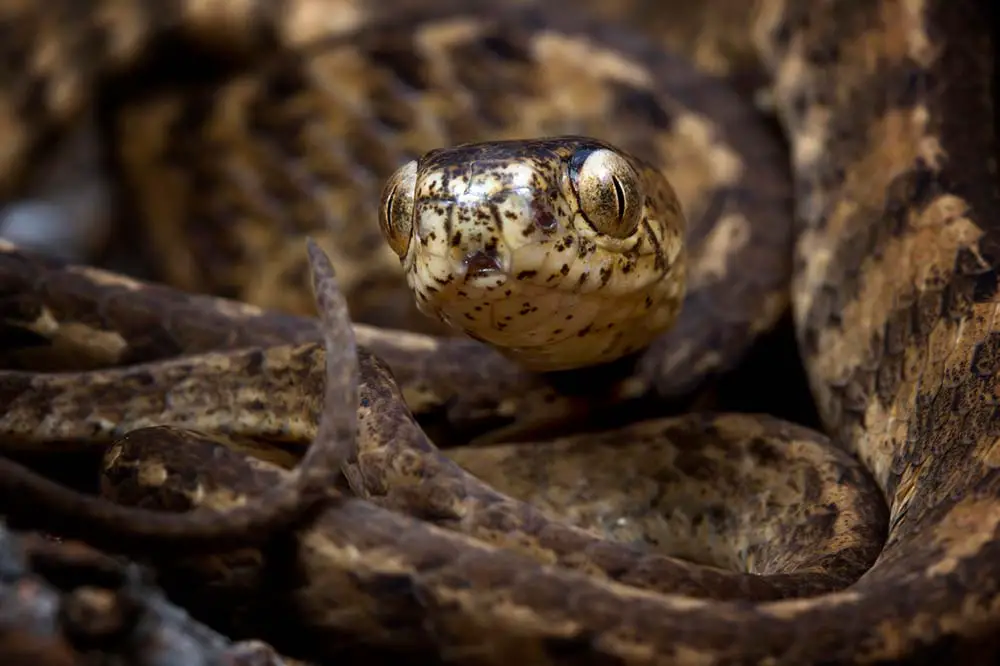
Left: A keeled slug snake closeup | Kurit afshen / Shutterstock & Right: Keeled slug snake portrait | Kurit afshen / Shutterstock
96 – Elephant trunk snake | Acrochordus javanicus
The elephant trunk snake is arguably the most adorable snake on this entire list! They have a very unique scale pattern and loose baggy skin, hence the comparison to an elephant’s trunk. They are found mostly in rivers, estuaries and lagoons where they prey on fish and amphibians.

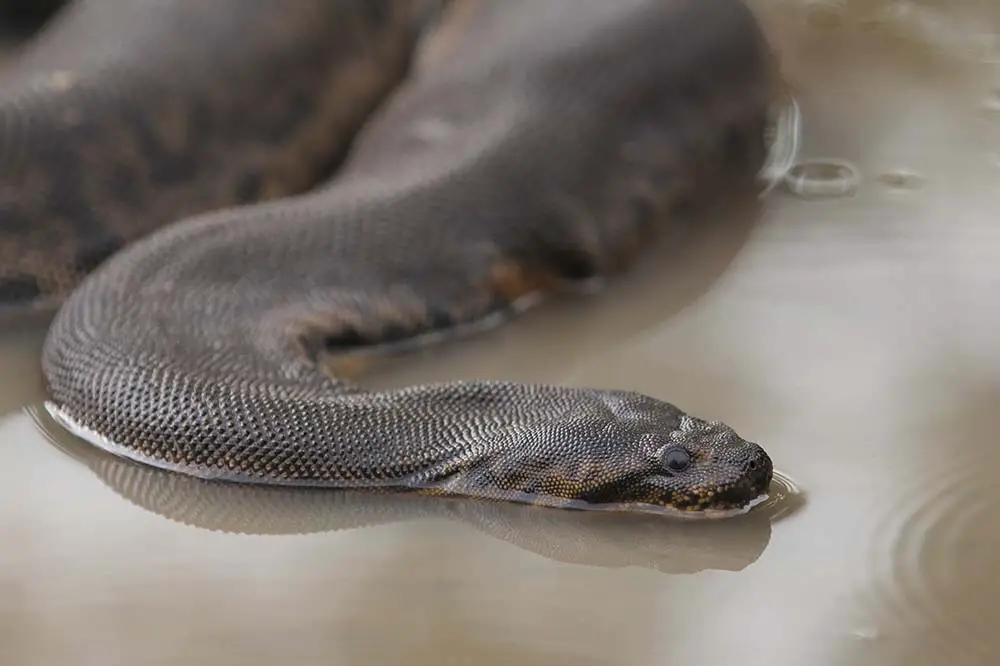
Left: A cute elephant trunk snake | reptiles4all / Shutterstock & Right: An elephant trunk snake aka the Javan file snake | Mufti Adi Utomo / Shutterstock
97 – Red-tailed pipe snake | Cylindrophis ruffus
The red-tailed pipe snake is a colourful snake from Southeast Asia that prey upon other cylindrical animals such as eels. They grow up to roughly 1 meter or 39 inches in length and can be a range of colours from black and white to blue and white but always with a red tip on their tail.
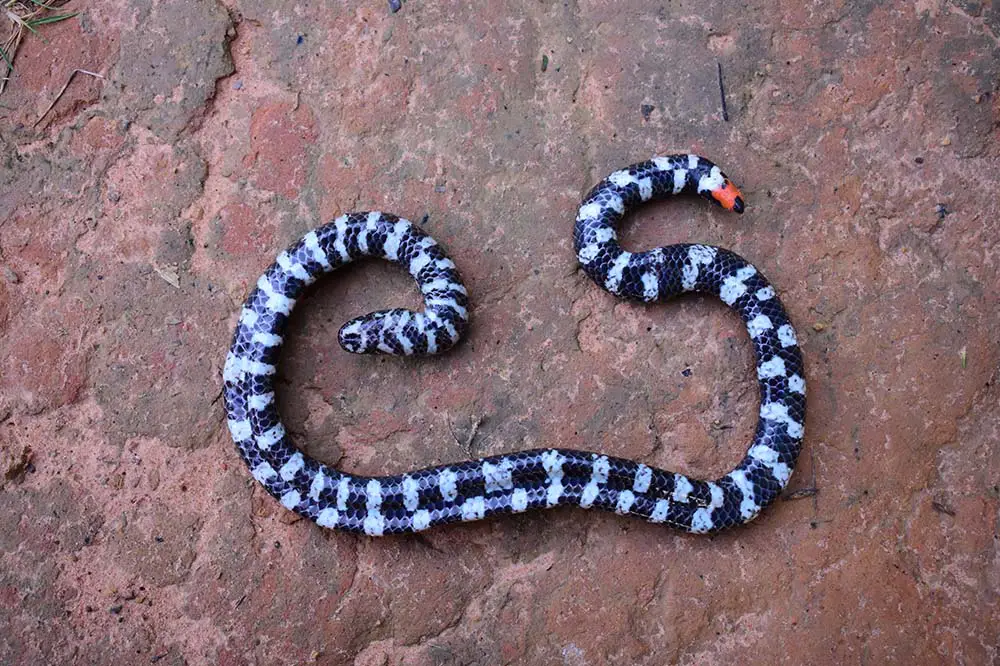
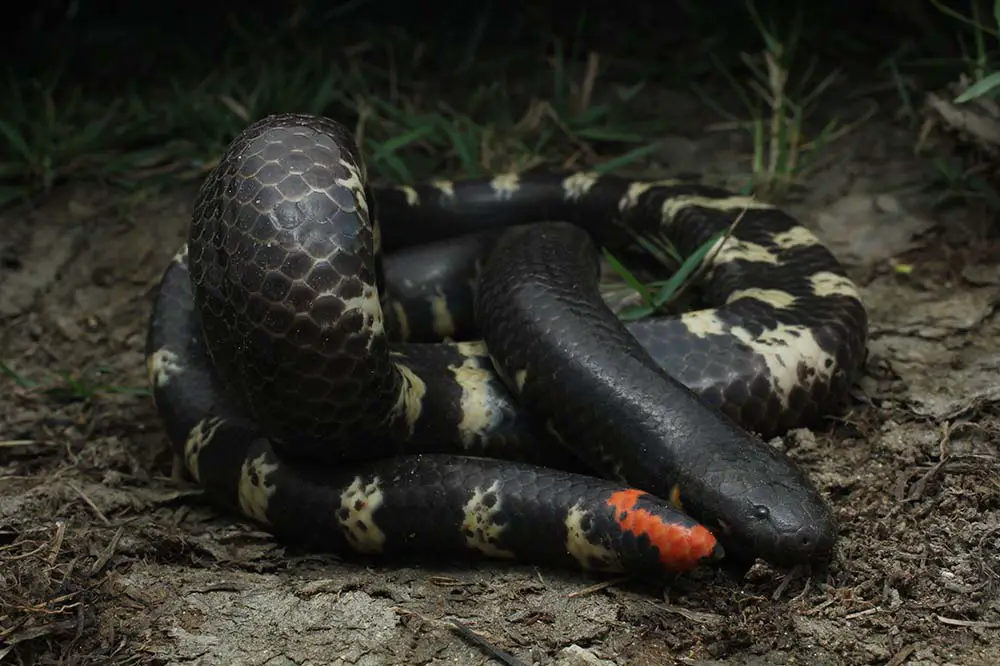
Left: A beautiful blue and black red-tailed pipe snake | KritsadaPetchuay / Shutterstock & Right: A coiled up red tail pipe snake | Potray / Shutterstock
98 – Sunbeam snake | Xenopeltis unicolor
Like the rainbow boa, sunbeam snakes possess iridescent scales, giving them a rainbow-like sheen in certain light. They are a type of burrowing snake, spending most of their time in the ground and, like rattlesnakes, will also vibrate their tails if provoked.
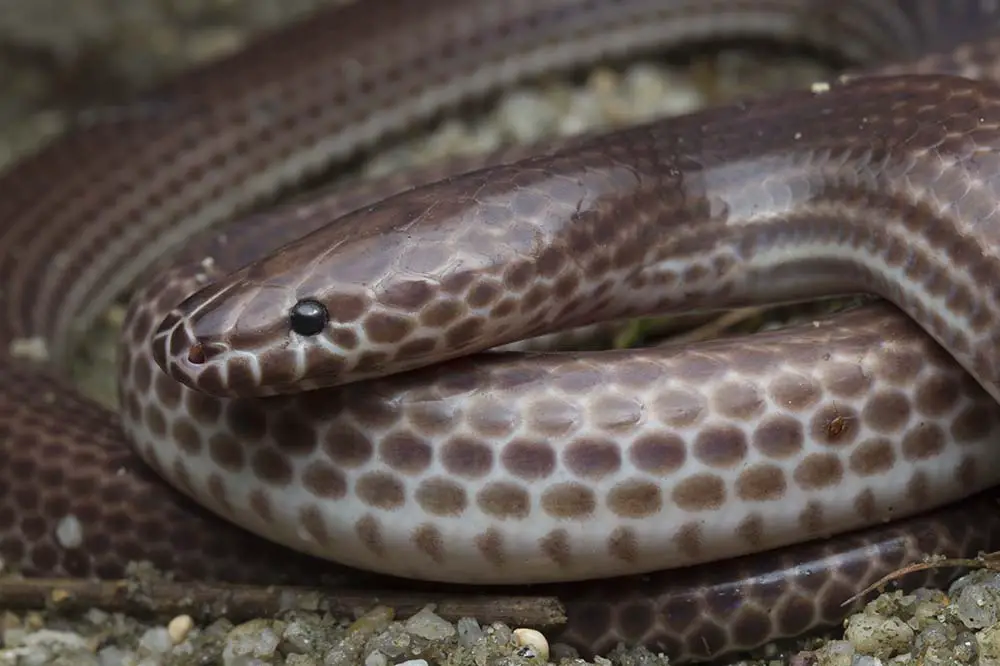

Left: Sunbeam snake | Vince Adam / Shutterstock & Right: A sunbeam snake with its rainbow sheen | Teetawach Promtong / Shutterstock
99 – Beaked worm snake | Grypotyphlops acutus
The beaked worm snake is part of a group of 5 families known as blind snakes. They are tiny creatures with a maximum total length of around 6 cm or just under 3 inches and also spend most of their time underground. This particular species is found in India.
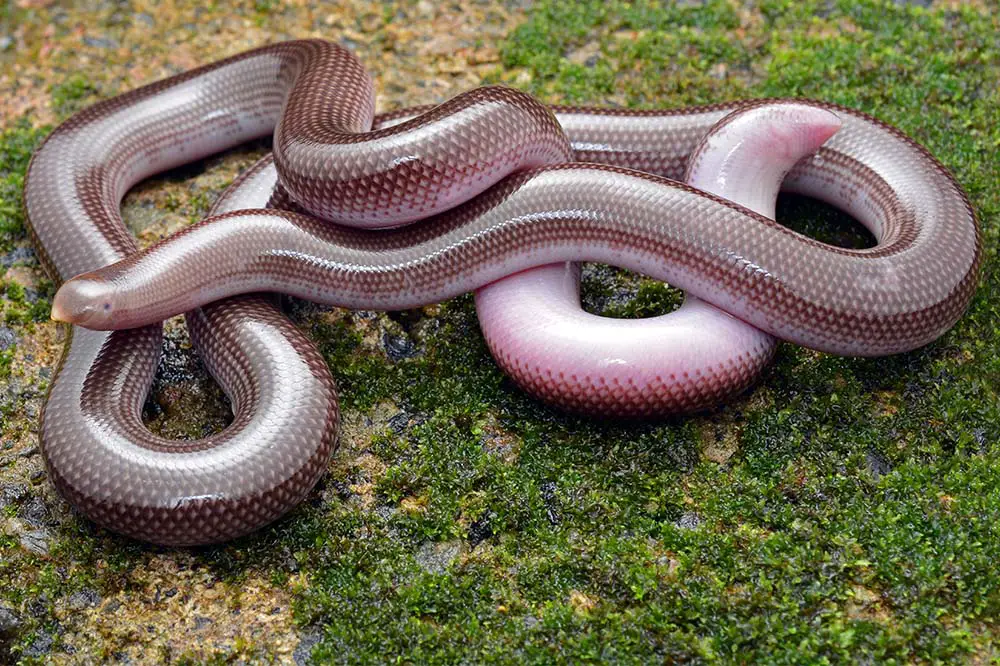
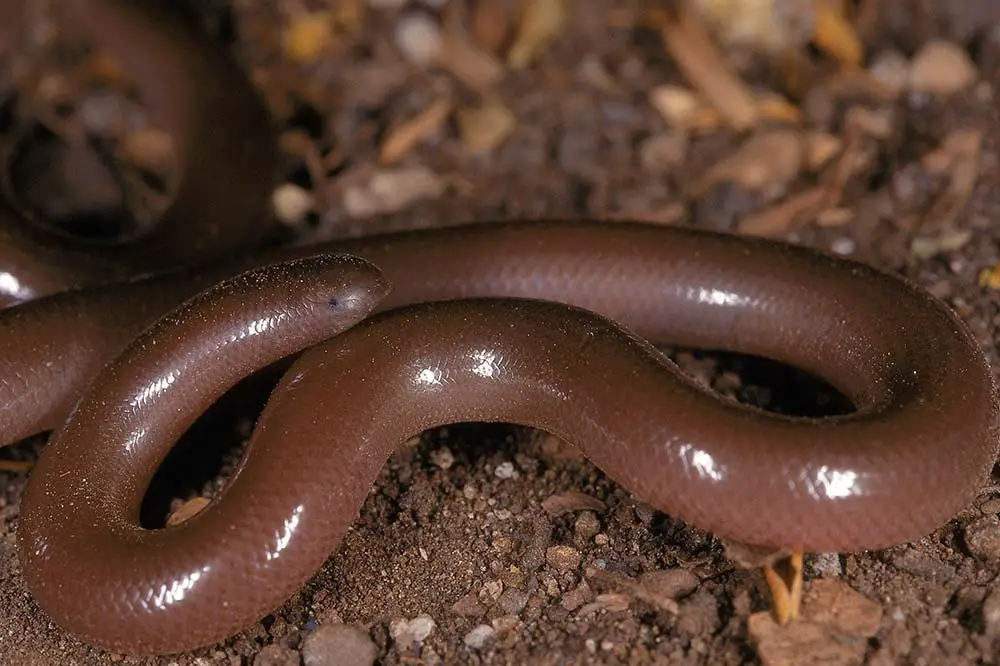
Left: A colourful beaked worm snake | Umesh Pavukandy / Shutterstock & Right: A tiny beaked worm snake | RealityImages / Shutterstock
100 – Brahminy blind snake | Indotyphlops braminus
The brahminy blind snake is one of the most well-known blind snakes and is often mistaken for an earthworm. They are even smaller than the beaked worm snake and are known to be the smallest snake species on earth.


Left: Portrait of a Brahminy blind snake | Radiant Reptilia / Shutterstock & Right: Brahminy blind snake on a leaf | Muhamad mizan bin ngateni / Shutterstock
Sources
Largest snakes in the world, Smallest snakes in the world, Most venomous snakes in the world, Wikipedia, Dwarf boas, Blue-eyed leucistic ball python, Butter ball python, Snake infrared detection, Why eyelash pitvipers have eyelashes, Desert horned viper’s horns, Why the King Cobra genus monotypic, The effects of cytotoxins, Burrowing snakes, MacClelland’s coral snake, Tschudi’s false coral snake subspecies, Clouded snake, Texas rat snake colouration, Rhinoceros rat snake, Bombay earth snake.
